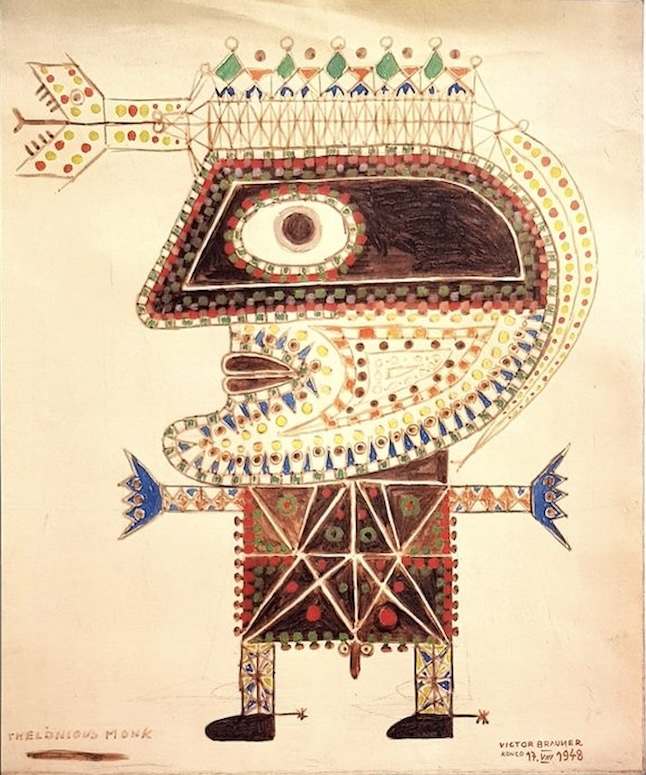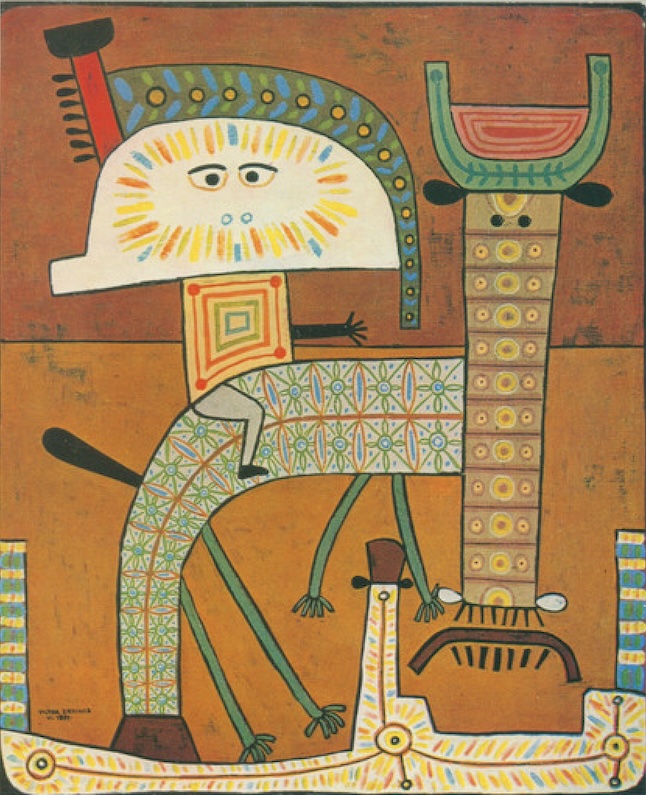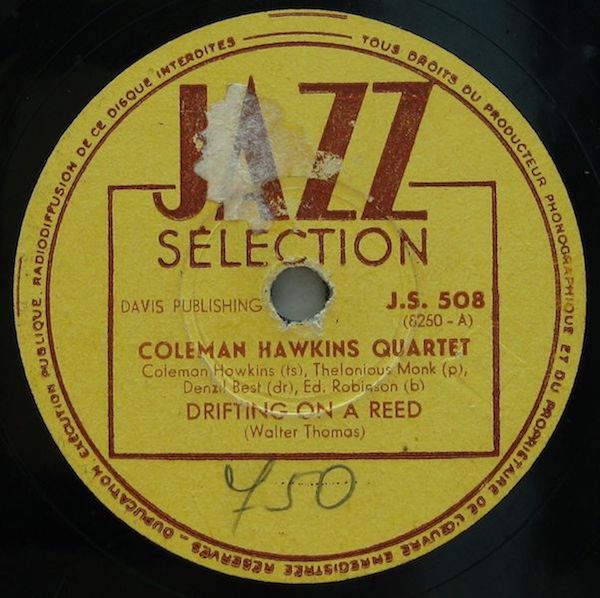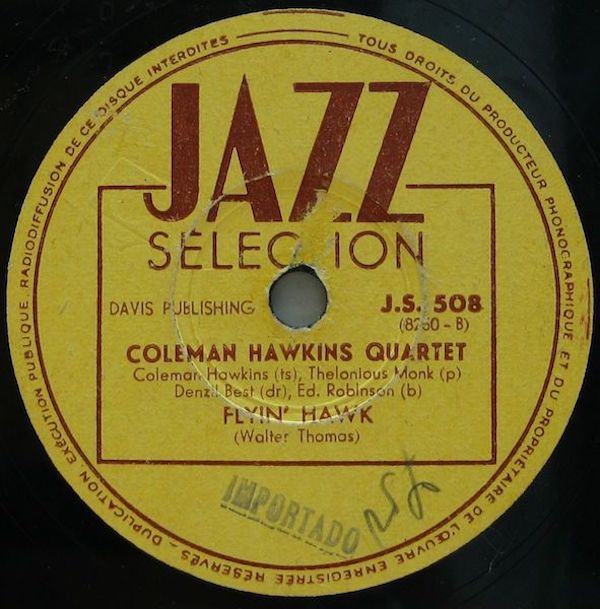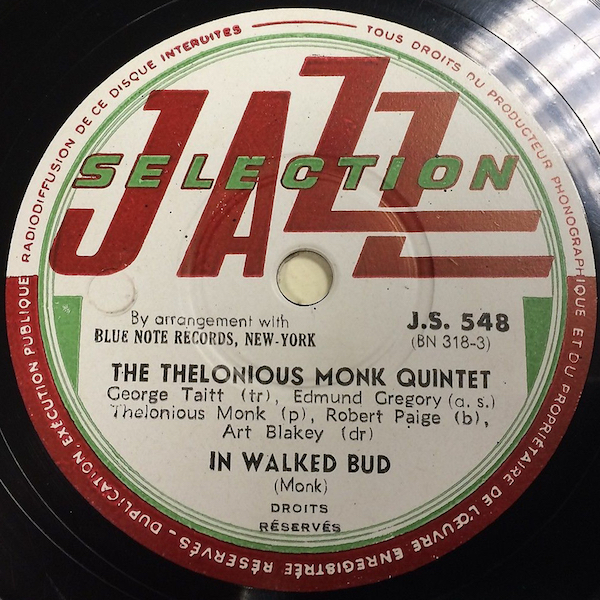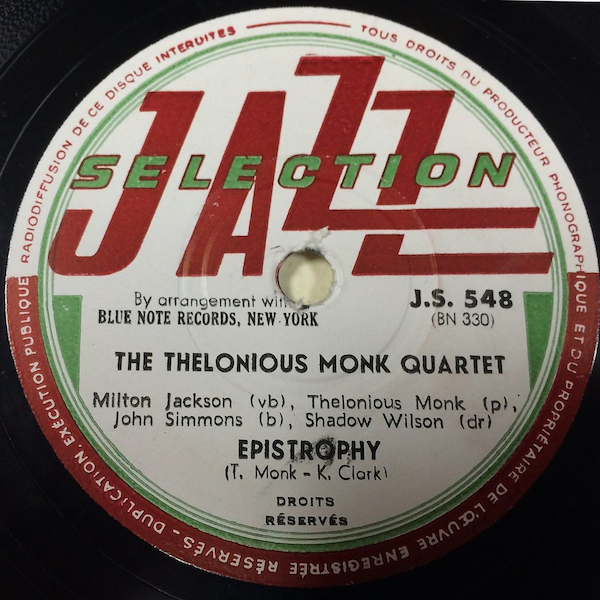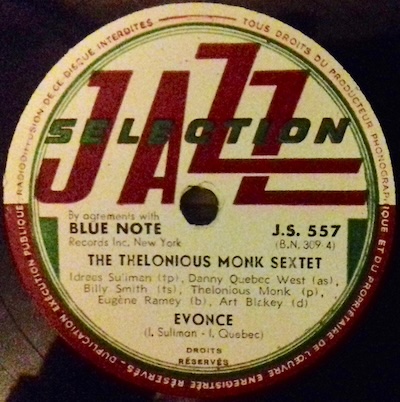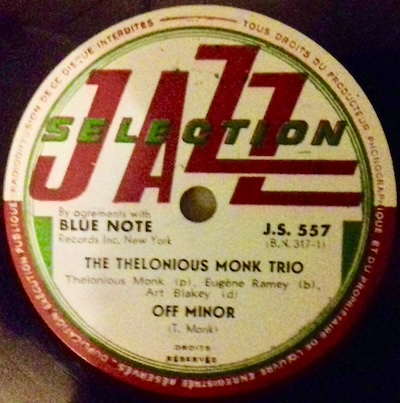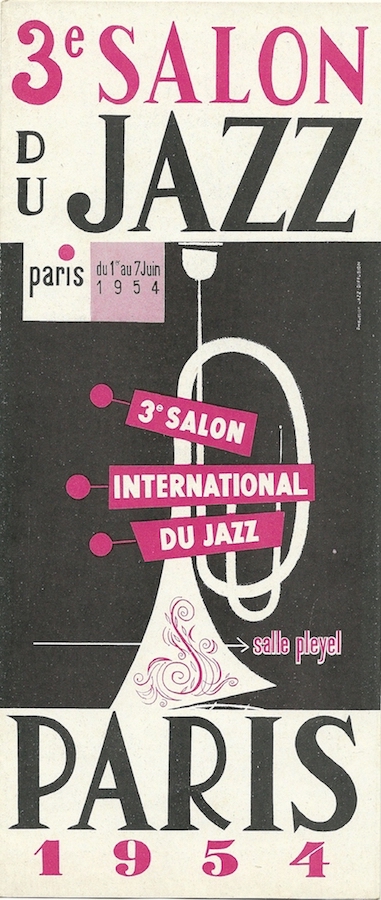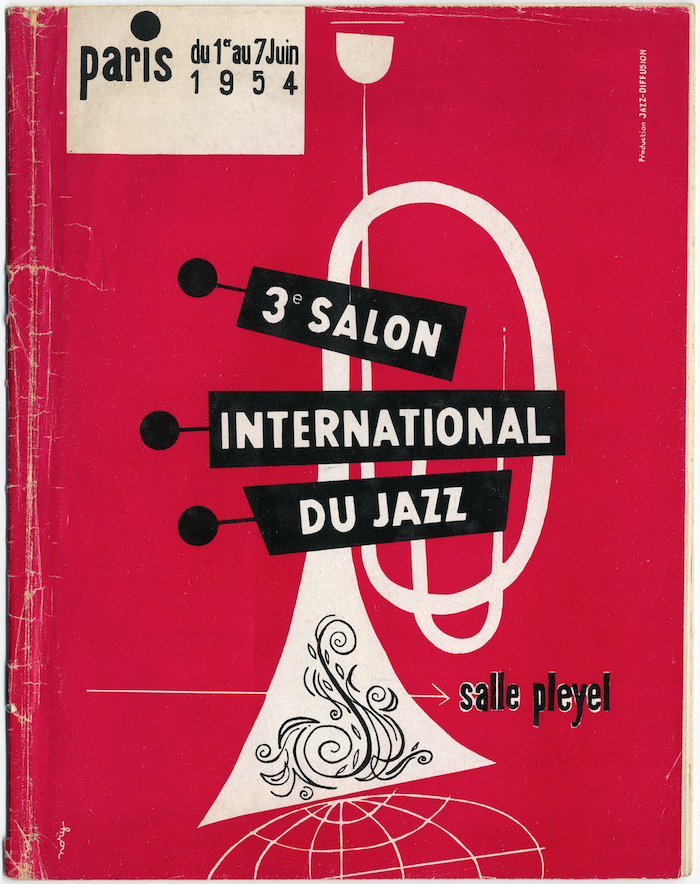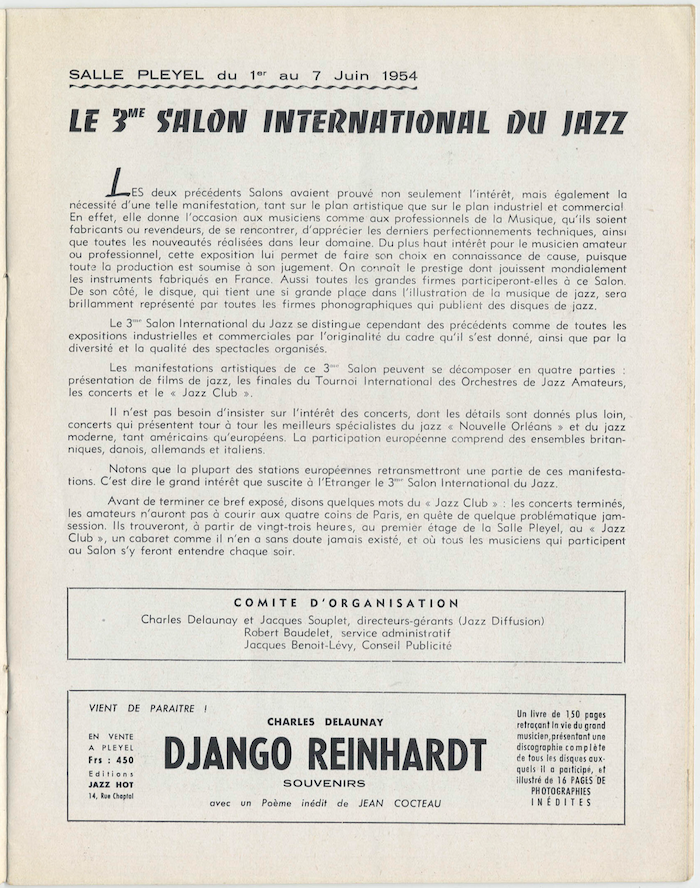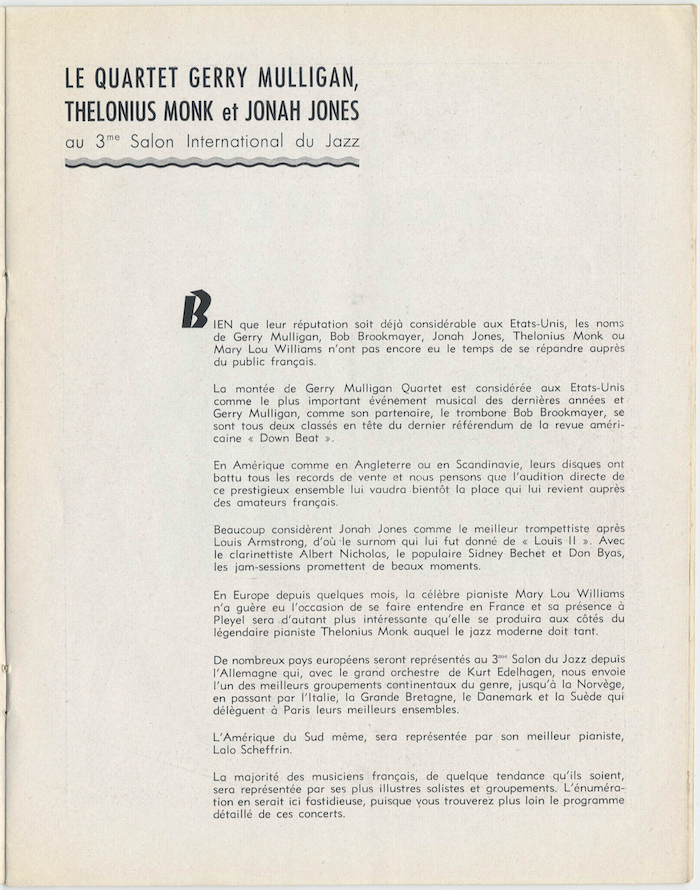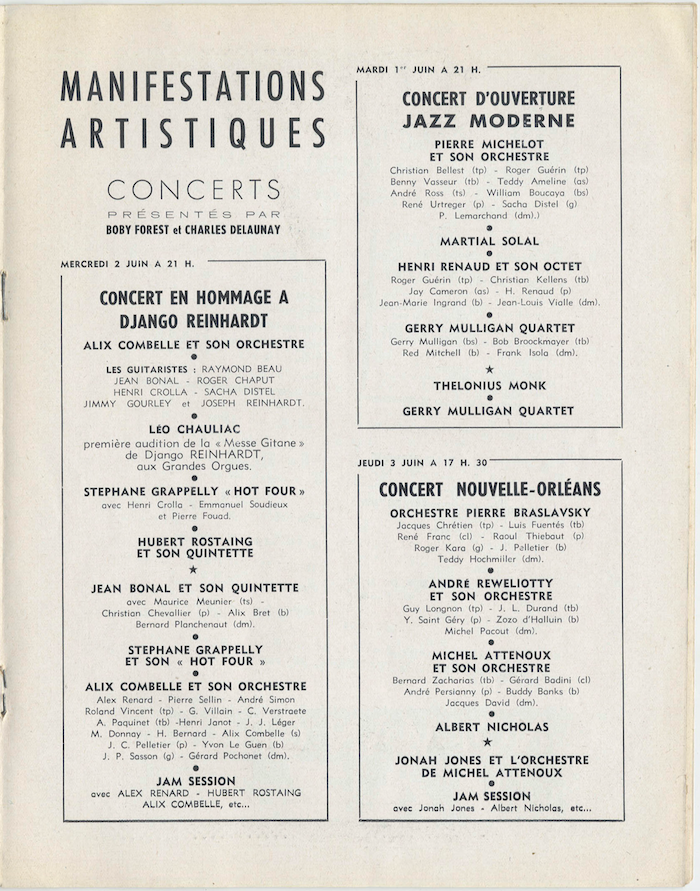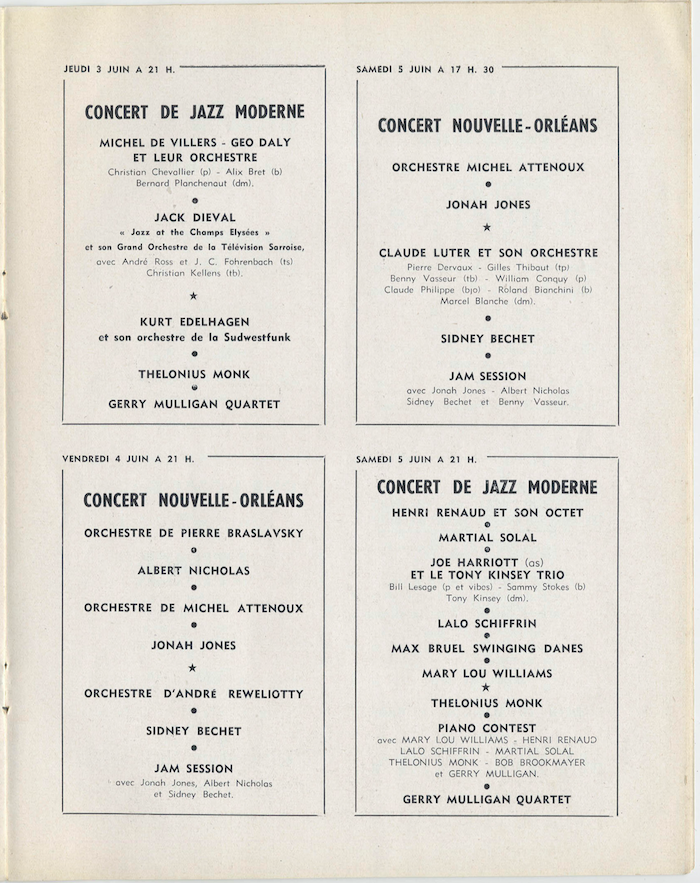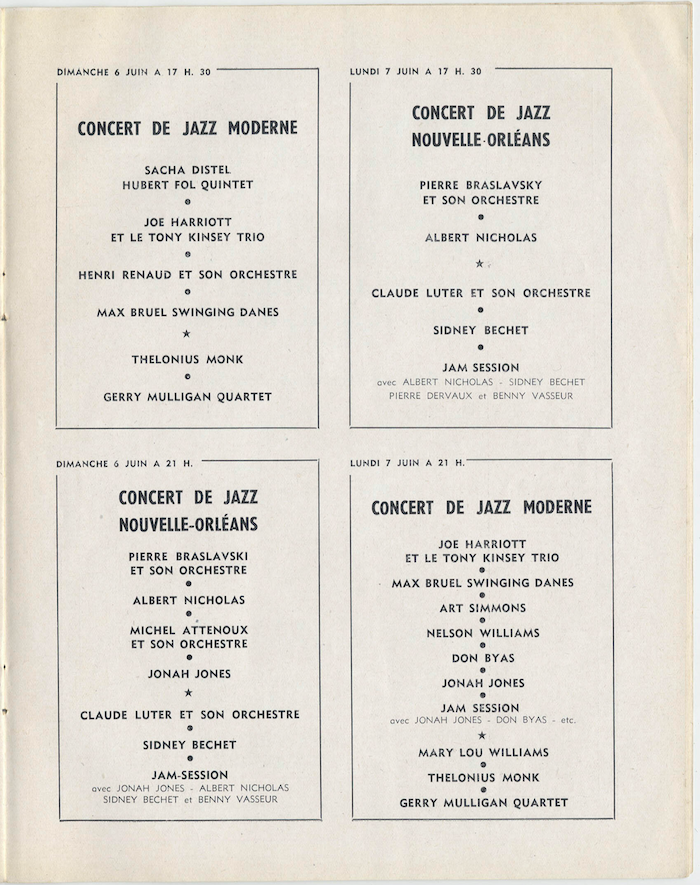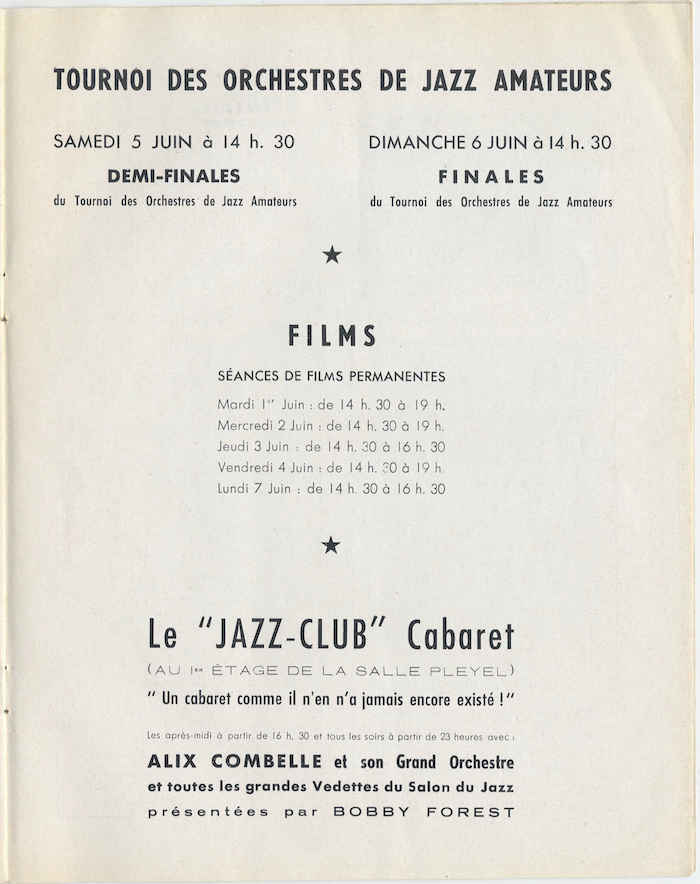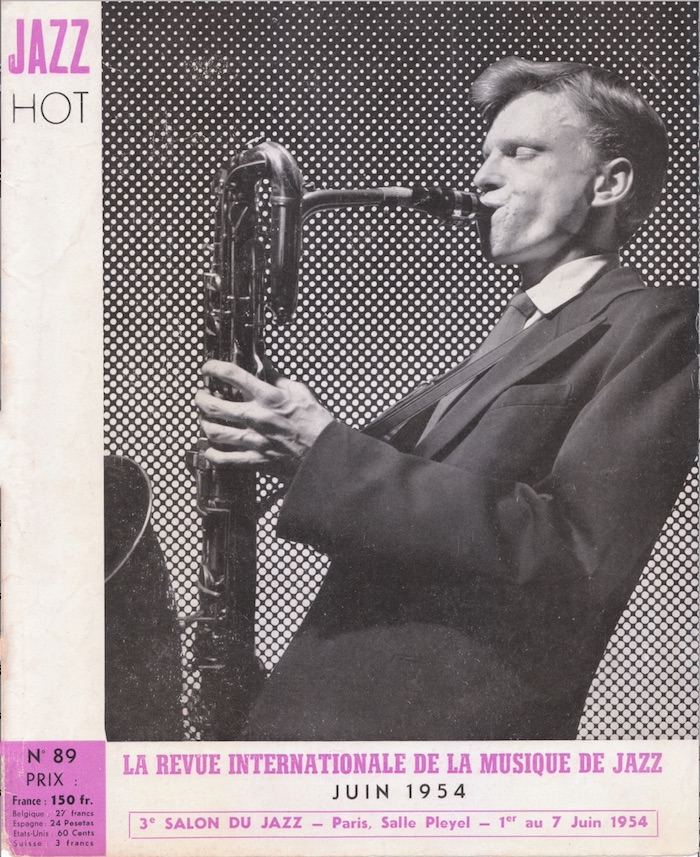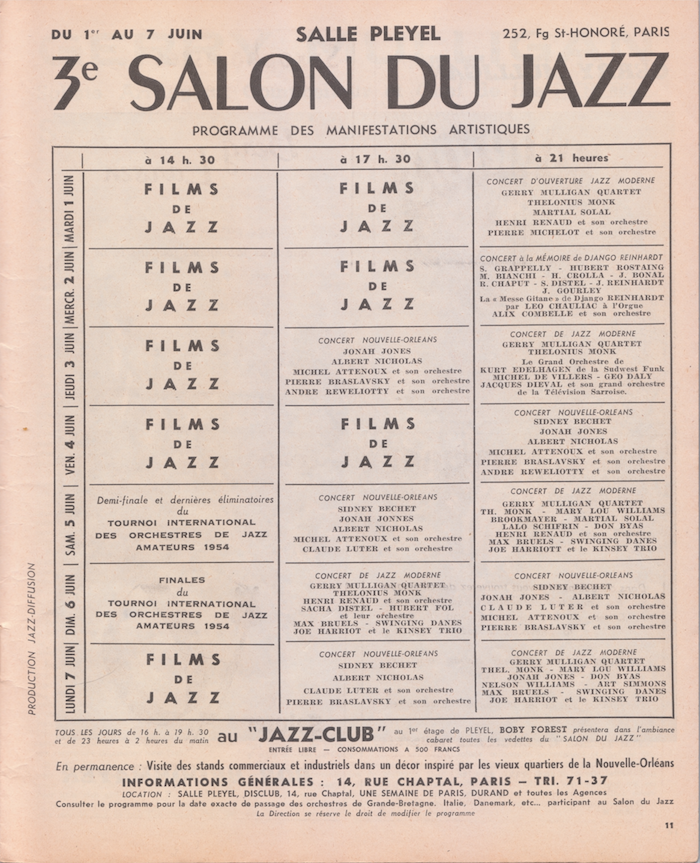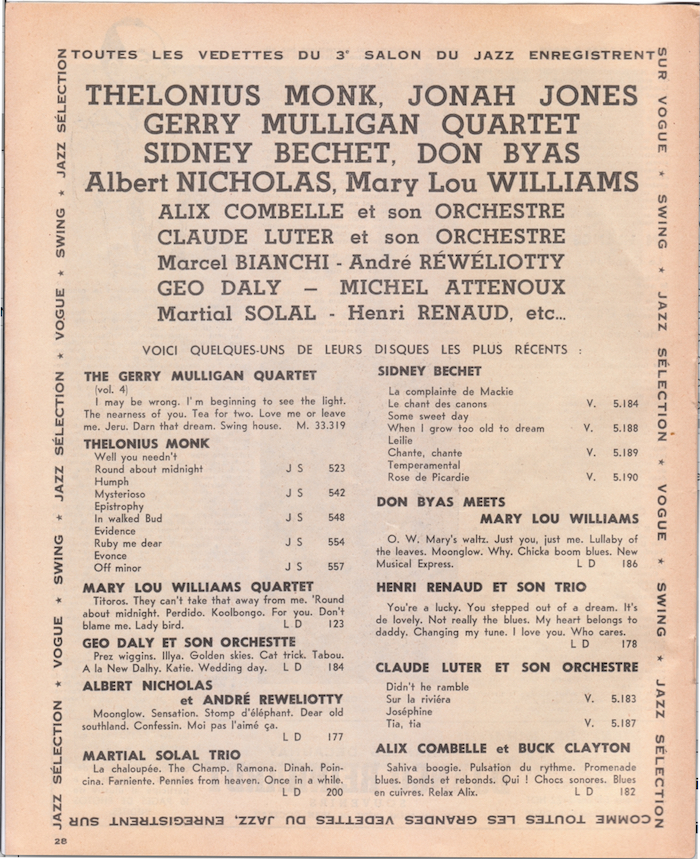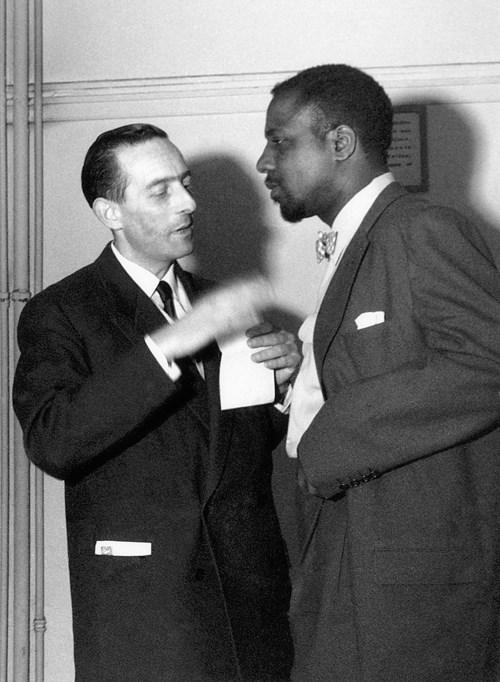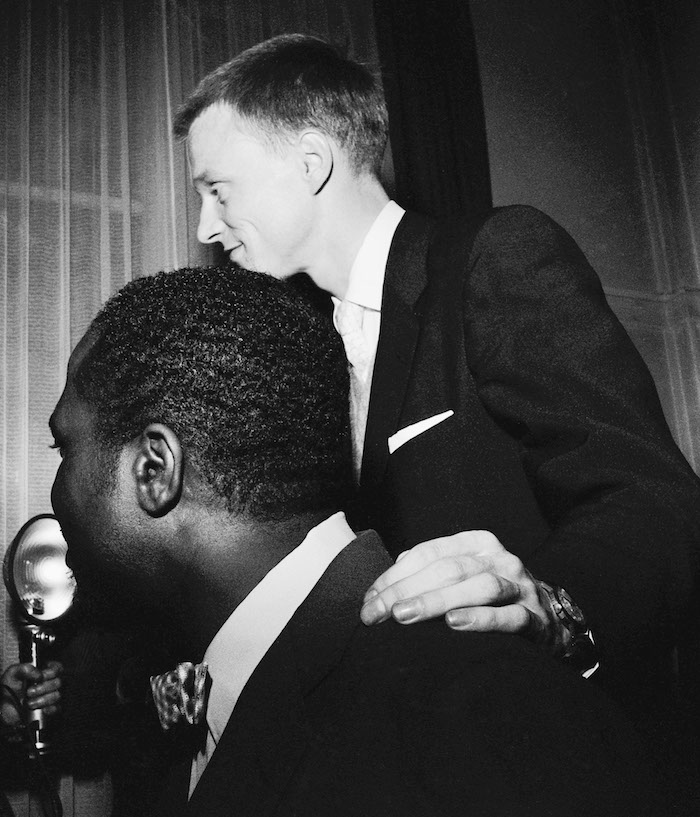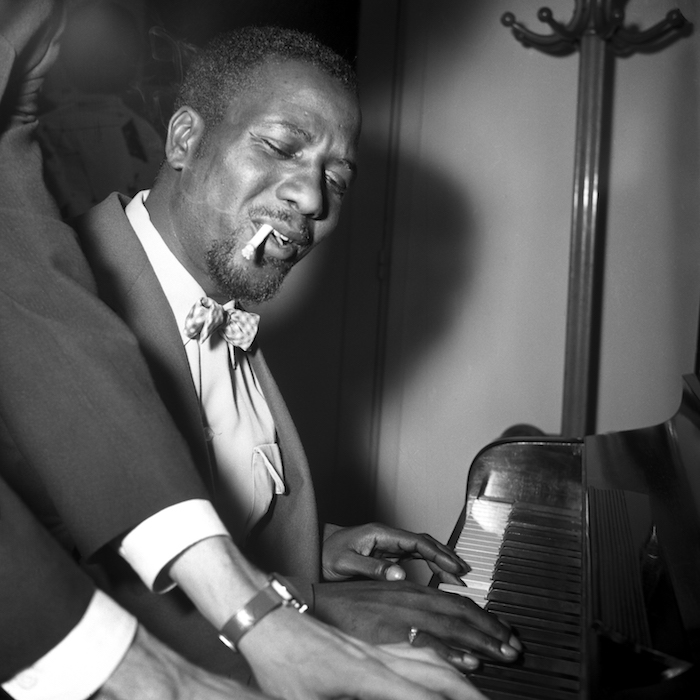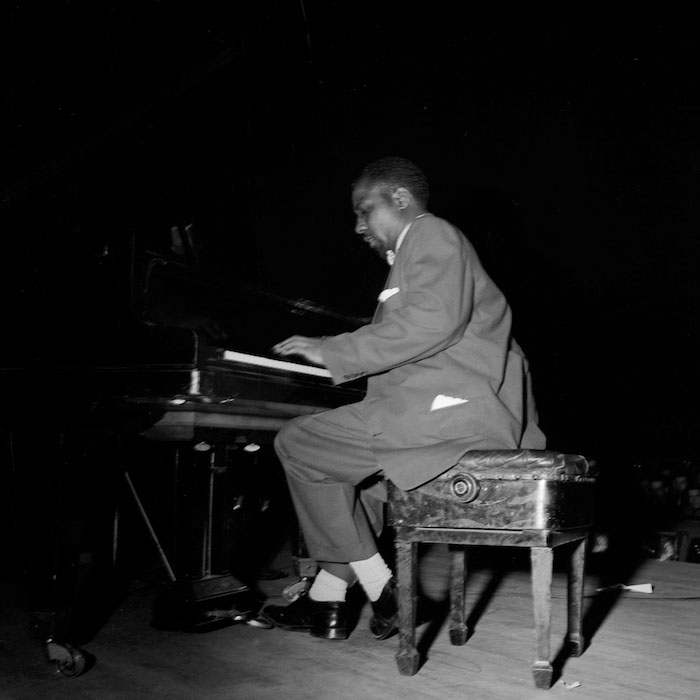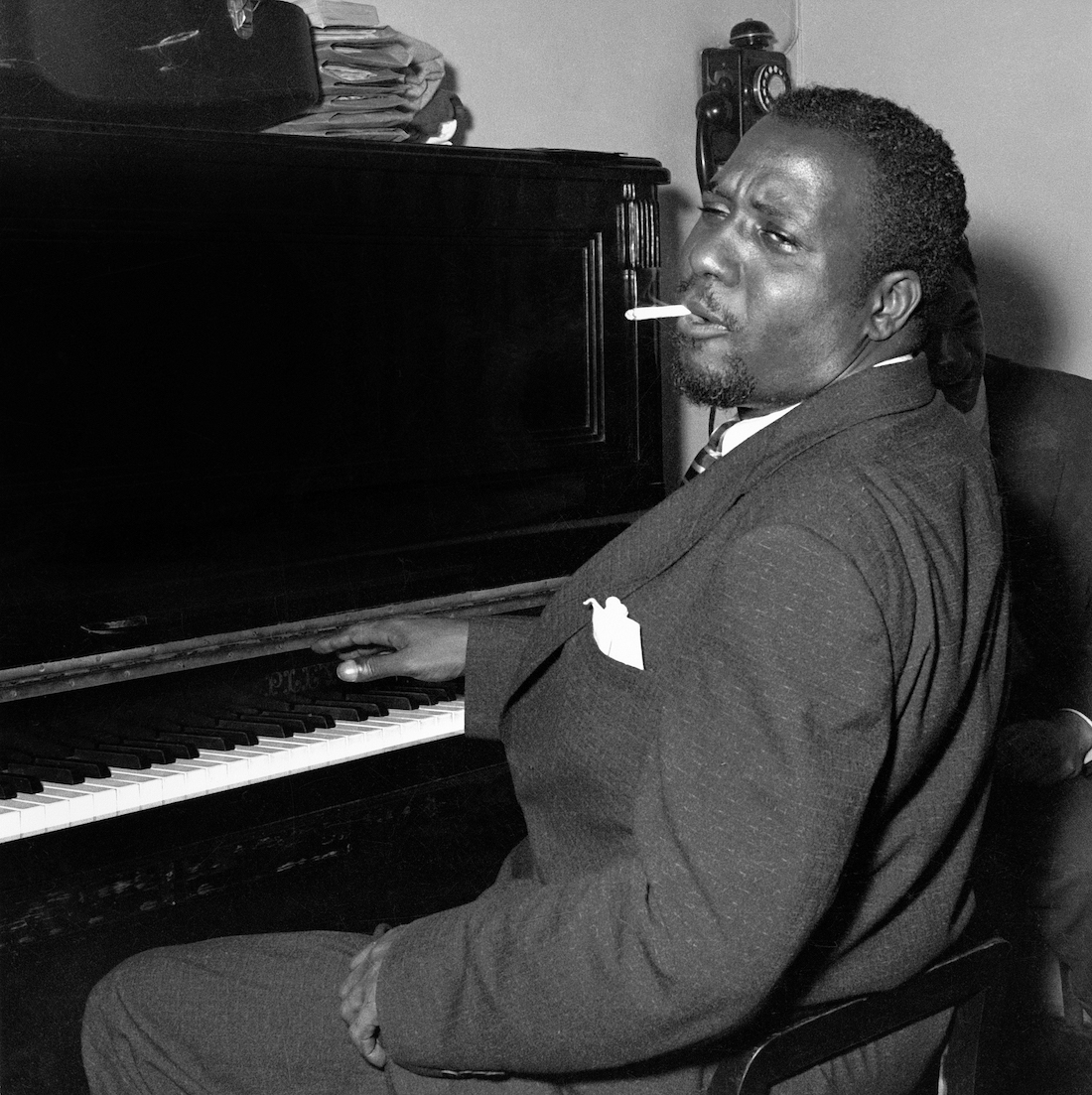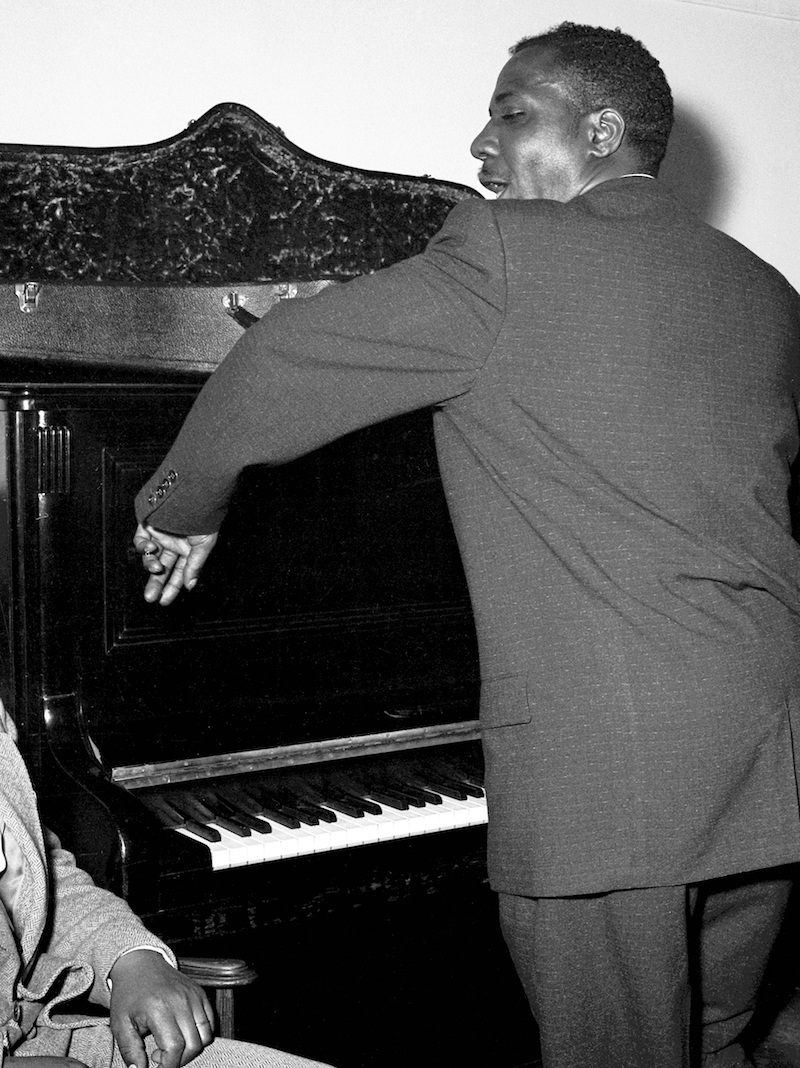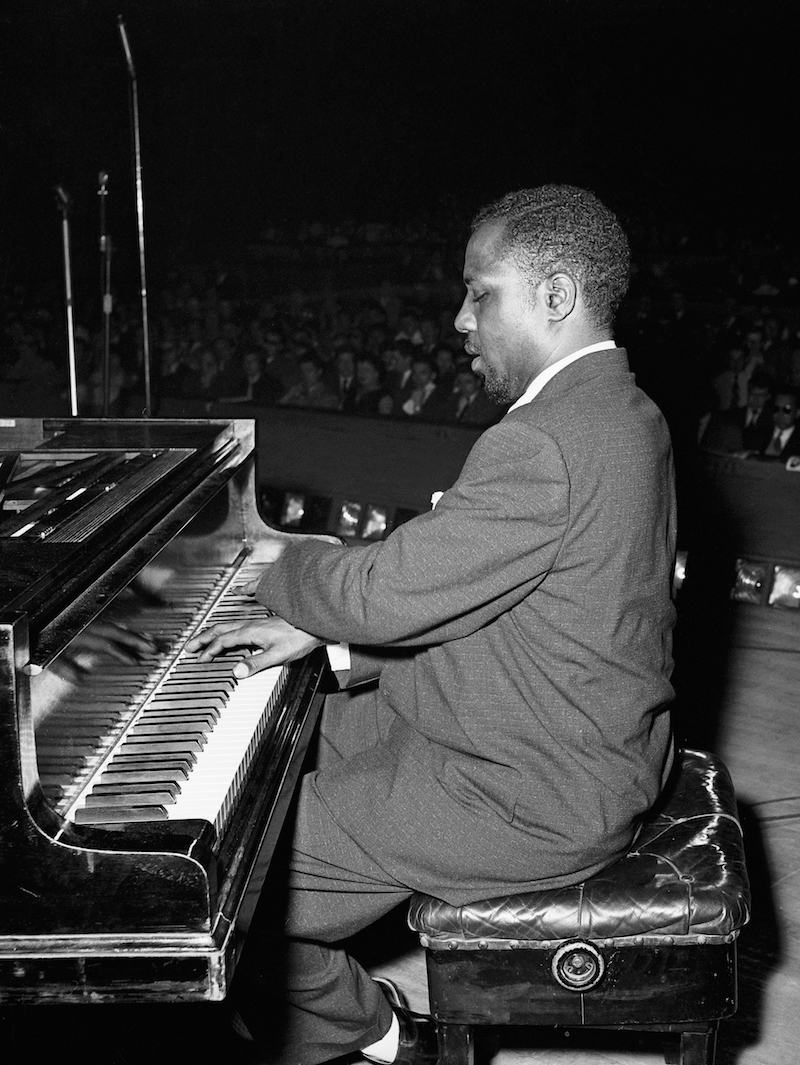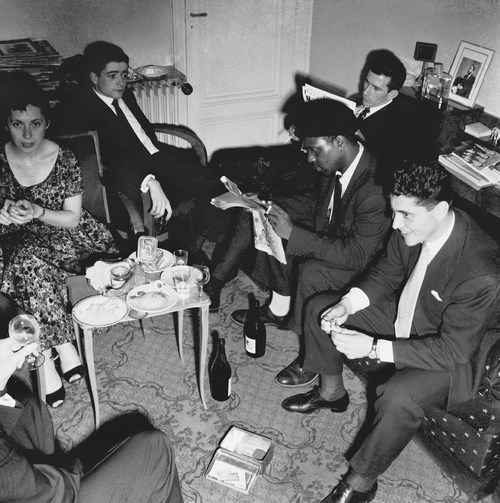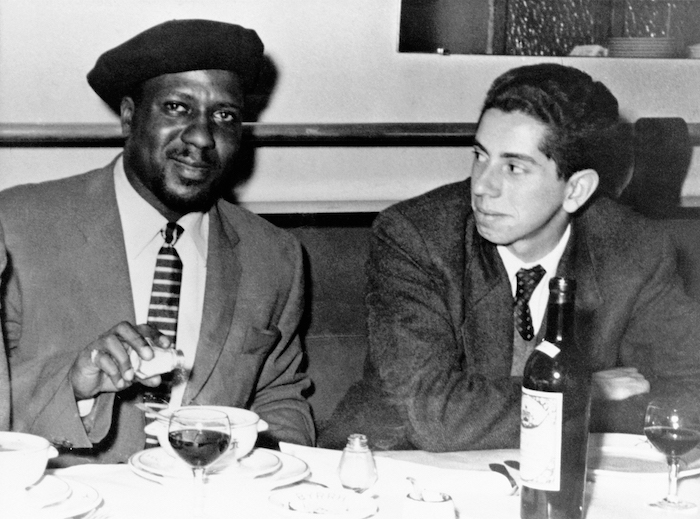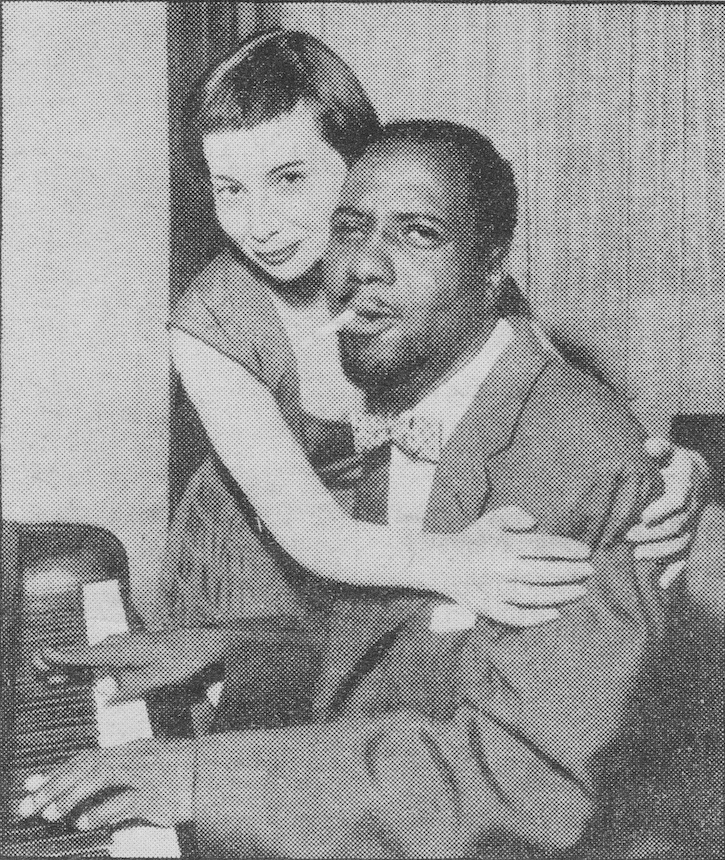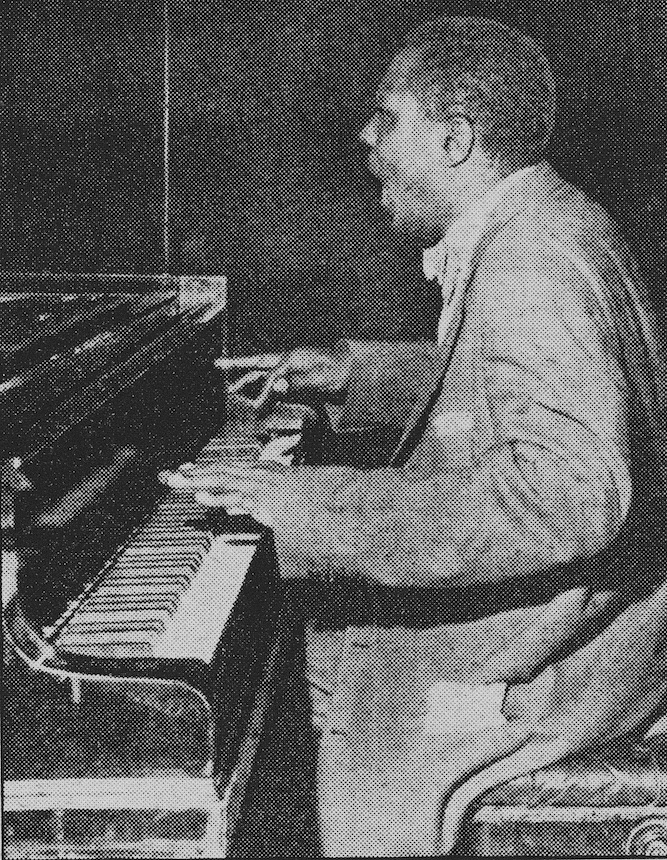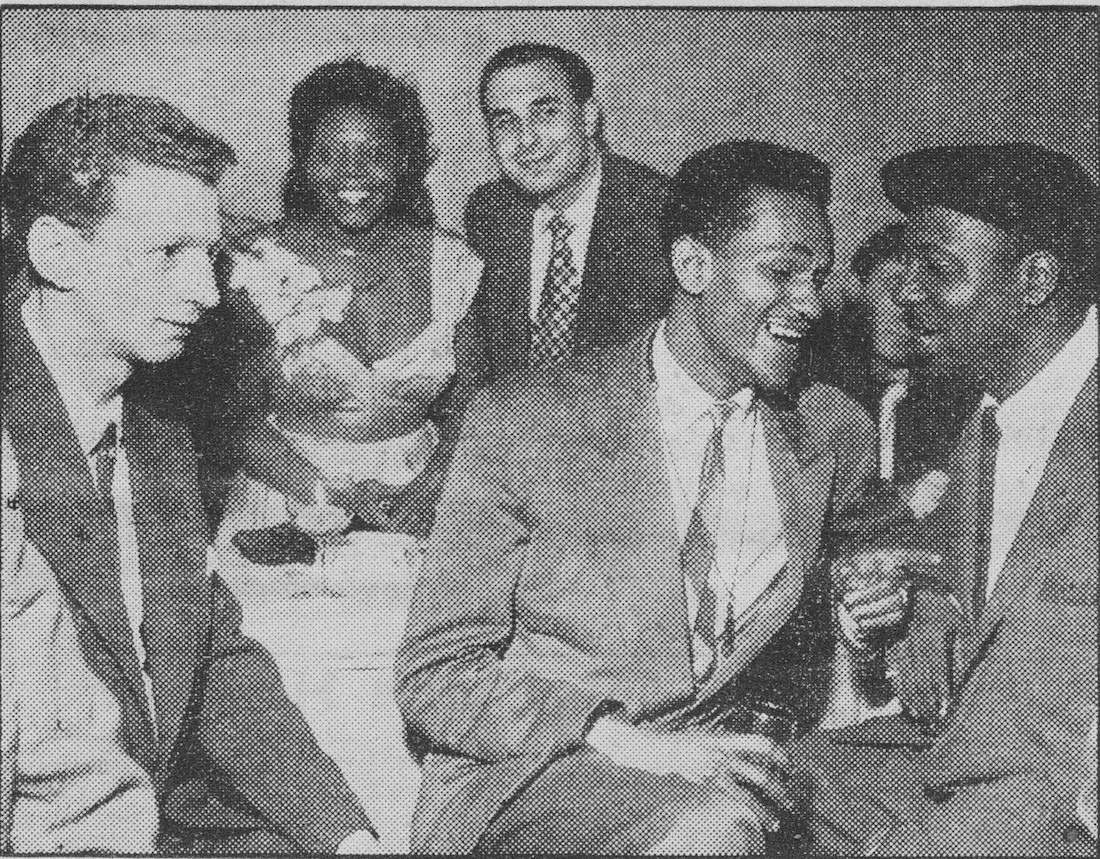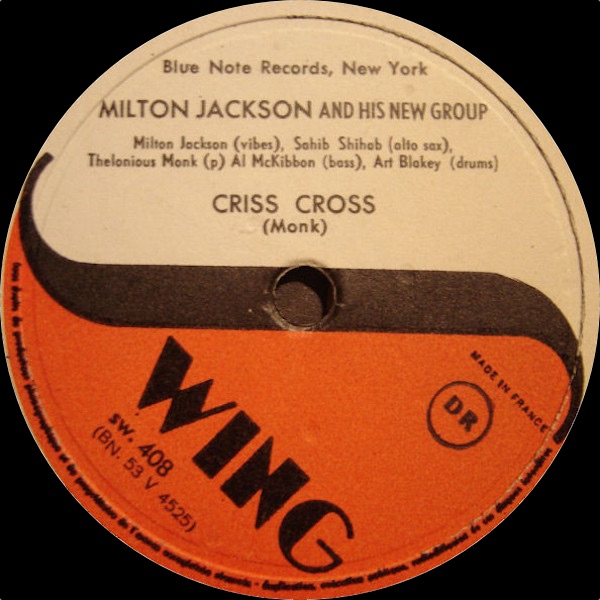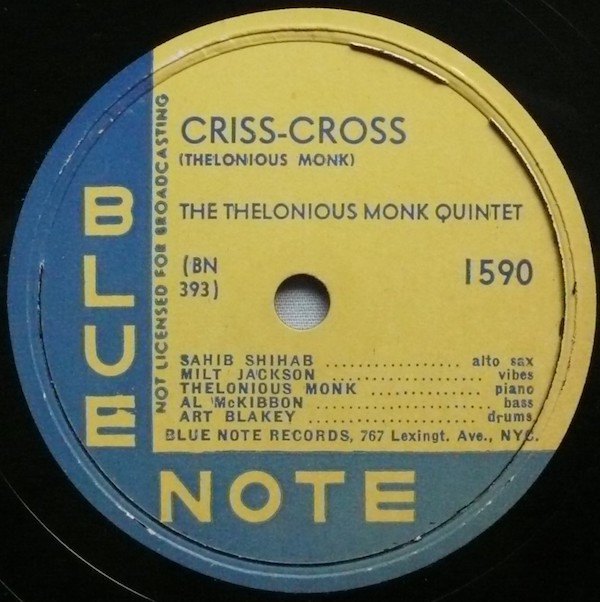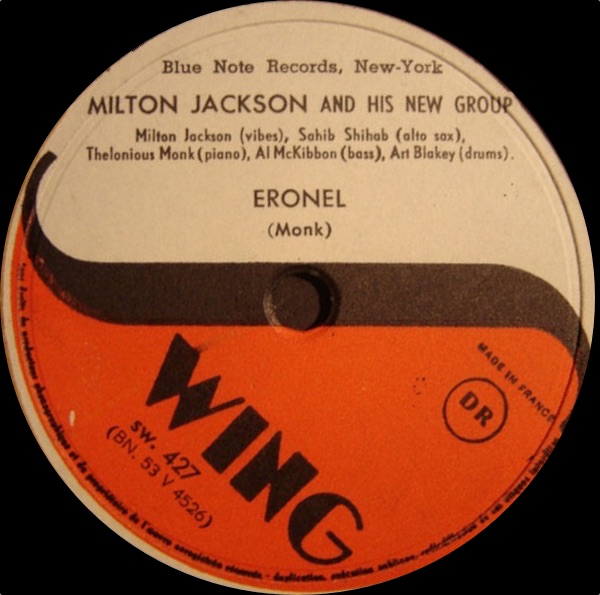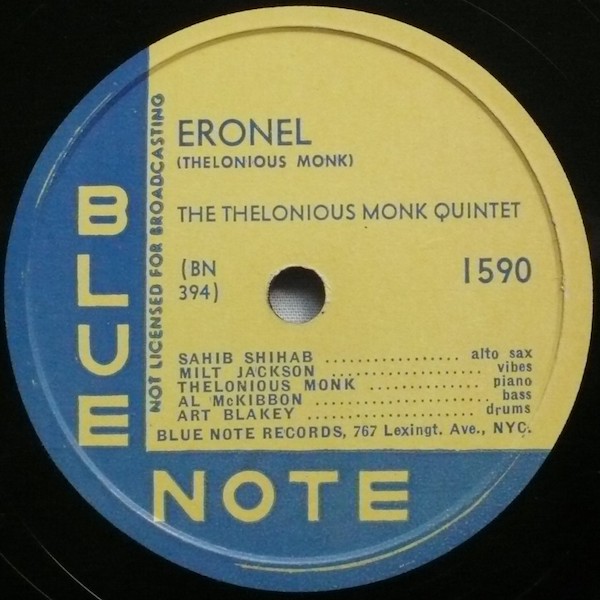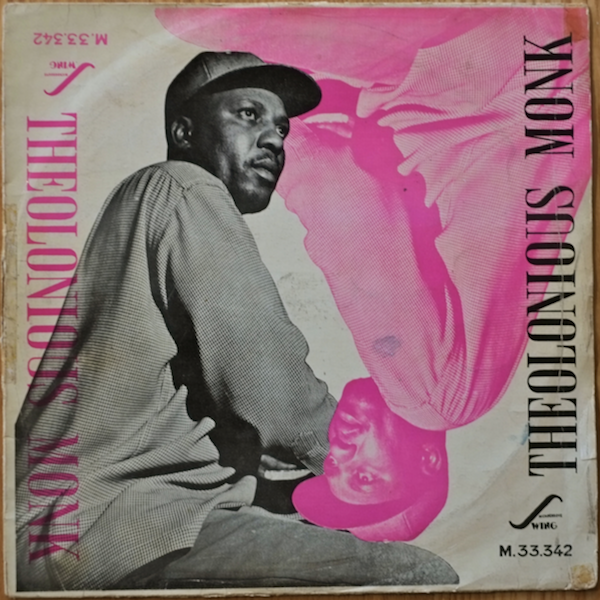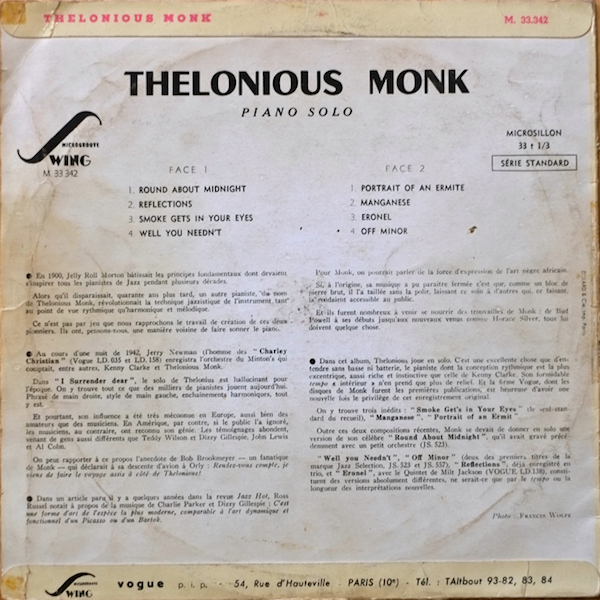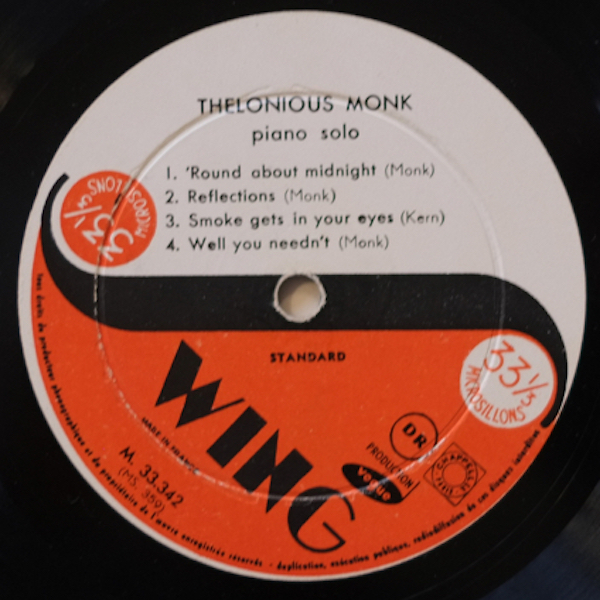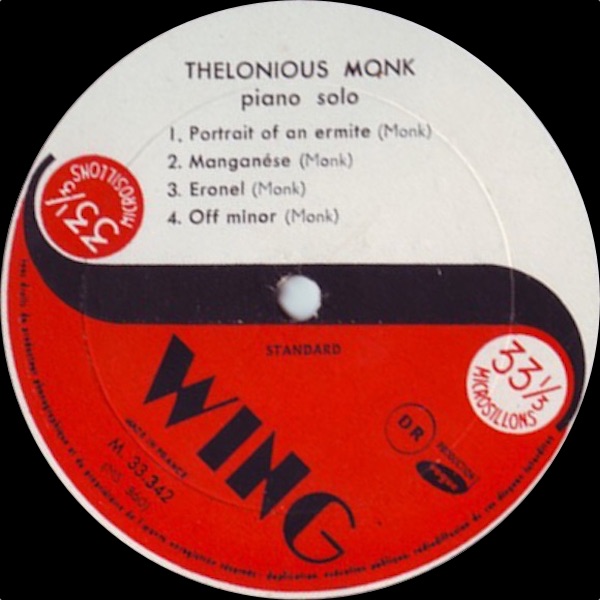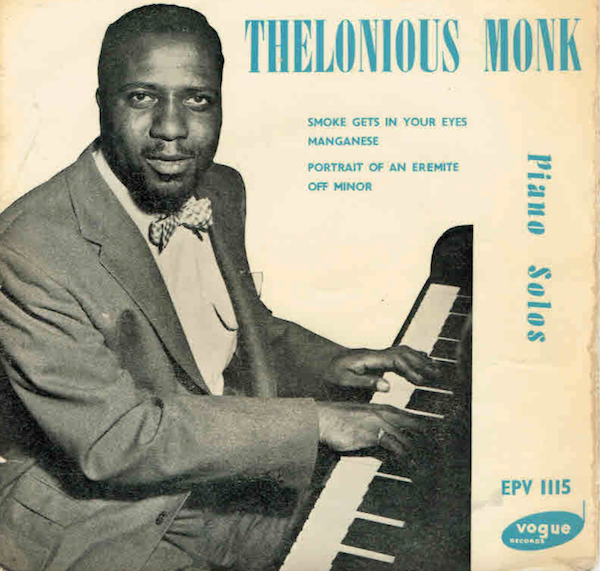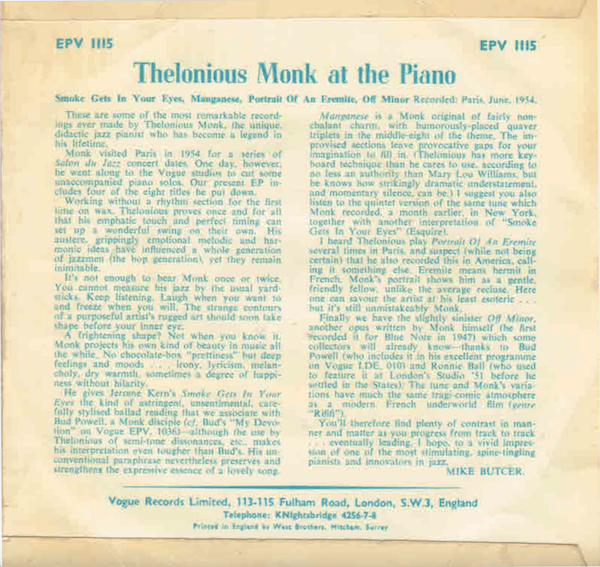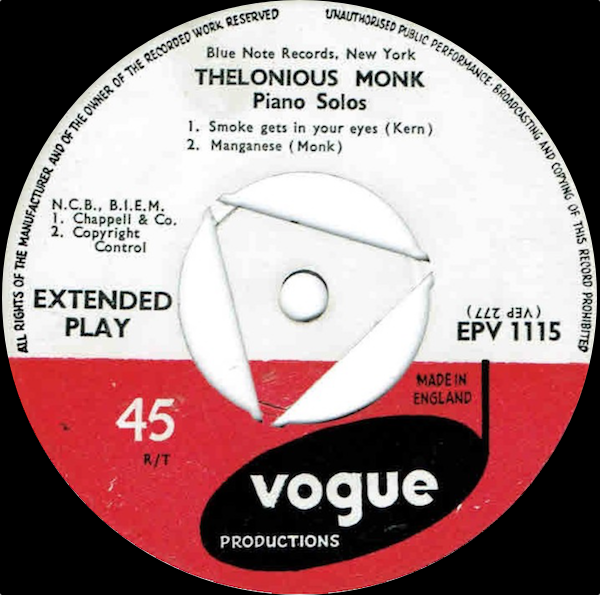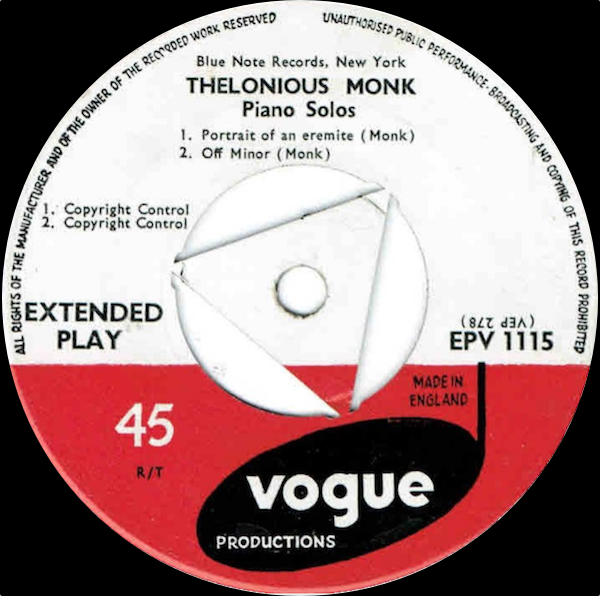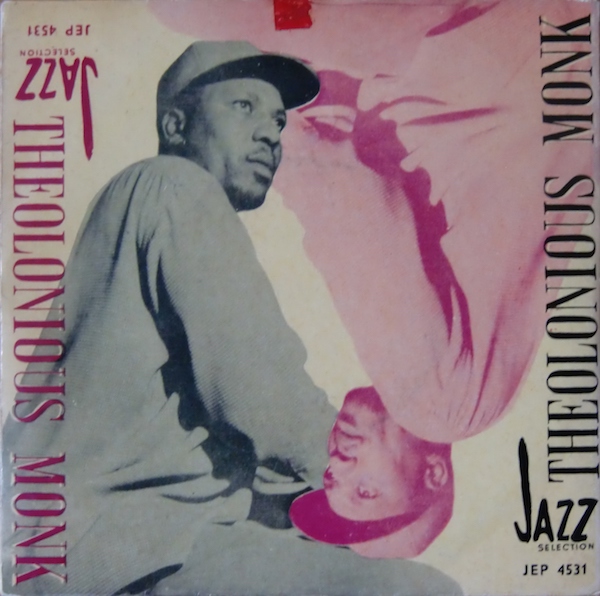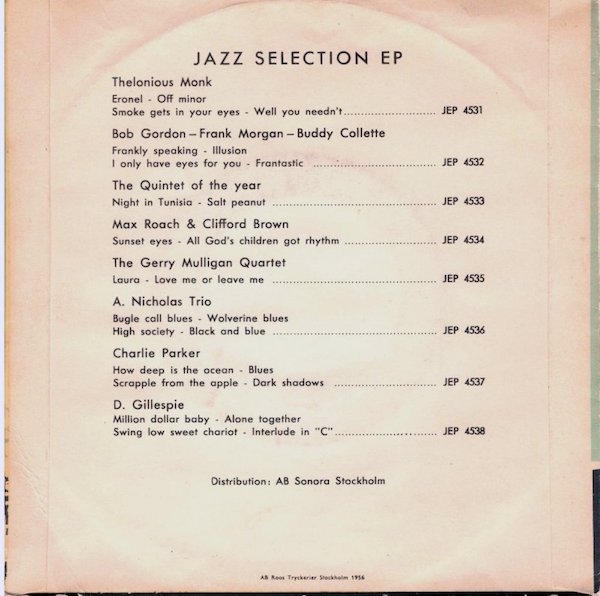The recording of the first performance that Thelonious Monk gave in France (it was also the concert that opened the 3rd edition of France's International Jazz Salon on June 1st 1954) came to light by accident. In 2016, I had a proposal from Daniel Baumgarten, who was in charge of jazz at Sony Music (the label holding the rights to the Vogue catalogue), to reissue the solo recording Thelonious Monk, Swing M. 33.342 (Vogue), in March 2017 to coincide with Monk's centenary year. The different sequences of the recording that had appeared in discographies and reissues had always been problematic for me, as they were all different and there seemed to be no documentary evidence to back them up. I suggested that we pay a visit to our friend André Francis, who had produced the recording with Marcel Romano, as we were already working on another project with François Lê Xuân, Alain Tercinet and Fred Thomas, (cf. “Les Liaisons dangereuses 1960, musique produite par Marcel Romano" Sam Records/Saga), and
we wanted to learn more about Monk's meeting with Marcel Romano. André pulled out “his notebooks" and we had our information on the sequencing, date and place of recording (see below).
To find the original tape we sent a request to the tape library for all the tapes marked “Monk," without referring to any titles or reference numbers whatever, as is customary in such cases, and this led us to examine all the tape-boxes in the archives of Vogue (Sony Music) with "Monk" on the label. And among these was the original tape and one which turned out to be the first concert given by Monk at Salle Pleyel. When we listened to the tape we discovered that this music recorded in 1954 sounded a great deal better than reports in the French and international press and witnesses at the time would have you believe.
When I consulted the latest biography to date (Robin D.G. Kelley, “Thelonious Monk: The Life and Times of an American. Original," New York Free Press, 2009), I realized that certain accounts were largely inaccurate, particularly the factual testimony of Jean-Marie Ingrand, and so I decided to verify the information that had been published, cross-referencing articles in magazines and books that referred to Monk in France prior to 1955.
What follows below is an attempt to gather, consolidate and correct previously published information. Among other things, it (a) specifies which discs were available on the French market and those that were not; (b) demonstrates that Thelonious Monk's appearance at the Salon was not "last minute" at all, as written by Kelley, but advertised beforehand and referred to in various communiqués (along with Gerry Mulligan and Jonah Jones, Monk was one of "the three stars of this series of manifestation" (in ‘Combat,’ Monday 31 May 1954, p. 2.; “Three ‘high-profile musicians’ coming from the United States for the 3rd International Jazz Salon" with photo, Le Figaro, Tuesday 1st June 1954, p. 9; (c) shows that Jean-Marie Ingrand's memory was at times confused[•], and (d) also indicates that despite the interest shown in Monk by Charles Delaunay and Léon Cabat[•], the Vogue company wasn't that active concerning Monk, presumably due to a lack of support from the editors of Jazz-Hot.
What we did find, finally, gives credit to Ny Renaud for knowledge of the jazz scene; far from being in Henri Renaud's shadow, she played a major role in the story behind these events[•]. We would also like to say that, at this point in our research, a number of reported "facts" are still in circulation but cannot be confirmed for want of clear sources.
Daniel Richard
English translation by Martin Davies
Recordings of Thelonious Monk released in France and French-speaking press appreciation before his first visit in May 1954
Reviews of Recordings As a Sideman
First reviews of Thelonious Monk’s music[•], as the accompanist of Coleman Hawkins, whose two disc were advertised in Jazz-Hot, mars 1949, p. 22 (reference “with Thelonious Monk”):
Jazz Selection, Coleman Hawkins Quartet J.S. 510 : On the Bean / Recollections.
Publié en mars 1949[•].
Voici quatre faces du quartette Hawkins, datant de 1944. En fait, ce quartette a plutôt l’allure d’un trio, car le batteur semble être absent. Du moins n’en perçoit-on pas la présence.
La première face, On the Bean, est une improvisation basée sur le célèbre thème de Whispering. Hawkins, en pleine forme, prend trois chorus pleins de verve où l’on retrouve toutes ses qualités d’invention et de punch et sa merveilleuse sonorité.
Cette face nous permet d’entendre enfin le fameux « pape du Be-Bop », Thelonious Monk, peu connu en France, mais qui jouit d’une grande réputation parmi les musiciens américains. Malgré des idées originales, sa technique limitée l’empêche de s’affirmer comme soliste. C’est plutôt un excellent accompagnateur be-bop, dont la personnalité ne semble d’ailleurs guère s’accorder avec celle de Hawkins.
Le verso, Recollections, joué sur tempo lent, nous montre cet aspect particulier de Hawkins alternant les phrases sur le temps et les phrases rapsodisantes. Le solo de ténor est d’une grande inspiration mélodique, et typique du jeu de Hawkins sur tempo lent …
Here we have four sides by the Hawkins quartet dating from 1944. This quartet sounds more like a trio in fact, as the drummer seems absent, or at least you hardly notice his presence.
The first side, On the Bean, is an improvisation based on the famous Whispering theme. Hawkins is in fine fettle, playing with verve on his three choruses where you can hear all his inventive qualities together with his punch and that wonderful sound.
Finally, this side allows you to hear the famous "Pope of Be-Bop,” Thelonious Monk; he was little-known in France but already had a great reputation among American musicians. Despite the originality of his ideas, his technical limitations prevented him from establishing himself as a soloist; he was an excellent bebop accompanist, rather, whose personality, in passing, hardly seems in tune with the character of Hawkins.
The flipside, Recollections, taken at a slow tempo, shows us this particular aspect of Hawkins' playing, where he alternates phrases on the beat with others where he rhapsodizes. The tenor solo has great melodic inspiration and is typical of the way Hawkins played a slow-tempo …
Jazz Selection, Coleman Hawkins Quartet J.S. 508 : Flyin’ Hawk / Drifting on a Reed.
Publié en mars 1949[•].
…Dans Flyin’ Hawk, sur tempo rapide, Hawkins joue avec sa flamme habituelle. Nous pouvons ici admirer son fameux vibrato haletant qui donne à son jeu une chaleur et une émotion que ne possède aucun autre ténor. On notera, dans le dernier chorus, une profonde ressemblance avec son disciple Byas.
Thelonious Monk prend ici un solo de 32 mesures fort original, que j’avoue aimer beaucoup, plus d’ailleurs pour les idées harmoniques que pour la beauté des phrases.
La quatrième face, Drifting on a Reed, sur tempo lent, se reproche beaucoup du fameux Body and Soul par la construction des phrases, mais n’atteint pas le même degré d’émotion. Hawkins y semble moins à l’aise. Il joue cependant une très belle coda.
En résumé, quatre faces fort intéressantes que doit posséder tout amateur de Hawkins.
R. A. [Robert Aubert]
« Disques », Jazz-Hot, N° 33, 15e Année (2e Série), mai 1949, p. 23.
…On Flyin’ Hawk, played at a quick tempo, Hawkins shows his usual ardour. Here we can admire his famous 'breathless' vibrato, which gives his playing the warmth and emotion that made him a unique tenor. In the final chorus you can note his profound resemblance to his disciple Byas.
Here Thelonious Monk takes a highly original 32 bar solo that I confess I like enormously, more, incidentally, for the harmonic ideas than for the beauty of his phrases.
The fourth side, Drifting on a Reed, over a slow tempo, is very close to the famous Body and Soul in the construction of his phrases, but it doesn't reach the same degree of emotion. Hawkins seems less comfortable here. He does play a very beautiful coda, however.
To summarize: four very interesting sides that every Hawkins fan should possess.
Also, in the short-lived magazine published by Eddie Barclay, Jazz News:
Jazz Selection, Coleman Hawkins Quartet J.S. 508 : Flyin’ Hawk / Drifting on a Reed.
Publié en mars 1949[•].
C’est du bon Hawkins : A) sur tempo lent, B) tempo moyen, mais le tout est, pour mon goût, en peu mou. Rares sont les occasions que l’on a d’entendre Thelonious Monk et, malgré qu’il ne semble pas être dans ses meilleurs jours, son jeu sera peut-être une révélation pour beaucoup…
This is good Hawkins: A) at a slow tempo, B) mid-tempo, but all of it lacks muscle, to my taste. The chances to hear Thelonious Monk are rare and, despite the fact he seems not to be on a great day, his playing will no doubt come as a revelation for many...
Jazz Selection, Coleman Hawkins Quartet J.S. 510 : On the Bean / Recollections.
Publié en mars 1949[•].
…Je préfère le second disque. On the Bean (Whispering) est bien enlevé. Recollections est un beau thème de W. Thomas, Hawkins y fourmille d’idées langoureuses.
Hubert Fol
« Disques », Jazz News, N° 6, juin 1949, p. 17.
...I prefer the second disc. On the Bean (Whispering) is very lively. Recollections is a beautiful tune by W. Thomas and Hawkins teems with languid ideas in this.
Georges Daniel and André Hodeir picked him for their "ABC du Jazz”:
Soliste et accompagnateur très original. L’un des précurseurs du be-bop. On the Bean avec Coleman Hawkins (Jazz Selection)
« L’ABC du Jazz : Essais d’initiation (9 et fin). Principales figures du jazz (cent noms à retenir) par Georges Daniel et André Hodeir », Jazz-Hot, N° 35, 15e Année (2e Série), juillet 1949, p. 11.
Highly original soloist and accompanist. One of the bebop's precursors. On the Bean with Coleman Hawkins (Jazz Selection).
Reviews of Recordings As a Leader
Only 5 of the first 6 Blue Note 78rpm records out of a total of 14 discs and 1 side, released in the US between January 1948 and October 1953[•], were released in France by Jazz-Disques[•]; this new company had received a license to distribute (Blue Note) as early as April 1949. The releases received a mixed reception in Jazz-Hot[•]:
Jazz Selection, Thelonious Monk Trio / Quintet J.S. 523 : Well You Needn’t / 'Round about Midnight.
Publié en avril 1949[•]
Thelonious Monk est généralement considéré comme un pianiste d’avant-garde. On l’a même surnommé « le Grand-Prêtre du be-bop ». Dans ces deux faces, il est évidemment beaucoup plus en valeur que dans les Quartette Hawkins chroniqués le mois dernier par Robert Aubert. Son jeu assez viril malgré un toucher nuancé semble axé sur une recherche perpétuelle, tant au point de vue mélodique qu’au point de vue harmonique. Style très personnel, d’un dépouillement qui rejoint celui des solos de Count Basie. L’invention est parfois déconcertante, surtout dans 'Round about; mais que de swing au verso! Dans la première face, Monk est accompagné par Gene Ramey (b) et Art Blakey (dm) d’excellente façon.
A.H. [André Hodeir]
« Disques », Jazz-Hot, N° 34, 15e Année (2e Série), juin 1949, p. 23.
Thelonious Monk is generally considered an avant-garde pianist. He was even nicknamed the "High Priest of Bebop.” On these two sides he is obviously more in favour than in the Hawkins quartet recordings reviewed last month by Robert Aubert. His rather virile playing, despite nuances in his touch, seems centred on his constant research into both melody and harmony. A very personal style, with a sobriety close to that heard in solos by Count Basie. The inventiveness is at times disconcerting, especially in 'Round about...; but what swing on the other side! On the first side Monk has excellent accompaniment from Gene Ramey (b) and Art Blakey (dm).
Jazz Selection, Thelonious Monk Quartet / Sextet J.S. 542 : Misterioso / Humph.
Publié en décembre 1949[•].
On ne comprend pas très bien pourquoi l’éditeur a cru devoir coupler ces quatre faces de cette façon, alors que, par la composition de l’orchestre comme par le style même de la musique, Misterioso et Epistrophy sont en quelque sorte deux faces-sœurs, qu’il eût été indiqué de réunir.
On y entend un quartette composé de Milt Jackson (vib.), Th. Monk (p), John Simmons (b), et Shadow Wilson (dm). Je n’aime guère les solos de Monk : son dépouillement pourrait bien n’être que de la pauvreté, et ses accrochages ne sont pars toujours géniaux. Mais il faut convenir qu’il a su imprimer à ces deux œuvres un caractère fortement personnel et qui n’est pas sans captiver l’auditeur.
Misterioso est un blues en si bémol. On a enregistré beaucoup de blues en si bémol depuis que le jazz existe, mais celui-ci ne risque guère d’être confondu avec quelque autre. Le thème, basé sur une sorte de sixtes mélodiques ascendantes qui s’égrènent sur les accords et « passages » du blues, est des plus curieux.
A. H. [André Hodeir]
« Disques », Jazz-Hot, N° 40, 16e Année (2e Série), janvier 1950, p. 21.
We don't understand very well why these four sides have been coupled like this, since Misterioso and Epistrophy could be sister-sides, both in the group's line-up and in the style of the music, and putting them together would seem appropriate.
In these you hear a quartet made up of Milt Jackson (vib.), Th. Monk (p), John Simmons (b), and Shadow Wilson (dm). I barely like Monk's piano solos: his sobriety could well be poverty, and those abrupt collisions aren't always signs of genius. But you have to agree that he has left a strong, personal imprint on these two works, one that the listener may find captivating.
Misterioso is a blues in B flat. People have recorded many B flat blues pieces ever since jazz has existed, but there's little risk that this one might be confused with any another. The theme, based on a kind of ascending melodic sixths that are dotted over the chords and "passages" of this blues, is most unusual.
Jazz Selection, Thelonious Monk Quintet / Quartet J.S. 548 : In Walked Bud / Epistrophy.
Publié en décembre 1949[•].
On connaît déjà l’Epistrophy de Kenny Clarke. Cette version-ci est très différente, avec une introduction où le piano de Monk contrecarre par ses « trois pour deux » le rythme générale; l’impression d’ensemble est d’ailleurs un peu confuse.
Dans les deux faces, Monk vaut surtout par son jeu d’accompagnement très original et bien venu. Quant à Milt Jackson, c’est un soliste de tout premier ordre, le seul à ma connaissance qui puisse être placé sur le même plan que Lionel Hampton.
Ces deux faces seront, à ce point de vue, une révélation pour bien des amateurs français. Quant à la section rythmique, elle s’acquitte bien des tâches que Monk lui assigne.
Humph est exécuté par Idrees Sulieman (tp), Danny Quebec (as), Billy Smith (ts), Th. Monk (p), Eugene Ramey (b) et Art Blakey (dm). C’est un thème assez vulgaire, que ne rachète point une série de chorus sans grand relief. Le meilleur est le jeu de la section rythmique.
In Walked Bud joué par George Taitt (tp), Ed Gregory (as), Monk, Robert Paige (b) et Art Blakey est un disque qui « chauffe ». Les solistes ne sont pas très remarquables et il y a même quelque trivialité dans le jeu de G. Taitt. La sonorité dure de Monk y est plus en évidence que dans les autres faces : et, comme dans Humph et Epistrophy, il y abuse de la gamme par tons.
A. H. [André Hodeir]
« Disques », Jazz-Hot, N° 40, 16e Année (2e Série), janvier 1950, p. 21.
We already know the Epistrophy (version) by Kenny Clarke. This one is very different, with an introduction where Monk's piano and its "three for two" counteracts the general rhythm, which incidentally gives an overall impression of confusion.
On both sides, Monk is interesting above all for his highly original accompaniment, which is very welcome. As for Milt Jackson, he is a first-rate soloist, the only one to my knowledge on the same scale as Lionel Hampton.
From that point of view, these two sides will come as a revelation to French jazzfans. As for the rhythm section, the tasks that Monk allots to them are carried out well. Humph is executed by Idrees Sulieman (tp), Danny Quebec (as), Billy Smith (ts), Th. Monk (p), Eugene Ramey (b) and Art Blakey (dm). The tune is rather common, and a series of choruses without much relief do nothing to redeem it. The best comes from the rhythm section.
In Walked Bud, played by George Taitt (tp), Ed Gregory (as), Monk, Robert Paige (b) and Art Blakey is a recording that "cooks." The soloists are not that remarkable and there's even some triviality in the playing of G. Taitt. The hard sound of Monk is more in evidence in this title than on the other sides and, as in Humph and Epistrophy, here he goes too far in his use of the whole tone scale.
Jazz Selection, Thelonious Monk Quartet / Trio J.S. 554 : Evidence / Ruby My Dear.
Publié en décembre 1949[•].
Le premier chorus d’Evidence est joué magistralement par Milt Jackson qui est vraisemblablement l’un des plus grands musiciens bop et, avec Hampton, le meilleur parmi les vibraphonistes. Puis Monk commence un chorus, je ne dirai pas par une de ses phrases favorites, mais par « sa » phrase favorite, étant donné qu’elle revient dans tous ces disques! Elle lui plait d’ailleurs tellement qu’il la répète tout au long de cette face. Je sais que beaucoup diront que c’est d’un dépouillement génial; j’ai bien peur quant à moi, que ce soit là une pauvreté d’inspiration. C’est en tout cas ainsi que cela s’appellerait chez un Hawkins ou un Lester Young si il leur prenait fantaisie de jouer de telle manière. Monk s’affirme en tout cas ici accompagnateur original.
Ruby My Dear est un solo de Monk que je n’arrive pas à trouver génial en dépit de mes efforts. Il s’y montre assez médiocre pianiste, instrumentalement parlant. De plus, il abuse des procédés de gammes par tons, et son inspiration me semble plutôt faible. Ses deux grandes qualités sont une personnalité incontestable et un swing certain. A mon sens, son renom en Amérique parmi les musiciens vient davantage de ses dons d’accompagnateur que de ses qualités de soliste.
R. A. [Robert Aubert]
« Disques », Jazz-Hot, N° 44, 16e Année (2e Série), mai 1950, p. 28.
Milt Jackson masterfully plays the first chorus on Evidence; in all likelihood he is one of the greatest bop musicians and, with Hampton, the best among the vibraphone players. Then Monk begins a chorus, I won't say with one of those favourite phrases, but rather "his" favourite phrase, given that it comes back again on all his records! He likes it so much in fact, that he repeats it all the way through this side. I know many will say that his sobriety here is the work of a genius, but I'm afraid that this only shows poor inspiration in my opinion. It is, in any case, what it would be called in a Hawkins or a Lester Young if it took their fancy to play this way. Here, in any case, Monk asserts himself as an original accompanist.
Ruby My Dear is a Monk solo where I see no evidence of genius despite my efforts. He shows himself a rather mediocre pianist here, instrumentally speaking. Plus, his manner of playing whole tone scales is overdone, and I find his inspiration rather weak here. His two great qualities are his unquestionable personality and a definite swing. To my mind, his renown in America, in musicians' circles, stems more from his gifts as an accompanist rather than from his qualities as a soloist.
In his (critical) essay “Puissances du Jazz" ("Powers of Jazz"), a book, the Surrealist poet Gérard Legrand unreservedly provides a beautiful evocation of the music of Monk:
« Chapitre VII - Jazz et Surréalisme »
« Je terminerai ces quelques pages, dont l’allure de palmarès me gêne tout le premier, en évoquant le plus méconnu et l’un des plus originaux créateurs du jazz contemporain, c’est-à-dire Thelonious Monk. On l’entend rarement, quoiqu’il ait assez souvent accompagné de petites formations centrées sur Hawkins ou Gillespie. Mais, à Paris du moins, les disquaires sont unanimes à déclarer que la mévente a frappé ses premiers disques, et c’est certainement un des noms les moins connus du public même « averti » ou se croyant tel. En 1948, Robert Goffin, retour d’Amérique, n’en parlait que comme d’un personnage mystérieux, dont tout le monde néanmoins reconnaissait la décisive influence sur le « new sound ». Son originalité est extrême. Il impose à tous les thèmes une volonté de rigueur particulière, qui ne se situe exactement ni dans le domaine passionnel (aucune effusion, pas la moindre trace de forcing) ni dans le domaine intellectuel : c’est tout l’opposé d’un Lennie Tristano, chez qui l’attaque disparaît au profit d’un lissé continu de l’harmonie. Sa lucidité ne conclut pas à la froideur, mais à une sorte de perfection à rebrousse-poil, exaspérante, qui n’a même pas l’excuse d’être lyrique ou mécanique, et qui me permet, risquant le délire d’interprétation, de situer—seul sans doute des grands musiciens de jazz que j’aime—Thelonious Monk sur un plan éthique (« par-delà le bien et le mal » évidement). Je veux dire qu’avec Thelonious Monk, la valeur esthétique des éléments constitutifs du piano-jazz est immédiatement érigée en valeur autonome et participe de cette catégorie unique de la relation universelle où la dialectique nous contraint de situer l’Absolu. Cette perfection, sensible dans les enregistrements « anciens » de Thelonious Monk, tel Ruby My Dear et Evidence (avec Milt Jackson, John Simmons à la basse et Shadow Wilson aux drums) se pare tour à tour, dans les faces toutes récentes (début 1952) que sont Criss Cross, Eronel, avec son prologue ironique, Four in One, Straight No Chaser, d’une cruauté brillante et d’une fraîcheur d’aurore. Thelonious Monk, outre Milt Jackson en qui s’affirme le meilleur des jeunes vibraphonistes, y est entouré d’Al McKibbon (b), d’Art Blakey (dms) et de Sahib Shihab (ce doit être un pseudonyme) alto-sax dont les chorus sont faibles, mais dont les unissons avec Milt Jackson sont une révélation. On peut encore attendre beaucoup de Thelonious Monk. Dans cette musique transparaît la provocante sécheresse du sourire de la Sphinx, tandis que les éclats de bois et d’acier qui l’environnent ont la détente des serpents et ses harmonies l’acidité tonique de l’éclair. Le caractère occulte de la grande création musicale, grâce à Thelonious Monk, trouve sa revanche à l’intérieur même de ces airs de fête qui sont le jazz[•]. »
« Appendice »
« Depuis que les pages précédentes ont été écrites, j’ai pu entendre quelques faces de Thelonious Monk sur « Blue Note » américain, antérieures à la série de 1952. Dans Thelonious et Suburban Eyes, titre bizarre d’un thème d’Ike Quebec, Thelonious est entouré comme naguère dans Humph et Evonce (Jazz-Selection) par Idrees Sulieman (tp), Danny Quebec West (as), Billy Smith (ts), Eugene Ramey et Art Blakey. Dans Monk’s Mood et Who Knows, la formation comprend George Taitt (tp), Edmund Gregory (as), Robert Paige (b), et Art Blakey. Le soutien de ce dernier est partout d’une précision remarquable. La première des quatre faces est d’un humour typique : Thelonious joue environ un quart de disque avec un décalage de temps voulu, terriblement insistant, puis se retrouve sur ses pieds comme un chat-tigre jeté en l’air. Dans Monk’s Mood, il parodie Fats Waller. Les « mélodistes » d’une grande jeunesse jouent avec flamme mais oscillant entre des influences diverses. Les arrangements ne sont pas aussi nets que dans la série avec Milton Jackson, mais je tenais à signaler ces disques aux amateurs du plus « secret » des pianistes modernes. Enfin, Ask Me Now est un solo triomphal de Monk, comme Willow Weep for Me, la démonstration la plus complète peut-être de Milt Jackson. »
Gérard Legrand. Puissances du jazz. Paris: Arcanes, 1953, pp. 182-184, 216, 217.
“Chapter VII - Jazz and Surrealism"
“I will close these few pages—and I’m one of the first to be embarrassed by its 'list of achievements' appearance—in evoking the least well known and one of the most original creators in contemporary jazz, and that is Thelonious Monk. You rarely hear him even though he has rather often accompanied small groups centred around Hawkins or Gillespie. But in Paris, at least, record-shops are unanimous in declaring that his first records were hit by poor sales, and his name is certainly one of those least known to the public, even thosewho are "well-informed" or believe themselves to be so. In 1948, on his return from America, Robert Goffin spoke of him only as a mysterious character, albeit one whose influence over the 'new sound' everybody recognized as decisive. His originality is extreme. He imposes a particular demand for rigour on every tune; this is not exactly a question of passion (no effusions, not the slightest trace of forcing his hand), nor is it an intellectual matter: this is quite the opposite of a Lennie Tristano, where the attack is eclipsed by a continuous lissé or 'smoothing-out' of the harmony. His lucidity doesn't imply coldness; rather a sort of perfection that goes against the grain, exasperating, with not even the excuse of being lyrical or mechanical. It allows me, at the risk of interpreting this deliriously, to situate Thelonious Monk—no doubt he's alone among the great jazz musicians I love—on an ethical plane ("over and above good and evil", obviously). I mean that with Thelonious Monk, the aesthetic value of the elements constituting jazz piano is immediately established as an autonomous value, having something of the nature of that unique category of universal relationships where dialectics oblige us to situate the Absolute. This perfection, which can be sensed in the "old" arrangements of Thelonious Monk, like Ruby My Dear and Evidence (with Milt Jackson, John Simmons on bass and Shadow Wilson on drums) is by turns adorned, in all the most recent sides (early 1952) like Criss Cross and Eronel, with its ironic prologue, Four in One, Straight No Chaser, by a brilliant cruelty and a dawn-like freshness. Thelonious Monk, as well as Milt Jackson, becoming more assertive as the best of the young vibraphone players, is here in the company of Al McKibbon (b), Art Blakey (dms) and Sahib Shihab (it must be a pseudonym) on alto sax, whose choruses are weak, but whose unison playing with Milt Jackson is a revelation. We can still expect a lot more from Thelonious Monk. The provocative dryness of the Sphinx's smile transpires in this music, whilst the slivers of wood and steel in its environment have the thrust of serpents, and its harmonies the tonic acidity of lightning. The occult character of great musical creation, thanks to Thelonious Monk, takes its revenge in the very inside of those festive airs that are jazz[•]."
"Appendix"
"Since the preceding pages were written I've been able to listen to a few of Thelonious Monk's sides on American Blue Note which date from before the 1952 series. In Thelonious and Suburban Eyes, the bizarre title of an Ike Quebec tune, Thelonious is surrounded, as lately on Humph and Evonce (Jazz-Selection), by Idrees Sulieman (tp), Danny Quebec West (as), Billy Smith (ts), Eugene Ramey and Art Blakey. On Monk’s Mood and Who Knows, the group is made up of George Taitt (tp), Edmund Gregory (as), Robert Paige (b) and Art Blakey. The support of the latter shows remarkable precision throughout. The first of the four sides is typically humorous: for around a quarter of the recording,Thelonious plays with a deliberate, extremely insistent retard in the tempo, and then he lands on his feet like some tiger-cat thrown up in the air. In Monk’s Mood he parodies Fats Waller. "Melodists," in their extreme youth, will play with flaming passion but oscillate between varying influences. The arrangements are not as clean as in the series with Milton Jackson, but I wanted to draw these discs to the attention of fans of this most "secret" of modern pianists. Ask Me Now, finally, is a triumphant solo from Monk and, like Willow Weep for Me, perhaps the most complete demonstration to come from Milt Jackson."
News
Whereas some critics had mixed feelings, Jazz-Hot columnists Léon Kaba (Cabat, Jazz-Disques CIO) and Léo Vidalie (Léon Vidalie, Jazz-Disques Production Manager[•]) in their “Nous avons reçu de New York” articles ["We received from NY" column], and US correspondent Ralph Hofmann, were by contrast enthusiastic:
« Thelonious Monk Sextet : 'Round about Midnight / Well You Needn’t (Blue Note 543) Thelonious / Suburban Eyes (B.N. 542). Il joue rudement bien, le grand prêtre Monk : rien que pour lui, il faut avoir ces disques (et aussi pour Art Blakey aux drums). »
« Nous avons reçu de New York, par Léon Kaba et Léo Vidalie », Jazz-Hot, N° 26, 14e Année (2e Série), octobre 1948, p. 24.
"Thelonious Monk Sextet: 'Round about Midnight / Well You Needn’t (Blue Note 543) Thelonious / Suburban Eyes (B.N. 542). He plays terribly well, this high priest Monk: you must have these records just for him (and for Art Blakey on drums, too).”
"« …Thelonious Monk dont nous vous signalons le dernier disque : Misterioso / Humph, B.N. 560, disque non seulement débordant de swing, mais en plus plein d’idées amusantes. Quand le grand Monk sera-t-il vraiment apprécié? »
« Nous avons reçu de New York, par Léon Kaba et Léo Vidalie », Jazz-Hot, N° 36, 15e Année (2e Série), septembre 1949, p. 30."
"...Thelonious Monk, whose last record we drew your attention to: Misterioso / Humph, B.N. 560, a disc not only brimming ver with swing, but full of amusing ideas as well. When will the great Monk be really appreciated?"
« Blue note vient de sortir deux nouveaux 78 tours avec Kenny Dorham (tp), Lou Donaldson (as), Lucky Thompson (ts), T. Monk (p), Nelson Boyd (b), et Max Roach (dm) : « Let’s Cool One/Skippy » (1602) et « Hornin’ in/Carolina Moon » (1603). Excellents disques : entre autres, « Skippy » comprend un excellent solo de Monk. Dans « Let’s Cool » on peut entendre quelques beaux ensembles de Dorham, Donaldson, Thompson, Boyd. »
R. H. (Ralph Hofmann)
« Jazz-Hot Magazine : Le Disques aux U.S.A. », Jazz-Hot, N° 81, 19e Année (2e Série), octobre 1953, p. 20.
"Blue Note has just released two new 78s with Kenny Dorham (tp), Lou Donaldson (as), Lucky Thompson (ts), T. Monk (p), Nelson Boyd (b), and Max Roach (dm): "Let’s Cool One/Skippy” (1602) and "Hornin’ in/Carolina Moon" (1603). Excellent records: among other things, "Skippy" includes an excellent solo from Monk. In "Let’s Cool" you can hear some beautiful ensembles with Dorham, Donaldson, Thompson, Boyd."
Mentions
Before the expected article devoted to Monk alone there were these measured comments from Lucien Malson & Jacques Hess in Jazz-Hot which were general comments containing references to Monk:
« Diversité de l’école Bop »
« La première de nos remarques sera pour Thelonious Monk qui occupe une place à part. C’est en effet un « cas ». Car malgré sa très grande originalité : dans les thèmes (Humph, Evidence) et notamment dans le traitement du blues (Misterioso, avec ses montées en sixtes), dans la phrasé, si abrupt, dans l’harmonie, l’arrangement et l’atmosphère générale, il est remarquable qu’il n’a aucune influence direct appréciable par nous. Il n’est pas possible de parler d’une « école Monk ».
Il semble bien qu’il existe ensuite et à l’écart de Monk, ce qu’on peut appeler désormais un classicisme bop, directement issu de Parker-Gillespie et que nous illustrons ici par les groupements de Bud Powell et Tadd Dameron qui présentent des point communs… »
« Regards sur le jazz actuel par Lucien Malson et Jacques Hess », Jazz-Hot, N° 51, 17e Année (2e Série), janvier 1951, pp. 8, 9.
"Bop School Diversity"
"The first of our remarks is for Thelonious Monk, who stands apart. Indeed, his is a particular “case.” For despite his very great originality—in the tunes (Humph, Evidence) and notably in the treatment of the blues (Misterioso, with its ascending intervals in sixths), in the phrasing, in harmony, arrangement and general atmosphere—it’s remarkable that he has no direct influence that we can appreciate. It's not possible to speak of a "Monk school.”
It does seem that there exists (after Monk and in the background) what one can from now on call a bop classicism, in a direct line down from Parker-Gillespie, and one that we can illustrate here via the groups of Bud Powell and Tadd Dameron which present common aspects…."
« On ne peut, à la fois, aimer le jazz et, sans amertume, dénoncer la crise qu’il subit… Parallèlement à cette chute au moins apparente des grandeurs, l’affermissement de talents plus modestes ne paraît pas niable. De très bons musiciens, nous n’en avons jamais autant connus. Sans revenir sur l’éclosion de personnalités telles que celles Getz, Cohn, Sims, Eager, Stewart, Moore, qui sont tous des petits enfants de Lester, il faut prendre pour exemple la maîtrise accrue d’un pianiste comme Monk. Monk n’a cessé, entre vingt autres artistes, d’améliorer se technique et en même temps de parfaire son langage. Ses gravures de 1951 : Ask Me Now, Criss Cross, Eronel, Four in One, Straight no Chaser dépassent toutes celles que nous connaissions de lui. Ce sont des œuvres délicates, d’une extrême fraîcheur mélodique, d’un bop assagi. Mais ce dernier mot nous replace au cœur de la crise. Puisqu’on ne peut signaler que des secteurs calmes, c’est que la création n’est plus qu’une transformation. Le drame, c’est l'absence de toute émergence… »
« Chronique de Lucien Malson : Situation du jazz », Jazz-Hot, N° 69, 18e Année (2e Série), septembre 1952, p. 9.
"You can't love jazz and, at the same time, denounce the crisis it is undergoing without some bitterness…. In parallel with the fall, at least in appearance, of its glories, the consolidation of more modest talents can't be denied. We have never known so many musicians who are very good. Without going back on the hatching of personalities like Getz, Cohn, Sims, Eager, Stewart and Moore, all of them Lester's grandchildren, you have to consider for example the increased mastery of a pianist like Monk. Monk, of around twenty other artists, has bettered his technique constantly, and perfected his language at the same time. His 1951 recordings—Ask Me Now, Criss Cross, Eronel, Four in One, Straight No Chaser—all go further than any of those we knew. They are delicate works, pieces with an extreme melodic freshness, bop that has become subdued. But that last word brings us back to the heart of the crisis. Since we only have sectors of calm to indicate, it's because creation is now no more than transformation. The drama in this is the absence of all emergence….”
First Feature Article
But then, instigated by Alfred Lion, came this feature written by American graphic artist Paul Bacon, a friend of Monk “It focused on Monk’s personality” said Bacon[•]. It was first published (translated into French by Boris Vian) as, “Portrait de Thelonious Monk par Paul Bacon,” in Jazz-Hot, N° 36, 15e Année (2e Série), septembre 1949, pp. 6-8. Two months later the original article appeared in The Record Changer, , Vol. 8 N° 11, November 1949:
Even the worst enemies of the man know as the “High Priest of Bebop” are forced to admit that he is, after all, a remarkable fellow. It has become fashionable to think him a greatly overrated musician, something of a charlatan, a mystic whose very mysticism is calculated to conceal a rather prosaic flaw: poor musicianship. That is utter nonsense.
There is no doubt that Monk is a man without conventional scope, without the sense of the opportune, devoid entirely of the deft imagination which Dizzy Gillespie turned into an even more valuable property than his talent, by capitalizing on the physical oddities of the bop school, with great good will and ingratiating theatrics. Lack of that perception, and élan, is serious in the music business. It leads to other lacks which, though they aren’t aesthetically noticeable, are not conducive to health and happiness: lack of things like money.
I don’t pretend to hold any brief for the things Thelonious has done to, and for, himself, nor do I intend to demonstrate that he is in reality a mild, virtuous and misunderstood man. People have knocked themselves out in his behalf, time and again, without producing any permanent good, not because of any maliciousness on Monk’s part, but because the chasm separating their senses of value from his is too great. It is better to be an amateur admirer than a promoter, in Monk’s case.
I have a choice here between writing about Monk as he is, or as he seems to be, and is generally thought to be. There isn’t any great difficulty about it, because both sides are fertile ground; the stories merely differ in plausibility. The trick to making a genuine legend out of an artist is quite simple—you need only to describe him in comparison with so-called “normal” people, if he is slightly eccentric, and, if he is not, describe his remarkable normality in comparison with the weird behavior of other artists. Thus, in Thelonious’ case, staying up for 72 hours at a stretch and then sleeping for 48 may well be considered unusual (if he did it continually, which he doesn’t, he could rest on those laurels alone), like many other things he does, unless you remember that he is a musician, that his personal life is that of a musician and not a bank clerk.
Nonetheless, there are aspects of Monk’s personality which no amount of logic can solve. He is undoubtedly a very selfish man (this quality, too, is not at all unique among artists), and the business of having the world revolve around him has caused him to see things in a remarkably direct fashion—very much in the manner of a child. The process of becoming mature requires a hell of a lot of concessions, usually called “adjustments,” and he has never made many. In this way, the formality of wearing clothes is inexplicable to a child, just as the formality of musical structure is inexplicable to Monk. I think that some subtle facet of his mind realizes that he has this quality, and that he cherishes it.
A self-absorption as profound as Thelonious’ produces some wonderful anecdotes, many of which have been printed over and over; my favorite is an incident I was spectator to, and which has never been recounted, as far as I know.
There is, in Harlem, a monstrous barn of a dance-hall called the “Golden Gate”; quite a number of affairs are produced there every year, and the usual system is to have two alternating bands working—in the last few years the two bands have been one bop group and one Calypso band. (There are a couple of remarkable Calypso bands in New York, playing a real powerhouse music which is closer to Harlem in 1928 than Trinidad in any year.) The occasion I’m thinking of took place there in 1947, almost exactly two years ago. Macbeth’s calypso contingent shared the stand with a bop sextet fronted by Monk; the boppers were second in line, so, after a long set by Macbeth, Monk’s band wandered desultorily to the stand.
Monk fussed with the piano, discovering that it was a pretty venerable instrument (when he sits at a piano there is a dead key on it—no matter how recently the thing was in perfect condition. He accepts this as one of the penalties of genius) and making faces at it as he sounded notes at the other musicians’ request. Close examination showed him that the pedal post was shakily attached; he jiggled the whole piano apprehensively, then shrugged his shoulders and concentrated on some music left behind by Macbeth’s pianist.
A little later, I became aware that Thelonious was doing something extraordinary—tying his shoe or waving to somebody under the piano; as I watched, mesmerized, I saw that he was yanking at the pedal post with all his might (first he kept up with the band by reaching up with his right hand to strike an occasional chord, but he had to apply himself to the attack on the post with both hands, and get his back into it, too). There was a slight crack, a ripping sound, and off came the whole works, to be flung aside as Monk calmly resumed playing. He never looked at it again, but when Macbeth’s man came back on the stand he stopped short, stunned. It was obvious that here was a new experience, something outside the ken of a rational man; for the rest of the evening he looked upon Thelonious with a new respect.
It is generally something much like the above bit of business which cause to look on Monk with a new respect; nothing is quite so arresting as a man who actually doesn’t give a damn, even if you think he is acting, and how do you prove that?
Take off Thelonious’ famous glasses and you will look hard to find your eccentric High Priest of Bebop; they are his armor and his shield. Most people are shocked to discover that he does, after all, have eyes like their own—it’s so easy to think of him as a man with a gold-plated brow and two-inch black discs for eyes. There isn’t anything fragile about him, mentally or physically, as his reputation for being able to take care of himself will attest. A necessarily iron constitution is supported by a six-foot, 175-pound frame, which he drapes in double-breasted suits exclusively, most of the time with the coat unbuttoned. He moves slowly, very slowly, under any conditions; at his initial concert, in New York’s Town Hall, he had to walk approximately fifty feet to the piano, after being announced; he emerged from the wings with a deliberate, measured step, taking an age to reach the Steinway. Before he had completed the necessary ceremony of bench-adjusting, pedal-testing, and coattail-draping, the audience was in a state of prostration. This was not a matter of stage presence, or lack of it; only a perfect sample of the deportment of Thelonious Monk. As he puts it, “you have to be yourself—if you try to be different, you might miss your cues.”
At any rate, this man, unmalleable, exasperating, sometimes perverse to the point of justifiable homicide, is the man who casually formed the nucleus of the group which surprised itself by changing, at least temporarily, the direction of jazz. That was ten years ago.
Minton’s Playhouse, on Harlem’s 118th Street, is like many another birthplace of famous people and events—it doesn’t look like much. Inside, though, there is an atmosphere hard to find anyplace else in New York; an ease, a lack of the professional gimlet-eyes nightclub bandits, whose only salable commodity is an obsequiousness available to one and all, for a small consideration. There have also been, at various times, a dapper waiter named Romeo, who was as likely to dance for the customers as bring them drinks, and many young musicians working for a living; in 1939 they include Kenny Clarke and Thelonious Monk.
I might add here that Monk’s part in the whole history of bebop began long before 1939. In fact, as he tells it, he was playing essentially the same way he does now in 1932, when he was fifteen years old. His conception is not something that grew out of what he felt was a need for something new in music—he just played that way. His ear was hearing between the lines of its own accord, and that nonconformist ago told him that what he heard was perfectly valid. Time seems to have borne him out.
Too many stories have written about the genesis of bop at Minton’s; the footprints are all obscured, and I say why not? All the recounting of who played what for whom, and who picked it up, and who sat in and said “Man, this is it!” is producing some of the asinine squabbles which are the curse of traditional jazz. It seems definite that Monk and Clarke are chiefly responsible, and Monk has the advantage, historically, because he’s a pianist and Clarke is a drummer. I doubt that either of them, or anyone else, knew what they were doing, saw anything momentous on the horizon, or even cared particularly.
Monk is fundamentally a catalyst, a well-spring; he is consistently interesting whether he’s playing or not. The complex personality which makes his behavior unpredictable has made his music stimulating to gifted and receptive men like Parker and Gillespie; that personality is unchangeable, the stimulus is unfading. He’ll have both when he’s ninety years old.
Those are the attributes he had at Minton’s, and they made him a source, something fundamental, therefore priceless. Any new enterprise requires a certain personnel to be vital: several people who grasp because their sophistication tells them that here is a direction their machinery is admirably suited to travel in, and at least one who is here because he is unable to do anything else, the man with an honest germ of an idea. Monk fits neatly into the latter category; not a virtuoso, but a creator. He can’t sell his product, but there are salesmen who can, and do, even, though some may not believe in it simplicity.
Well, what is his product? It is something quite fragile and intangible, like the quality in the stories of Virginia Woolf and Gertrude Stein. In fact, there have been many times when Monk has offended delicate ears with his pianistic assertion that a theme is a theme. He is perfectly aware that he has nothing new to say, no revelations to make to anyone; it is the simplest thing in the world to say “all he’s done there is to play a G7th instead of, etc…” which is like saying that all Cézanne did is to translate nature into cones, cubes and spheres, and what’s so remarkable about that?
Listen to Thelonious and you hear a man listening to himself, playing variation on what he hears, so that you never really are in contact with his immediate impressions; it’s a little like watching an essentially right-handed but ambidextrous man draw with both hands at once—the right hand’s effort is calculated and familiar, but the left hand’s, though it almost follows suit, has a weird distortion; it’s the same thing, but different, and it is likely to be more interesting.
The identity of a tune is like the identity of a word—it remains itself only as long as it is scrupulously kept in its proper place, with its proper emphasis; a great many ingredients go into recognition of either one. Everyone has had the experience of having a word suddenly become a series of foreign letters utterly unrecognizable; in Monk’s hands, a well-worn tune may dissolve into that same unreality. For instance, “Liza” is a song I’ve always known and liked, and however I heard it, it was always indisputably “Liza,” with connotations of words, situations and sensations; but I heard it for the first time when Monk played it, because he is under no such hallucinations about any melody. What I have described is not the same thing as improvising: to play exhaustive variations on “How High the Moon” is not the same as to reconstruct it entirely, any more than closing your eyes makes you see as a blind man sees.
Monk’s product is essentially simplicity. Because of it, he is a provocative musician, one with whom other musicians play well—sometimes better than they ever have. Recognizing that he had something beyond a reputation to offer, Blue Note Records, a firm of almost suicidal integrity, decided to take the plunged and make some records with him. The idea bore fruit in more ways than one, because they immediately discovered a whole uneaten side of the evil apple which is bebop—young musicians, without reputation, who were following the avant-garde Gillespie and Parker circles, and bringing with them something of their own. They discovered that Monk always knew of a guy “who could blow,” trumpet, tenor, alto—whatever was required. Alfred and Lorraine Lion and Frank Wolff were, for a time, father, brother, moral support and employment agency for Thelonious and his crew, and there were some fantastically messed-up moments for all parties during the time the records were being cut.
The titles have the same charm as the music—“‘Round about Midnight,” “In Walked Bud,” “Humph,” “Ruby, My Dear,” “Evonce,” “Well, You Needn’t,” “Suburban Eyes,” to name a few; the first one was “Thelonious,” which one reviewer described as “oddly affecting,” and that’s pretty close.
During the time that these records were made, Monk went back to work at Minton’s with a quartet which has always been one of the high spots for me in the frenetic life of bop: Edmund Gregory (Shihab, as his adopted Moslem brethren call him) on alto, Al McKibbon on bass, the amazing Art Blakey on drums, and Monk. That was a perfect unit, unlike any other, before or since; they played no tunes but their own, in no way but their own; they did more rhythmically, than any musical group I ever heard anywhere; and they kept improving until the inevitable break-up came, after too short a time. That band at Minton’s made an era of its own, much as Jimmy Noone’s did at the Apex Club.
I’ll finish by saying that in listening to Monk, the same advice applies as is given to fans of traditional jazz, on hearing bop for the first time: forget what you know, don’t compare—listen. Monk is likely to be as jarring a departure from Dizzy Gillespie as Dizzy is from Louis, and yet he may hit you right away. An open ear is a wonderful thing.
“The High Priest of Bebop: The Inimitable Mr. Monk, by Paul Bacon,” The Record Changer, Vol. 8 N° 11, November 1949, pp. 9-11, 26.
Reproduced in The Thelonious Monk Reader. Edited by Rob van der Bliek. New York: Oxford University Press, 2001, pp. 57-62.
The Last Blue Note Release
This feature article in form of a promotional article will not be enough to convince potential buyers, and at the end of the year, after a final release (of which we were not able to find a review):
Jazz Selection, The Thelonious Monk Sextet / Trio J.S. 557 : Evonce / Off Minor.
Released January 1950[•].
The next mention of Monk in a Jazz-Hot, Vogue advertisement will be in the form of a newsletter, Vogue Actualités, July-August 1952:
« Le Bop est Mort (sur un air connu) »
« C’est la raison pour laquelle Thelonious Monk vient d’enregistrer [?] une séance que les dirigeants de la firme « Blue Note » considèrent comme sensationnelle. La formation comprend Sahib Sahib [sic] (as), Milt Jackson (vib.), Al McKibbon (b), Art Blakey (dm). Aux dernières nouvelles, le « Thibétain » se portait fort bien et continuait allègrement à démolir des pianos. Vaut-il mieux jouer cool ou des blues à treize mesures? »
Ad, « Vogue Actualités : Juillet-Août 1952 », Jazz-Hot, N° 68, 18e Année (2e Série), juillet-août 1952, p. 22.
"Bop is Dead (after a familiar tune)"
"This is the reason why Thelonious Monk has just recorded [?] a session that Blue Note's management considered sensational. The group included Sahib Sahib [sic] (as), Milt Jackson (vib.), Al McKibbon (b), Art Blakey (dm). According to the latest news we have, the ‘Tibetan’ was in great shape and still bent on destroying pianos. Is it better to play cool, or 13-bar blues tunes?"
No Blue Note records would be released in France until December 1955[•]. Likewise, no Prestige record by Monk would be manufactured and distributed in France before January 1956[•].
From Switzerland and Belgium
The most glowing, enthusiastic reception given to Monk's music appeared in the two modest French-language inserts (one or two pages) in Jazz-Hot, the magazine of Belgium's Hot Club, after November 1948[•] (Editor-in-chief, Carlos de Radzitzky), and in the Swiss Jazz-Revue after February 1949[•]. Both, apart from specific local content, had news and reviews of records imported from the USA:
Jazz-Revue in Jazz-Hot by Jean-Jacques Finsterwald general representative in Switzerland of Jazz-Records[•], and composer and pianist Julien-François Zbinden:
On associe volontiers le nom de Thelonious Monk aux fameuses séances du « Minton Playhouse » (208 West 118th Street, N.Y.) où furent élaborées les bases d’un nouveau style appelé communément Be Bop; on dit même que son influence fut prépondérante et qu’il contribua, pour la plus grande part, à l’élaboration des bases sur lesquelles reposent les tendance du « New Sound ». Quoi qu’il en soit, les rares disques gravés par Monk nous révèlent un des pianistes les plus originaux et les plus imaginatifs qu’il nous ait été donné d’entendre.
Thelonious Sphere Monk est né en 1918 à New York [sic], d’une famille qui ne compte pas d’autre musicien. Il commença ses expériences harmoniques et rythmiques dans un quartet où nous trouvons Keg Purnell à la batterie; c’était en 1939. Puis il devint le pianiste régulier du Minton’s à Harlem, une boîte que dirigeait le chef d’orchestre Teddy Hill.
En dépit de l’importance que lui accorde la Nouvelle École du Jazz (les musiciens en particulier), Monk ne connaît pas la célébrité d’un Parker ou d’un Gillespie. C’est probablement parce que ses qualités d’exécutant ne sont pas à la mesure de sa débordante imagination. On nous dépeint, d’autre part, sa proverbiale modestie et son mode de vie incompatible avec les exigences auxquelles est soumise une vedette; on raconte qu’il peut se passer de sommeil pendant une semaine, quitte à dormir trois jours et trois nuits quand il a réussi a s’arracher du clavier.
Monk fut enregistré pour la première fois en compagnie de Charlie Christian, Joe Guy, Nick Fenton, Kenny Clarke, à la fin de 1940. Il s’agit de six faces publiées en France par Polydor et intitulées « Charly’s Choice » et « Stompin’ at the Savoy ». La prise du son est défectueuse (l’enregistrement a été effectué au Minton’s par un amateur) et l’on devine plutôt qu’on y entend la partie de piano.
Le 19 octobre 1944, Monk accompagne Coleman Hawkins, avec Edward Robinson (b) et Denzil Best, dans « Drifting on a Reed », « Recollections », « On the Bean » et « Flying Hawk » enregistré par Joe Davis et que Jazz Selection vient de publier en France. Les solos de piano sont bien rares et vous trouverez la critique de ces disques dans la partie française de ce numéro.
Je passe donc à la série d’enregistrements que Blue Note a édités sous le nom de Thelonious Monk, enregistrements qui nous permettent enfin de l’entendre dans de bonnes conditions. Il s’agit de « Thelonious », « Suburban Eyes », « Evonce », « Off Minor », « ‘Round about Midnight », « Well You Needn’t », « Epistrophy », « In Walked Bud », « Ruby, My Dear », « Evidence », enregistrés avec des musiciens divers parmi lesquels relevons les noms de George Taitt (tp), Edmund Gregory (alto), Danny Quebec West (as), Milton Jackson (vib), John Simmons (b), Shadow Wilson (d) et d’Art Blakey (d), son drummer préféré.
Ces disques nous révèlent un musicien original à l’extrême, d’abord par son arythmie plus marquée que chez n’importe quel autre pianiste, puis par le souci constant qu’il semble éprouver d’étonner l’auditeur; cette recherche de l’inattendu chère au style Be Bop est poussée chez lui à l’extrême. Monk paraît éprouver un plaisir raffiné a hésiter tant sur le rythme que sur l’harmonie, il se dégage de ses solos une impression maladive.
L’utilisation systématique des harmoniques éloignées de la fondamentale amène des trouvailles heureuses, souvent géniales, mais l’entraîne parfois dans des impasses mélodiques. Grâce à ses variations rythmiques, il réussit à s’y maintenir, en attendant de trouver une porte de sortie qui n’est souvent qu’un retour opportun à un style de piano plus traditionnel comme c’est le cas dans « Thelonious ». Ce disque est d’ailleurs un exemple typique de son style : il s’obstine sur une note qu’il répète en variant les accents rythmiques jusqu’à l'épuisement de ses ressources. Au lieu d’une note, il lui arrive de choisir de petits motifs qu’il répète dans divers degrés (In Walked Bud).
Son jeu est simple, son style sobre et dépouillé; il utilise très peu les accords et concentre toute son attention sur une main droite à style monodique. En dépit de sa hardiesse, Monk utilise des structures harmoniques absolument logiques, des thèses relativement simples et le système par tons entiers, cher à Debussy qu’il applique avec à-propos.
La plupart de ces thèmes sont des compositions de Monk (bien que l’étiquette lui attribue la paternité de « In Walked Bud », on reconnaît facilement « Blue Skies »). Il est l’auteur [sic] de plusieurs morceaux bien connus, nous voulons parler d’ « Emanon » (anagramme de No Name), de « 52nd Street Theme » (un autre enregistrement de Dizzy), et il a écrit les harmonies de « Dynamo A ».
Il est difficile de mesurer l’apport de Thelonious Monk à la Nouvelle École de Jazz; il s’y rattache évidemment par son parti pris à faire du neuf, mais son imagination semble l’avoir entraîné plus loin que les autres adeptes du « new sound ».
Les années à venir nous permettront de juger si ces disques influenceront comme Monk dit l’espérer, les jeunes musiciens américains et lui amèneront de nouveaux disciples.
« Thelonious Monk » par J.J. [Jean-Jacques] Finsterwald et J.F. [Julien-François] Zbinden, Jazz-Revue in Jazz-Hot, N° 32, 15e Année (2e Série), avril 1949, p. 36.
The name of Thelonious Monk is readily associated with the famous sessions held at Minton's Playhouse (208 West 118th Street, N.Y.), where the foundations of a new style commonly called Be Bop have been developed. It is even said that his influence has been dominant, and that his contributions largely determine the leanings of this "New Sound.” The rare recordings made by Monk, in any case, reveal him to be one of the most original and most imaginative pianists we have been given the opportunity to hear.
Thelonious Sphere Monk was born in 1918 in New York [sic] into a family where no other members are musicians. Monk began experimenting with harmony and rhythm in a quartet that would have Keg Purnell for its drummer; this was in 1939. He then became the regular pianist at Minton’s in Harlem, a club run by bandleader Teddy Hill.
Despite the importance Monk has been given by the New School of Jazz (and its musicians in particular), he has not the fame of a Parker or a Gillespie. This is probably because his qualities as a performer are not on the same scale as his boundless imagination. There are reports, also, of his proverbial modesty, and a way of life that is incompatible with the exigencies to which a star is submitted: it is said that he can do without sleep for a week, even if it means sleeping three days and three nights when he succeeds in tearing himself away from the keyboard.
Monk was recorded for the first time towards the end of 1940, in the company of Charlie Christian, Joe Guy, Nick Fenton and Kenny Clarke. Those six sides were released in France by Polydor with the titles "Charly’s Choice" and "Stompin’ at the Savoy.” The sound of the recording has defects (it was made at Minton's by an amateur) and one can only guess the piano rather than hear it.
On October 19, 1944, Monk accompanied Coleman Hawkins, with Edward Robinson (b) and Denzil Best, on "Drifting on a Reed,” “Recollections," "On the Bean" and "Flying Hawk,” recorded by Joe Davis and recently published in France by Jazz Selection. The piano solos are rare and you will find the review of these titles in the French part of this issue.
So now I come to the series of recordings that Blue Note has released under Thelonious Monk's own name, and which finally allow us to hear him under good conditions. These are “Thelonious," "Suburban Eyes,” "Evonce," "Off Minor,” "‘Round about Midnight,” "Well You Needn’t,” “Epistrophy," "In Walked Bud,” "Ruby, My Dear,” and “Evidence," recorded with various musicians among whom we can mention the names of George Taitt (tp), Edmund Gregory (alto), Danny Quebec West (as), Milton Jackson (vib), John Simmons (b), Shadow Wilson (d) and Art Blakey (d), his favourite drummer.
These records show us a musician who is original to the extreme, firstly by his arrhythmia, more marked than with any other pianist, and then by his seemingly constant concern to astonish the listener; this search for the unexpected that is dear to the Be Bop style is pushed to the extreme in his playing. Monk seems to take an elegant pleasure in hesitating, both in the rhythm and in the harmony; his solos exude an unhealthy impression.
The systematic use of harmonics far from the fundamental results in agreeable, often inspired findings, but this sometimes takes him into a melodic deadlock. Thanks to his rhythmical variations he manages to keep his footing while waiting for a way out that is often no more than a timely return to a more traditional piano style, as is the case on "Thelonious." This record, incidentally, is a typical example of his style: he remains stubbornly on a note that he repeats, varying the accents of rhythm until his resources are exhausted. Instead of a single note, he sometimes chooses little motifs that he repeats to varying degrees ("In Walked Bud").
His playing is simple, his style sober and sparing; he makes very little use of chords and concentrates his full attention on a right-hand style that is a single melodic line. Despite his audacity in this, Monk uses harmonic structures that are absolutely logical, relatively simple hypotheses, and the whole tone system dear to Debussy, which he applies with pertinence.
Most of these pieces are Monk compositions (while the label attributes the paternity of "In Walked Bud" to him, one easily recognizes "Blue Skies"). He is the author [sic] of several well-known pieces—namely "Emanon" (an anagram of No Name), "52nd Street Theme" (another of Dizzy's recordings)— and he wrote the harmonies of "Dynamo A."
It is difficult to measure the contribution that Thelonious Monk has made to the New School of Jazz; he obviously relates to it by favouring the new, but his imagination seems to have taken him further than other adepts of the "new sound."
The years to come will allow us to judge whether these records will have influence, as Monk says he hopes; he and the young American musicians will attract new disciples.
Hot Club Magazine in Jazz-Hot; Surrealist poet Carlos de Radzitzky reviews Blue Note imports (NB reference to Giorgio de Chirico):
[Importation] Blue Note, Thelonious Monk Trio / Quartet / Sextet BN 549 : Ruby My Dear / Evidence - BN 542 : Suburban Eyes / Thelonious - BN 547 : Evonce / Off Minor
On a dit qu’Alfred Lion, en enregistrant Monk, commettait un suicide financier. J’espère bien qu’il n’en est rien, et je salue le valeureux et entreprenant Alfred, qui n’a pas hésité à jouer une carte certes peu commerciale, mais combien passionnante pour l’amateur de jazz. Dans un précédent « Jazz-Hot » on nous a raconté beaucoup de choses sur le fantasque Thelonious et sa musique. Ces disques constituent une excellente illustration de l’article en question. Chaque face a son charme personnel, et nous montre le Grand Prêtre du Bop sous divers aspects : tendre et romantique dans Ruby, erratique dans Evidence, où il dialogue avec Milt Jackson, plaquant d’incroyable accords derrière le vibraphone et construisant un solo d’une étonnante simplicité, mais que l’on sent limité par sa technique, curieusement buté dans ses variations d’ « Off Minor », qui tournent autour d’un complexe vaguement debussyste, original et inspiré dans ses passages en solo dans les trois autres faces enregistrées avec un petit ensemble de studio.
Les différents solistes qui l’entourent ne sont pas de grandes vedettes, mais on aurait tort de sous estimer le travail d’Idrees Sulieman à la trompette et de Danny Quebec à l’alto. Dans toutes ces faces, Blakey et Gene Ramey, à la basse, fournissent un soutien très étoffé, bien que parfois un peu bruyant.
J’aime le thème (et le titre surréaliste) de Suburban Eyes, et le solo de Monk qui s’en écarte d’ailleurs d’une manière vraiment stupéfiante, ainsi que celui du verso, où Monk construit tout son solo autour d’une note qu’il atteint de cent manières différentes, s’en écarte et y revient en laissant à sa main gauche le soin de fournir la couleur. On notera aussi, dans Thelonious, que Monk a un swing bien personnel, une consistance rythmique qui ne ressemble à aucune autre.
« American Records par Carlos de Radzitzky », Hot Club Magazine in Jazz-Hot, N° 42, 16e Année (2e Série), mars 1950, pp. 46, 47.
It's been said that in recording Monk, Alfred Lion was committing financial suicide. I really hope there's no truth in that, and I salute the valorous and enterprising Alfred, who has shown no hesitation in playing a card that is certainly not very commercial, but oh, how thrilling for jazz fans. In a previous "Jazz-Hot" we were told many things about the weird and fantastic Thelonious and his music; these records constitute an excellent illustration of the article in question. Each side carries his personal charm, and reveals the High Priest of Bop to us beneath his various aspects: tender and romantic in "Ruby"; erratic on "Evidence" where he converses with Milt Jackson, hitting incredible chords behind the vibraphone; and constructing a solo of astounding simplicity; but he's limited, you feel, by his technique; he's curiously stubborn in his variations on "Off Minor,” which revolve around a vaguely Debussy-like combination; and original and inspired in his solo passages on the three other sides recorded with a small studio-group.
The different soloists around him are not great stars but we'd be wrong to underestimate the work of Idrees Sulieman on trumpet and Danny Quebec on alto. On all these sides, Blakey and Gene Ramey, the bassist, provide very meaty support, although it is sometimes a little noisy.
I like the theme (and the Surrealist title) of "Suburban Eyes", and the solo by Monk, who moves away from it in a manner that is really stupefying, and also his solo on the other side, where Monk constructs his whole solo around one note that he reaches in a hundred different ways, and then moves away from it before coming back to it, leaving his left hand to take care of supplying its colour. One can also note, in “Thelonious," that Monk has a highly personal swing, and a rhythmical consistency that resembles no other.
[Importation] Blue Note, Kenny Pancho Hagood & T. Monk Quartet BN 1201 : I Should Care / All the Things You Are
L’ancien chanteur de Dizzy, dans deux interprétations à la Billy Eckstine, avec de-ci de-là quelques touches de Sarah Vaughan. Agréables ballades, relevées par l’intrigant accompagnement du quartet de Monk, dans lequel Milt Jackson vient jeter une note claire. Le solo de Monk sur Should est d’une aimable ingénuité.
Dizzy's ex-vocalist in two performances à la Billy Eckstine, with a few Sarah Vaughan touches right and left. Pleasant ballads, given a lift by the intriguing accompaniment of Monk's quartet, into which Milt Jackson throws a clear note. Monk's solo on "Should" has an amiable ingenuity.
[Importation] Tadd Dameron Sextet BN 1564 : Symphonette - Thelonious Monk Quartet BN 1564 : I Mean You
Symphonette, une jolie composition de Dameron, date de la même session que Jahbero, et l’étiquette présente les mêmes devinettes. Le trompette semble bien être Navarro, mais le second ténor est plus difficile à identifier. Allen Eager, sans doute. Qu’importe, les solos sont bons et l’accompagnement de Kenny Clarke particulièrement brillant. I Mean You est un thème de Monk et de Hawkins, que celui-ci a enregistré sur « Sonora », avec Navarro. L’interprétation de Monk, toute en déhanchement en accords bizarrement plaqués çà et là, en harmonies prodigieusement déroutantes, est assez intéressante, mais plutôt dure à avaler. Ce qui frappe chez Monk, c’est cette espèce d’obstination rythmique, ce perpétuel choc/écho des notes qui crée une obstination envoûtante. La représentation visuelle de la musique de Monk donne l’impression de marcher dans un tableau de Chirico.
« American Records par Carlos de Radzitzky »,Hot Club Magazine in Jazz-Hot, N° 43, 16e Année (2e Série), avril 1950, p. 37.
“Symphonette," a pretty composition by Dameron, dates from the same session as "Jahbero," and the label sets the same riddles. The trumpeter indeed seems to be Navarro, but the second tenor is more difficult to identify. Probably Allen Eager. No matter, as the solos are good and the accompaniment of Kenny Clarke particularly brilliant. "I Mean You" is a theme by Monk and by Hawkins, one that the latter recorded on "Sonora" with Navarro. Monk's playing, swaying along with bizarrely struck chords here and there, with harmonies that are prodigiously disconcerting, is interesting enough, but rather hard to swallow. What strikes you about Monk is a kind of rhythmical stubbornness, that perpetual collision/echo between the notes that creates a spellbinding obstinacy. The visual representation of Monk's music gives you the impression of walking into a painting by de Chirico.
[Importation] Blue Note, Thelonious Monk “Genius of Modern Music” LP 25 cm LP 5002 ‘Round Midnight / Off Minor / Ruby, My Dear / I Mean You / Thelonious. Epistrophy / Well, You Need’nt / Misterioso
Voilà une anthologie qui ferait bien de figurer dans toute discothèque d’amateur de jazz moderne. Nous avons déjà ici même, parlé de ces enregistrements, parus en 78 t. Profitons de leur réédition en LP pour insister sur l’intérêt considérable qu’ils représentent. Monk, dont les possibilités techniques sont fort limitées, s’est créé un style dont tout l’attrait réside dans les modifications harmoniques intrigantes, les subtilités tonales, l’articulation imprévue du phrasé, la ligne générale de l’improvisation. Son jeu, déroutant au premier abord, se révèle très attachant. Et il possède une sensibilité très délicate, comme en témoignent des œuvres telles que Ruby, ‘Round about, etc. Les formations qui l’entourent ici valent surtout par l’impeccable tenue des rythmes : y figurent des gars comme Art Blakey, Gene Ramey, etc. Dans certains morceaux, Milt Jackson s’entend splendidement avec Monk : c’est le « common spirit » qui agit. Les thèmes, pour la plupart excellents, sont tous de Monk.
C. de R.
« Jazz Collector’s Guide par Carlos de Radzitzky », Hot Club Magazine in Jazz-Hot, N° 81, 19e Année (2e Série), octobre 1953, p. 35.
This is one anthology that would do well to be in every modern jazz fan's record library. We've already talked about these recordings in this same column, issued as 78rpm records. Let's take advantage of their reissue on LP to emphasize the considerable interest that they represent. Monk, whose technical possibilities are strongly limited, has created a style for himself whose attraction lies entirely in the intriguing harmonic modifications, the tonal subtleties, the unexpected articulation of his phrasing, and the general line of his improvising. His playing, at first sight disconcerting, turns out to be very endearing. And he has very delicate sensibilities, as evidenced on works such as "Ruby" and "‘Round about..." etc. The ensembles surrounding him here have merit, particularly in the impeccable manner the rhythms are kept: present here are characters like Art Blakey, Gene Ramey etc. On some pieces Milt Jackson gets along splendidly with Monk: the "common spirit" is in action. The themes, most of them excellent, are all by Monk.
Announcement of the 3rd Salon du Jazz
Program, Promotion and Publicity Before May 31
Chronology
« …Nous sommes heureux d’annoncer que le 3e Salon du jazz se déroulera en mai 1954 à Paris, selon une formule entièrement nouvelle. Nous donnerons ici toutes précisions voulues en temps utile… »
[Editorial] « Le 3e Salon du jazz en mai 1954 », Jazz-Hot, N° 82, 19e Année (2e Série), novembre 1953, p. 7.
...We are happy to announce that the 3rd Salon du Jazz will take place in Paris in May 1954 with an entirely new format. Here you will be able to find all the information you want in due course…. "
« Le IIIe Salon du jazz »
« Le 3e Salon du jazz qui clôturera la saison 1953-1954, se déroulera du 30 mai au 7 juin, à la Salle Pleyel. Si le salon proprement dit n’a pas, peut-être, l’ampleur des précédents, par contre les spectacles prévus pendant ces huit jours, avec la participation de plusieurs groupements américains, seront dignes des précédents Festival de jazz… »
« Jazz-Hot Magazine : En France », Jazz-Hot, N° 85, 20e Année (2e Série), février 1954, p. 21.
"The III rd Salon du jazz"
"The 3rd Salon du jazz which closes the 1953-1954 season will take place from May 30 to June 7 at the Salle Pleyel. While the season proper is perhaps not on the same scale as its predecessors, on the other hand the shows planned over these eight days, with several American groups participating, will be worthy of previous Jazz Festivals…."
« Le 3e Salon du jazz se tiendra du 1er au 7 juin 1954 à la Salle Pleyel, c’est à-dire pendant la dernière semaine de la Foire de Paris qui se termine avec les vacances de la Pentecôte; cela permettra sans nul doute à de nombreux amateurs de province et de l’étranger de faire le déplacement de Paris… »
[Editorial] « 3e Salon International du jazz », Jazz-Hot, N° 86, 20e Année (2e Série), mars 1954, pp. 7, 20, 21.
"The 3rd Salon du Jazz will be held from June 1–7, 1954 in the Salle Pleyel, that is, during the last week of the Paris Fair which ends with the Whitsun holiday; there's no doubt that this will allow numerous fans from the provinces and abroad to make the trip to Paris…."
[3 Illustrations par David Gil des décors du] « Paris - 1 au 7 juin 1954 : 3e Salon International du jazz…l’immense Cabaret tel qu’il apparaître aux visiteurs de cette grande manifestation…2 aspects du Hall de la Salle Pleyel transformée en « Cité du jazz ».
« Jazz-Hot Magazine », Jazz-Hot, N° 86, 20e Année (2e Série), mars 1954, p. 20.
[3 Illustrations by David Gil of the scenery of] "Paris - 1 to 7 June 1954: 3rd International Jazz Salon…. the immense Cabaret as it will appear to visitors to this great event…. 2 aspects of the hallway inside Salle Pleyel transformed as "City of jazz.”
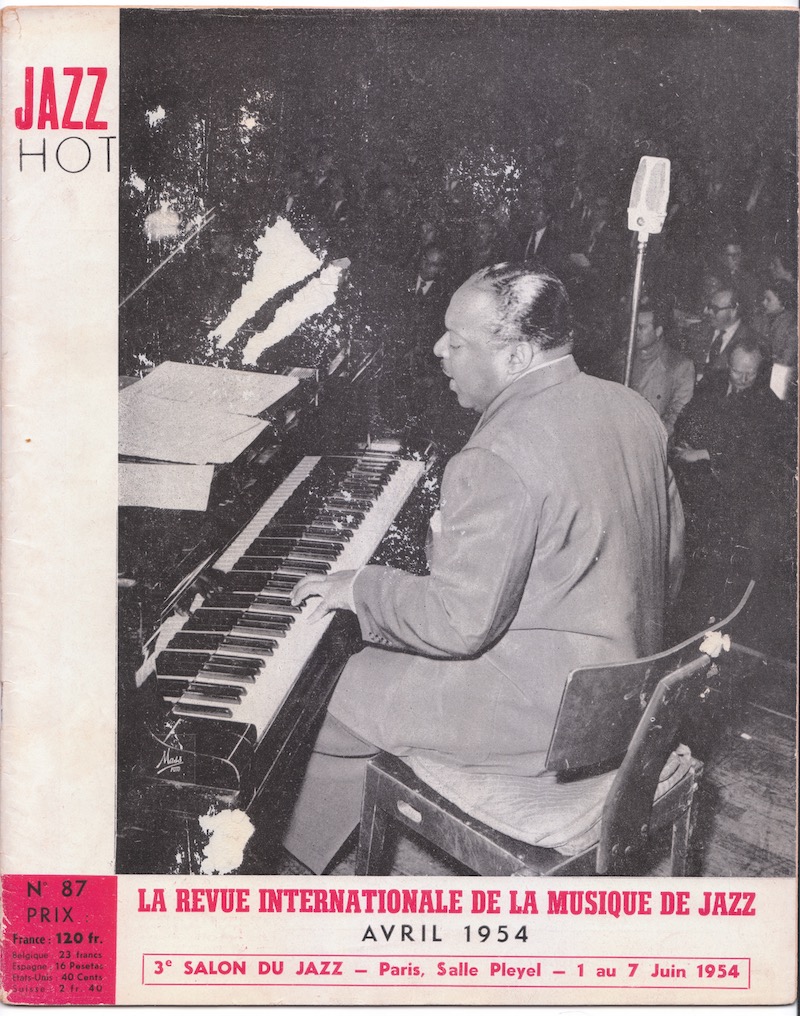
First Name Mentioned
« Merci de sa lettre à C. B. Peytavin. —Il me demande la chose suivante : « Pour le 3e Salon du jazz, on parle de faire venir des gens à la mode du jour, c’est-à-dire surtout Gerry Mulligan et ses joyeux plaisantins … »
« Revue de Presse par Boris Vian », Jazz-Hot, N° 87, 20e Année (2e Série), avril 1954, p. 19.
"Thanks to C.B. Peytavin for his letter.—He asked me the following: "For the 3rd Jazz Salon there is talk of bringing over people who are fashionable at the moment, in other words above all Gerry Mulligan and his cheerful bunch of jokers…."
Thelonious Monk Mentioned for the First Time
“Paris, Wednesday [April 7],—Thelonious Monk, pioneer bop pianist, has definitely been signed up for the Salon de Jazz (the Paris Jazz Fair), which will be held from June 2 to 7.
Negotiations are also proceeding for the Gerry Mulligan Quartet (with a trombone in place of trumpeter Chet Baker), former Cab Calloway trumpet man Jonah Jones, and the orchestra of Germany’s ‘Stan Kenton,’ Kurt Edelhagen.”
“Thelonious Monk for Paris Jazz Salon,” Melody Maker, Vol. 30, N° 1073, April 10, 1954, front page.
Press Release and First Draft Program
Exposition industrielle et commerciale
Le IIIe Salon du Jazz se distinguera des précédents, comme d’ailleurs de toutes les expositions industrielles et commerciales, par son aspect exceptionnel. En effet, l’ensemble des stands sera présenté suivant un thème unique : un décor inspiré par les vieux quartiers de la Nouvelle-Orléans.
Les deux précédents Salons avaient prouvé non seulement l’intérêt, mais également la nécessité d’une telle manifestation, tant sur le plan artistique que sur le plan industriel et commercial. En effet, elle donne l’occasion aux musiciens comme aux professionnels de la Musique, qu’ils soient fabricants ou revendeurs, de se rencontrer, d’apprécier les derniers perfectionnements techniques, ainsi que toutes les nouveautés réalisées dans leur domaine. Du plus haut intérêt pour le musicien amateur ou professionnel, cette exposition lui permet de faire son choix en connaissance de cause, puisque toute la production est soumise à son jugement.
On connaît le prestige dont jouissent mondialement les instruments fabriqués en France. Aussi toutes les grandes firmes participeront-elles à ce Salon. De son côté, le disque, qui tient une si grande place dans l’illustration de la musique de jazz, sera brillamment représenté. Toutes les firmes phonographiques, qui s’intéressent de plus en plus à cette musique, seront là. Un effort particulier sera même fait par certains éditeurs puisque, à l’occasion du Salon, les amateurs pourront se procurer des enregistrements encore inédits.
Grâce à sa présentation spectaculaire et à son ampleur, cette exposition attirera également le grand public et contribuera ainsi à mieux faire connaitre la musique de jazz et, par conséquent, à développer les industries et commerce qui s’y rattachent.
Manifestations artistiques
Toutes les manifestations du IIIe Salon du Jazz se dérouleront dans le cadre même de la Salle Pleyel.
De nombreux concerts auront lieu chaque jour dans la grande salle avec les différents solistes spécialement venus des États-Unis : Thelonious Monk, l’un des principaux promoteurs du jazz contemporain, le trompettiste Jonah Jones et « la plus sensationnelle révélation de 1953 », le quartette de Gerry Mulligan. Bien entendu, le populaire Sidney Bechet, Mary Lou Williams, Albert Nicholas, Don Byas et plusieurs autres artistes américains actuellement en Europe se joindront à ces vedettes. L’Italie nous enverra le « Roman New Orleans Jazz Band », l’Allemagne son meilleur orchestre : celui de Kurt Edelhagen, avec ses dix-sept musiciens, etc. Plusieurs groupements français sont également prévus.
Les demi-finales et finales du Tournoi des Orchestres amateurs se dérouleront les 5 et 6 juin, en matinée.
Les jours de semaine, des films seront projetés en matinée.
Un grand cabaret permettra aux amateurs, les concerts terminés, d’entendre les musiciens dans une ambiance différente. Ils n’auront pas ainsi à courir les quatre coins de Paris à la recherche de problématiques Jam sessions.
De nombreux voyages par groupes, facilités par les vacances de la Pentecôte, sont organisées, venant aussi bien de l’étranger que de province.
« 3e Salon International du Jazz : Sous le haut patronage de Monsieur le Ministre de l’Industrie et du Commerce, Paris, 1er au 7 juin 1954, Salle Pleyel », Jazz-Hot, N° 88, 20e Année (2e Série), mai 1954, pp. 8, 9.
Industry and Commerce Exhibition
The 3rd Jazz Fair will stand out from previous editions, as does every industrial and commercial exhibition by the way, due to its exceptional appearance. All the stands will be decorated based on a single theme: the decor is inspired by New Orleans' French Quarter.
The two previous Fairs had proved not only the interest but also the necessity that lies in such an event, both artistically and from an industrial and commercial standpoint. Indeed, it gives an opportunity to musicians, and music professionals whether manufacturers or distributors, to get together to appreciate the latest technical perfections, as well as the most recent new developments in their field. This exhibition of the greatest interest to the amateur or professional musician allows the latter to make his own choice in full knowledge of the facts, since here the entire production is submitted to his judgment.
We all know the prestige that is enjoyed worldwide by instruments made in France. And so all the great brands are present in this Fair. As for records, which play such an important role in the illustration of jazz music, they are represented brilliantly. All the record companies, whose interest in this music is on the increase, will be there. And some of these labels will even be making a particular effort because fans at the Fair will be able to obtain recordings that have not been released until now.
Thanks to its size and spectacular presentation, this exhibition will also attract the public and so contribute to make jazz music better known and, consequently, develop the industries and commerce with which it has ties.
Artistic events
All the events at the 3rd Jazz Fair will take place inside the Salle Pleyel setting.
Numerous concerts will take place every day in the main hall with the different soloists who have come specially from the United States: Thelonious Monk, one of the main promoters of contemporary jazz, the trumpeter Jonah Jones and, "the most sensational revelation of 1953,” the quartet of Gerry Mulligan. Obviously, the popular Sidney Bechet, Mary Lou Williams, Albert Nicholas, Don Byas and several other American artists currently in Europe will join those stars. Italy will be sending us the "Roman New Orleans Jazz Band,” and Germany its best orchestra, that of Kurt Edelhagen with his seventeen musicians, etc. Several French ensembles are also planned.
The semi-finals of the Amateur Orchestras Tournament will take place on the mornings of June 5 and 6.
On weekdays, films will be screened in the morning.
After the concerts have finished a large club will allow fans to hear the musicians in a different atmosphere. This means they will not have to run all over Paris in search of problematic jam sessions.
Numerous group-visits, made easier by the Whitsun holidays, have been organized, with visitors coming from abroad as well as the provinces.
(même dossier de presse)
« Le 3e Salon International du Jazz : Du 1er au 7 juin Paris sera le centre mondial du Jazz »
Combat, N° 3075, lundi 24 mai 1954, p. 6.
(same press release)
"The 3rd International Jazz Salon: From 1st to 7th June, Paris will be the world jazz centre”
«…La liste définitive des artistes américains, européens et français appelés à participer aux différentes manifestations prévues, ainsi que les jours et les horaires de leur passage sera précisée ultérieurement dans la Presse, en particulier : Le Figaro et dans Jazz-Hot de mai 1954. Un numéro spécial de J.H. sera du reste édité à l’occasion du Salon et vendu dans son enceinte.
Le Comité d’Organisation se réserve le droit de modifier l’ordre des différentes manifestations (toute modification sera du reste publiée en temps utile dans la Presse). »
« Programme des manifestations artistiques », Jazz-Hot, N° 88, 20e Année (2e Série), mai 1954, pp. 8, 9.
"...Details of the definitive list of the American, European and French artists called on to take part in the different manifestations planned, as well as the days and times of their appearances, will be given later in the press, particularly in: Le Figaro and in Jazz-Hot in May 1954. In this context a special issue of J.H. will appear at the time of the Salon and will be on sale inside. The Organising Committee reserves the right to modify the order of the various manifestations (all changes will appear in the press in due course)."
First French Feature Article
Finally, the long-awaited French feature article presenting Thelonious Monk in Jazz-Hot appears the month before, penned by Ny Renaud. It would be thanks to Ny and Henri Renaud that Monk would be present at the Salon:
En 1941, au cours d’une nuit au Minton’s, un jeune inconnu joua sur I Surrender Dear un chorus propre à faire pâlir n’importe quel pianiste d’aujourd’hui. Jerry Newman, l’homme des « Charlie Christian Memorial Albums » possède ce document qui vaudrait d’être publié, tant il est ahurissant d’y trouver tout ce qu’ont employé des centaines de musiciens quelques années plus tard : le jeu de main gauche, la marche harmonique, les variations mélodiques, les trouvailles rythmiques, tout y est, avec une incroyable avance…
Cet homme était Thelonious Monk.
Ce soir là, Thelonious fut sans doute visité par l’esprit créateur, car son chorus lui plaisait à tel point qu’il en réclamait toujours l’écoute à Jerry Newman, n’ayant jamais encore, disait-il « entendu jouer ainsi du piano » (cela eut l’effet malheureux d’user le disque souple et d’en empêcher la sortie commerciale).
Monk se doutait-il alors de la portée de ses trouvailles? Non sans doute, pas plus que le drummer Kenny Clarke qui l’assistait toutes les nuits dans le groupement de Joe Guy. Tous deux on pourtant amorcé le renouvellement rythmique et harmonique que la musique de jazz devait connaître en 1944-45. Il est d’ailleurs ahurissant d’entendre les parties de Kenny et de Thelonious au milieu de ces jam-sessions où se réunissaient autour d’eux des gens comme Joe Guy ou Al Sears…
Monk commença à jouer du piano à l’âge de 11 ans, apprenant seul, sans le secours d’un professeur. Peu de temps après, il tint l’orgue dans une église, pendant deux ans. Thelonious précise qu’il ne sait pas si cela l’a aidé pour le piano, ou au contraire… Vers 15 ou 16 ans, il se met au jazz écoutant alors Tatum, Fats Waller, Hines, Wilson, J.-P. Johnson, C. Hopkins. Et, dit-il : « J’était tellement fatigué des accords entiers de la musique religieuse que j’avais besoin d’entendre autre chose. C’est pourquoi j’inventais de nouvelles mélodies avec des accords inédits, sur des rythmes qui me venaient librement, sans y penser… »
Cela donna ce que l’on sait. Et, vers 1942, Monk enseigna beaucoup de choses à Dizzy Gillespie, qui les transmit ensuite à ses premiers jeunes partenaires, tels George Wallington, Milt Jackson, etc.
On sait aussi que tous les jeunes jazzmen se pressèrent au Minton’s durant les années 1942-44 pour y entendre les pionniers de la musique moderne. Duke Jordan reporte qu’il y retrouvait John Lewis, Al Haig, Walter Bishop et Bud Powell. Ce dernier, de plus, se rendait chaque jour à la maison de Monk et Thelonious dit que « Si Bud était plus bavard, il pourrait raconter tout ce qu’il y apprit. »
Interrogez tous les musiciens modernes, de tout âge et de tout style. Demande à Gillespie ou B. Brookmeyer, Teddy Wilson ou Horace Silver, Sonny Rollins ou Al Cohn ce qu’ils pensent de Thelonious. Tous vous diront quelle admiration enthousiaste ils ont pour lui.
Aussi, pourquoi le nom de Monk n’est-il pas plus répandu dans le grand public? Pourquoi aussi n’est-il pas plus apprécié en Europe, par les musiciens mêmes? Parce que sa musique est aussi anti-commerciale que difficile à apprécier, aux premières auditions. La critique américaine, un fois de plus, a fait montre d’une incompréhension totale envers cet incomparable créateur. La publicité la plus normale ne lui a jamais été faite. Et ceci, il faut le préciser, n’est pas étranger à sa couleur de peau. Car, quoiqu’on en dise, si les noirs aux États-Unis ont conquis de force certains droits, au fond des esprits le racisme reste encore vivace. Ne prenons pour exemple que le cas de Clifford Brown. C’est le meilleur trompette actuel. Bénéficiera-t-il un jour de l’énorme publicité qu’on a faite à Chet Baker[•]?
Le style de Monk est anti-commercial, disions-nous. En effet, il est aussi « fermé » au public qu’est facile celui de Shearing. Autant le pianiste anglais joue une musique bien « emballée », autant celle de Monk est rude. La conception rythmique shearingienne est aussi linéaire et monotone que celle de Thelonious est vivante et variée. On peut comparer la musique de Shearing à une production hollywoodienne en technicolor, avec tout l’affadissement désiré. Celle de Monk au contraire est celle d’un artiste puissant. L’une est jolie, l’autre est belle.
Les découvertes harmoniques et rythmiques que Monk fit il y aura bientôt quinze ans ont été en partie assimilées et l’on peut dire même qu’aujourd’hui elles sont standardisées. Mais, sous les doigts de Monk, elles restent neuves. Car Thelonious utilise des renversements originaux et rythmiquement surtout il est nettement resté le musicien le plus audacieux. En effet, ses phrases sont truffées des accentuations les plus inusitées et les plus inattendues. C’est sans doute par cela que son jeu rayonne si intensément. À ce propos, nous ne saurions mieux faire que de citer ce que disait récemment Teddy Wilson dans « Down Beat » : « Monk est le pianiste le plus à l’aise dans les tonalités inhabituelles et les rythmes complexes. Il n’a pas assez de technique pour pouvoir communiquer à tout le monde tout ce qu’il a à dire, mais je suis toujours formidablement impressionné par son sens parfait du tempo. »
Thelonious n’a évidemment pas une technique à la mesure de son talent. Il avoue lui-même qu’il est trop paresseux pour travailler son instrument, et c’est peut-être mieux ainsi car, nanti d’une articulation classique, Monk n’aurait sans doute pas eu cette manière indescriptible de frapper la note.
Teddy Wilson ne parle pas de la sonorité de Thelonious sur laquelle nous devons insister tant elle est belle. C’est assurément l’une des plus émouvantes, particulièrement à l’audition directe, car la majorité des disques la rendent mal. Ainsi l’album Prestige en trio, a été mal enregistré et médiocrement pressé, ce qui fait sonner le piano d’une manière étrangement « fêlée ». Par contre, les premiers enregistrements faits pour Blue Note (publiés en France par Vogue) mettent bien en valeur la sonorité de Monk.
D’ailleurs, dans quelque semaines, le public parisien sera à même d’apprécier tant la sonorité que tout le jeu de Monk. En effet, la salle Pleyel, où se sont produits nombre de grands solistes, aura cette fois sur sa scène l’ « une des plus puissantes personnalités du jazz », dont, sans nul doute, le style « passera la rampe » tant il reste frais. Car que ce soit au studio ou dans un club, Thelonious, dès qu’il s’assied au piano, n’est plus le même homme. Aussi renfermé que calme et paresseux auparavant, il semble entrer en transe dès les premières notes, chantonnant, « vivant » tout ce qu’il joue. Œuvre à la fois complexe et sauvage dont on constate, après que l’on soit familiarisé avec elle, tout ce que lui doivent les jazzmen actuels. Pensons seulement qu’il écrivit Off Minor en 1942… On sait d’ailleurs quel compositeur fécond est T. Monk.
Son morceau le plus connu, ‘Round about Midnight, reste l’une des plus grandes réussites de la musique de jazz. Il est fort regrettable que Thelonious n’en ait pas enregistré une version en solo, plutôt que la gravure en quintette, où comme l’on sait, le trompettiste et l’altiste sont assez médiocres.
Parmi ses meilleurs œuvres, citons également Ruby My Dear, Reflections.
En ces temps de standardisation musicale, Thelonious Monk donne un bain de jouvence à tout ce que nous avons l’habitude d’entendre parce qu’il évite toujours instinctivement le cliché rebattu, qu’il a une manière unique de transformer et d’enrichir à la fois n’importe quelle mélodie par la seule vertu d’un phrasé unique. Par dessus tout, c’est un swingman hors de pair.
Tous ces éléments font que les plus « avancés » des progressistes sont encore dépassés par Monk. Prisonniers de quelques formules, ils deviennent rapidement lassants. En écoutant les disques de Thelonious, au contraire, on découvre toujours quelque détail nouveau, quelque trouvaille qui avait échappé aux auditions précédentes, tant est riche en dons créateurs ce grand musicien.
Souhaitons que sa venue en Europe lui donne la place qui lui revient : celle d’un des novateurs les plus importants et d’un des pianistes les plus originaux.
N. Rémy
« Thelonious Monk par N. Rémy [Ny Renaud] », Jazz-Hot, N° 88, 20e Année (2e Série), mai 1954, pp. 13, 19.
One night at Minton’s in 1941, a young unknown played a chorus on 'I Surrender Dear' that would have made any of today's pianists turn pale. Jerry Newman, the man known for the "Charlie Christian Memorial Albums", has this document in his possession, a recording that would be worth publishing given how astounding it is to hear everything that hundreds of musicians would put to use a few years later: the way the left hand played, the sequences, melodic variations, rhythmic findings... it was all there, incredibly in advance of its time...
The unknown man was Thelonious Monk.
That night, Thelonious Monk was no doubt visited by the creative spirit, as he liked his chorus so much that he would always ask Jerry Newman if he could listen to it again, having never yet, he said, "heard anyone play piano like that." (This would have the unfortunate effect of wearing out the flexi disc and preventing its commercial release.)
Did Monk suspect at the time how important his finds were? Probably not, no more than drummer Kenny Clarke, who was assisting him every night in Joe Guy's group. Both of them, however, launched the revival in rhythm and harmony that jazz music experienced in 1944-45. On that subject, it's hair-raising to hear the contributions of Kenny and Thelonious in the midst of those jam sessions where they found themselves in the company of people like Joe Guy or Al Sears...
Monk began playing the piano at the age of 11, learning alone without the help of a teacher. A little while later he became the organist in a church for two years. Thelonious points out that he doesn't know if that helped him with the piano or the contrary... At around 15 or 16 he took an interest in jazz, listening then to Tatum, Fats Waller, Hines, Wilson, J.-P. Johnson, C. Hopkins. And, he says, "I was so tired of the whole chords in church music that I needed to hear something else. That's why I invented new melodies with chords nobody had heard before, with rhythms that just came freely without me thinking about it..."
We know what the result of that was. And, in around 1942, Monk taught a lot of things to Dizzy Gillespie, who transmitted them later to his first young partners such as George Wallington, Milt Jackson, etc.
It's also a known fact that all the young jazzmen were crowding into Minton's in the years 1942-44 to hear the pioneers of modern music who were there. Duke Jordan reports it was there that he used to meet John Lewis, Al Haig, Walter Bishop and Bud Powell. The latter would also go over to Monk's house every day, and Thelonious says that, "If Bud was more talkative he could tell us everything he learned there."
Ask all the modern musicians, whatever their ages and styles. Ask Gillespie or B. Brookmeyer, Teddy Wilson or Horace Silver, Sonny Rollins and Al Cohn what they think of Thelonious. They'll all tell you how much enthusiasm and admiration they have for him.
So why isn't the name of Monk more widespread among the public? Why, too, isn't he more appreciated in Europe by the musicians themselves? Because his music is as anti-commercial as it is difficult to appreciate on a first hearing. American critics have yet again shown a total lack of understanding with regard to this incomparable creator. (Monk) has never received even the commonest publicity. And that, it has to be said, is not foreign to the colour of his skin. Because no matter what people say, while black people in the United States have used force to conquer certain rights, racism is still very much alive at the back of some minds. Just take the case of Clifford Brown as an example. He is the best trumpeter at the moment. Will he benefit one day from the enormous publicity given to Chet Baker[•]?
We were saying that Monk's style is anti-commercial. Indeed, it's as "closed" to the public as Shearing's style is wide open. While this English musician plays music that's nicely "wrapped up," that of Monk is hard. Shearing's rhythm concepts are as linear and monotonous as those of Thelonious are lively and varied. You can compare Shearing's music to a Technicolor Hollywood production, with all the loss of flavour you could want. The music of Monk, on the contrary, is that of a powerful artist. The former is pretty, the latter is beautiful.
The discoveries in harmony and rhythm that Monk made (almost fifteen years ago by now), have been partly assimilated and you might even say that today they've become standardized. But beneath the fingers of Monk they remain new. For Thelonious makes use of original inversions and, especially in rhythm, he has clearly remained the musician with the most audacity. His phrases bristle with accents that are most uncommon, and the most unexpected. This is probably the reason why his playing beams out so intensely. And on that subject, there's no better way to put it than in Teddy Wilson's words when writing in "Down Beat": “He's the pianist who's the most at ease with unusual tone scales and complex rhythms. He hasn't enough technique to be able to communicate all he has to say to everybody, but I've always been wonderfully impressed by his perfect sense of time."
Thelonious obviously doesn't have a technique on the same scale as his talent. He himself admits to being too lazy to work on his instrument, and perhaps it's better that way, because if Monk had been given classical fingering he probably wouldn't have had that indescribable manner in which he hits the note.
Teddy Wilson doesn't talk about the sound of Thelonious, but we have to insist on it because it's so beautiful. Certainly it's one of the most moving, particularly when heard directly, as most records render sound badly. The trio album for Prestige is badly recorded and the pressings are mediocre, causing the piano to sound strangely "cracked." On the other hand, the first records for Blue Note (released in France by Vogue) succeed in highlighting Monk's sound.
Incidentally, in a few weeks the French public will have the chance to appreciate the sound of Monk as much as his playing: this time, the stage at Salle Pleyel, where numerous great soloists have appeared, will this time see "one of the most powerful personalities in jazz" whose style will doubtless "get across" to the audience because of its freshness. Because Thelonious, whether in a studio or a club, is no longer the same man once he sits down at the piano. As withdrawn as he was calm and lazy before, he seems to enter a trance right from the very first notes, humming and "living" everything he plays. His work is at the same time complex and wild, and once you are familiar with it you can observe everything that today's jazzmen owe him. Just think: he wrote 'Off Minor" in 1942… And we know how prolific T. Monk is as a composer.
His most well-known piece, '‘Round about Midnight,' remains one of the most accomplished compositions in jazz. It is highly regrettable that Thelonious hasn't recorded a solo version of it, rather than the quintet recording in which, as we've seen, the trumpeter and the alto player are rather mediocre.
Among his best works we can also mention 'Ruby My Dear' and 'Reflections.'
In these days of musical standardization, Thelonious Monk gives everything we're used to hearing a bath in the fountain of youth, because out of instinct he always avoids the hackneyed cliché, and has a unique manner of transforming, and at the same time enhancing, any and every melody by the single virtue of unique phrasing. Above all, when it comes to swing he's a man without peer.
The result of all those elements is that the most "advanced" progressive musicians are still surpassed by Monk. As prisoners of various formulae they are rapidly becoming tiresome. Listening to records by Thelonious, on the contrary, one can always discover some new detail, some find, that has escaped previous listening, so rich in creative gifts is this great musician.
We can wish for him that his visit to Europe gives him the place he deserves: that of one of the most important innovators, and one of the most original pianists.
The Renauds
Henri Renaud and Thelonious Monk
In the November 1953 issue of Jazz-Hot, Henri Renaud confided in Marcel Romano:
«…L’audition des disques de George Wallington, puis d’Horace Silver m’a fait découvrir Th. Monk. J’avoue, à ma grande honte, n’avoir pas compris sa musique jusqu’alors : c’est pourtant la base de tout. En effet, que l’on aime ou pas non Monk, il faut bien reconnaître qu’harmoniquement et par son jeu de main gauche, il est le fondateur du style de piano d’aujourd’hui. Au fond, il y a deux personnalités de base : Lester et Monk. Leurs influences combinées ont donné Parker, Bud Powell, etc…»
« Henri Renaud par Marcel Romano », Jazz-Hot, N° 82, 19e Année (2e Série), novembre 1953, p. 18.
"...Listening to records by George Wallington and later Horace Silver made me discover Th. Monk. To my great shame I have to confess that until then I hadn't understood his music; and yet it's the basis of everything. Whether you like Monk or not, you have to admit that harmonically, and in his use of his left hand, he is the founder of today's piano style. In fact there are two basic personalities: Lester and Monk. Their combined influences have given us Parker, Bud Powell, etc…."
The Renauds in NY
Ny and Henri arrived in New York on Saturday, December 19, leaving Le Havre on Saturday, December 12, 1953[•], after producing a series of recordings for Vogue including a George Wallington. They stayed at George and Billie Wallington’s apartment[•] at 103, West 77th St., New York, NY[•]. They came back on Wednesday, March 24, 1954[•]. Henri was in New York “to see and hear for himself all those musicians to whom we've been listening on records for a few years,[•]", but also as the executive producer, producer, supervisor and musician (still for Vogue), for Duke Jordan's first album as a leader (January 28), for his own band (February 28, March 7), as co-leader with Al Cohn (March 5), for an Al Haig Trio on March 13, and for an Oscar Pettiford Sextet on March 21[•].
It is difficult to know how, where and when the Renauds met Thelonious Monk, as Henri Renaud gave imprecise and contradictory information in interviews many years later, but it was definitely early on at the beginning of their stay, as proved by the photo (taken at Birdland with Art Blakey and Duke Jordan) that illustrates the article that Jazz-Hot published in its February 1954 issue; it was probably taken on Monday, January 4, 1954. In this article Henri Renaud describes the performances of Duke Ellington[•], Bud Powell[•], Count Basie[•], the Monday jam sessions of December 28, 1953[•] and "the following Monday" January 4, 1954[•]; Renaud also announces that the "Monday, January 12 ... will be heard…."[•]
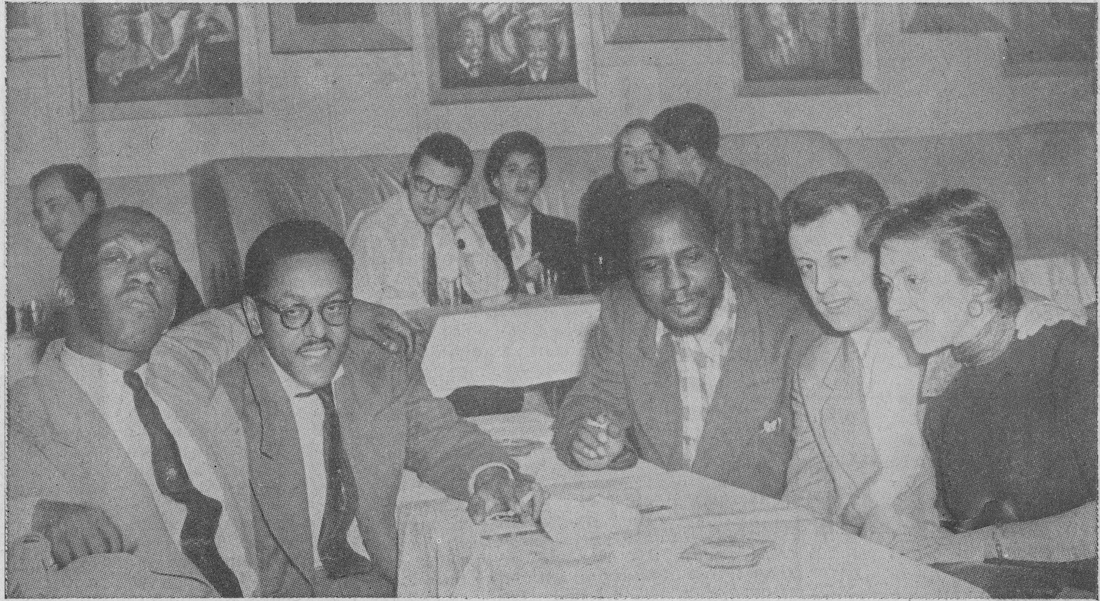
The following month in Jazz-Hot March 1954, Ny Renaud followed the article by Henri in the column "News of America”:
« …Voilà pour le Birdland. Quant aux clubs ouverts seulement pour le week-end, le Tony’s Café, à Brooklyn est sans nul doute le plus intéressant. Jugez-en par les programmes présentés depuis Noël : Kenny Dorham Quintet (A. Blakey-D. Jordan), Thelonious Monk Quintet (S. Rollins, Willie Jones, dm)… Cependant la prestation de Thelonious Monk au Tony’s est une chose remarquable parce que Monk ne se produit que très rarement, ce que l’on doit regretter vivement, car Thelonious, en pleine maturité, joue une musique originale (au vrai sens du mot). Comme le faisait récemment remarquer Teddy Wilson, “c’est le pianiste le plus à l’aise dans les tonalités étranges et les rythmes excentriques. Il n’a pas assez de technique pour pouvoir communiquer à tout le monde tout ce qu’il a à dire, mais je suis toujours formidablement impressionné par son sens parfait du tempo.” On peut ajouter à cela que la sonorité de Monk est délectable, qu’il swingue continuellement et qu’avec le recul il est aisé de voir tout ce que lui ont pris des pianistes comme Bud Powell pour ne citer que celui-là… Thelonious est accompagné à la batterie par Willie Jones, un jeune drummer de la lignée de Blakey, quoique possédant un style assez personnel notamment quant à la puissance de frappe et à l’esprit de ses soli, d’une sauvagerie qui évoque réellement les rythmes africains… »
« Jazz-Hot Magazine : Nouvelles d’Amérique par N. Rémy [Ny Renaud] », Jazz-Hot, N° 86, 20e Année (2e Série), mars 1954, p. 20.
“ ...So that's Birdland. As for the other clubs open only at weekends, Tony’s Café in Brooklyn is probably the most interesting. You can judge from the acts presented since Christmas: Kenny Dorham Quintet (A. Blakey-D. Jordan), Thelonious Monk Quintet (S. Rollins, Willie Jones, dm)….Thelonious Monk's appearance at Tony’s is a remarkable thing because Monk is only very rarely visible, for which we must be very sorry because Thelonious, in his prime, is playing music that is original (in the true sense of the word). As Teddy Wilson recently pointed out, ‘He's the pianist who's the most at ease with unusual tone scales and complex rhythms. He hasn't enough technique to be able to communicate all he has to say to everybody, but I've always been wonderfully impressed by his perfect sense of time.’ To that you can add that the sound of Monk is exquisite, that he swings continually, and that with hindsight it's easy to see what pianists like Bud Powell have borrowed from him, to name only the latter…. Thelonious is accompanied on drums by Willie Jones, a young drummer in the Blakey tradition despite his rather personal style, notably in the force behind his drum hits and the spirit of his solos, which have a savagery that really evokes African rhythms…."
Henri would also talk about Thelonious Monk at Tony's Café in an interview published in October 1954:
« …On retrouve tous ces musiciens les lundis dans les petits clubs qui n’ouvrent que pour le week-end, l’ « Open Door » et le « Chantilly », au Greenwich Village, et le « Tony’s Café » à Brooklyn, une toute petite boîte qui rappelle un peu le « Kentucky », perdue dans le quartier noir de Brooklyn, et qui présentait, la première fois que nous y sommes allés, le Quintette de Thelonious Monk, avec Sonny Rollins et un extraordinaire jeune batteur, Willy Jones. Nous étions là les seuls blancs, ma femme et moi, parmi une foule de jeunes noirs qui dansaient, prouvant ainsi, s’il en était encore besoin, qu’on peut danser sur la musique de Monk. Une autre fois, j’ai eu la chance d’assister à une session inoubliable où, toujours autour de Monk, étaient réunis Miles Davis, Gigi Gryce, Charlie Mingus et Max Roach… »
« Trois mois à New York : Une Interview d’Henri Renaud par J. Lachelier [possibly a pseudonym] », Jazz-Hot, N° 92, 20e Année (2e Série), octobre 1954, p. 15.
"...You can find all these musicians on Mondays in the little clubs that are only open at weekends: the 'Open Door' and the ‘Chantilly,' in Greenwich Village, and 'Tony’s Café' in Brooklyn, a tiny club that reminds you a little of the ‘Kentucky,' lost in the black quarter of Brooklyn, and which, the first time we went there, was featuring the Quintet of Thelonious Monk, with Sonny Rollins and an extraordinary young drummer, Willy Jones. My wife and I were the only whites there, in a crowd of young black people who were dancing. Which is proof, if that is still necessary, that you can dance to the music of Monk. Another time I was lucky to see an unforgettable session there, again with Monk, that brought together Miles Davis, Gigi Gryce, Charlie Mingus and Max Roach…."
No information appears in Jazz-Hot about Monk coming to the 3rd Jazz Show during the Renauds' stay in New York, nor about their role in Monk's visit. The following was in 1959, with Henri Renaud answering Philippe Kœchlin's questions in an interview devoted to his second trip to New York:
« Avez-vous vu Monk?
—Non, pas cette fois. En 1954 je l’avais beaucoup fréquenté. J’étais allé souvent chez lui et ma femme et moi avions même arrangé sa venue au Festival de Paris [Salon du Jazz] de la même année…
Souvenez-vous que Jazz Selection avait publié ses premiers disques Blue Note en 1949, disques qui n’avaient eu aucun succès auprès de la critique, pas plus que sa prestation à Pleyel où il avait magnifiquement joué (les disques enregistrés au cours des retransmissions de radio faites pendant le Festival le montrent bien).
Laissez-moi vous dire que son comportement sur scène, jugé anti-commercial à l’époque, ‘passerait’ maintenant la rampe et serait sans doute qualifié d’original. »
« Henri Renaud : « New York reste vraiment la ville du jazz », propos recueillis par Philippe Kœchlin », Jazz-Hot, N° 148, 25e Année (2e Série), novembre 1959, p. 17.
"Did you see Monk?
—No, not this time. I saw him a lot in 1954. I often went over to his home and my wife and I had even arranged for him to come to the Festival de Paris [Salon du Jazz, or Jazz Fair] that same year….
Remember that Jazz Selection had published his first Blue Note records in 1949, records that had no success at all with the critics, no more than his performance in Pleyel where he'd played magnificently (the recordings made during the radio broadcasts from the Festival show this well).
Let me tell you that his behaviour onstage, judged anti-commercial at the time, would 'get across' to the public now and would no doubt be qualified today as original."
Thelonious Monk in Paris, Monday, May 31 - Thursday, June 10, 1954
Monday, May 31, 1954
Jacques André, who wrote a jazz column for Combat, announced the Salon in the daily press, but left it to his friend Jacques Sautès to make reference to Monk the following day:
Voici enfin l’événement le plus marquant de ces deux dernières années jazzistiques : le 3e Salon du Jazz. Ainsi, sans interruption, quelques-uns des plus célèbres musiciens français et étrangers se feront entendre du 1er au 7 juin à la Salle Pleyel.
Dans le hall de cette imposante salle de concerts se tiendra le salon proprement dit, exclusivement réservé aux exposants : Éditeurs, compagnies de Disques et d’instruments de musique, expositions de toiles et photographies inédites etc… Ces stands, étudiés de façon à évoquer une rue de la Nouvelle-Orléans, auront nécessité l’emploi de 3.000 m2 de contre-plaqué pour leur construction.
A premier étage, la salle de Judo à été transformée en cabaret-dancing du plus pur style New-Orléans. Mais que les amateurs de jazz se rassurent, malgré le cadre, ils pourront y entendre du jazz « primitif » aussi bien que du « jazz évolué ». C’est en effet dans ce cabaret que Bobby Forest présentera de 16 h à 19 h 30 et de 23 h à 2 heures du matin, toutes les vedettes prévues au salon. C’est là que, pour la première fois, l’Académie du Jazz décernera son « oscar » du meilleur disque de jazz de l’année, vendredi prochain à 13h 30. Au cours de cette manifestation, où tous les amateurs de jazz sont invités, l’Académie au grand complet révélera le nom du musicien qui obtiendra le prix Django Reinhardt. Prix destiné à récompenser le meilleur soliste français de l’année.
Ajoutons pour les chasseurs d’autographes que Thelonious Monk, Gerry Mulligan et Jonah Jones arriveront aujourd’hui à 12h 30 à Orly.
La participation française
La presque totalité des musiciens français les plus réputés se fera entendre au cours des concerts : Martial Solal et son trio, Henri Renaud qui, avec trois formations différentes jouera des arrangements d’Al Cohn, Pierre Michelot avec Roger Guérin, Benny Vasseur, René Urtreger et quelques autres présentera un orchestre qui swingue, Michel de Villers, Géo Daly et l’orchestre de la Rose Rouge interpréteront les fameux arrangements de Christian Chevalier. La nouvelle génération sera représentée par Hubert Fol, Sacha Distel, J.-M. Ingrand, J.-L. Viale et René Urtreger. En « Nouvelle-Orléans », Luter, Attenoux, Braslawsky et Réwéliotty se partageront les honneurs.
La sensationnelle grande formation d’Aix Combelle sera également présente, tandis que Jack Diéval se produira avec l’orchestre se la radio sarroise.
Applaudissons donc les efforts des organisateurs. Efforts qui permettront à ces brillants musiciens de jouer la musique qu’ils aiment sans la moindre concession.
Participation européenne
Comme pour chaque festival, nous sommes heureux d’enregistrer la participation de différents groupements européens de premier plan inédits pour le public français.
La Sudwesrfunk envoie l’orchestre de Kurt Edelhagen, que beaucoup considèrent comme la meilleure grande formation européenne, et dont on appréciera certainement la perfection technique.
Max Bruel, le rival danois de Lars Gullin, dirigera une des meilleures formations scandinave et représentera pour la première fois le Danemark en France.
La fédération britannique du Jazz délègue Joe Harriott, un alto noir, et le Tony Kinsey Trio, qui vient de se distinguer récemment à Londres et qui comprend le vibraphoniste Bill Le Sage, le bassiste Sammy Stokes, Kinsey étant à la batterie.
Notons que pour la première fois—sur la base d’échange—un orchestre français, celui de Michel Attenoux, ira donner un concert à Londres le 7 juin.
De Suède, un orchestre amateur vient disputer les finales du Tournoi international.
Signalons enfin que la R.A.I. (Italie), la Radio danoise, la Sudwestfunk (Allemagne), l’I.N.R. (Belgique), Sarrebruck, la B.B.C., Radio-Tanger et la Radio française, retransmettront des extraits des concerts du Troisième Salon du Jazz.
Les trois étoiles
La participation américaine sera naturellement la plus attendue. Ne parlons pas de Sidney Bechet, Albert Nicholas, Nelson Williams, Peanuts Holland, Don Byas et Mary Lou Williams que nous connaissons déjà et que nous retrouverons avec le même plaisir. Ces musiciens seront certainement moins entourés que les trois étoiles de cette série de manifestations : Gerry Mulligan, Thelonious Monk, Jonah Jones.
Le nouveau quartette de Gerry Mulligan se compose actuellement de Bill Anthony (basse), Frank Isola (drums) et Bob Brookmeyer (trombone). Ce dernier remplace le trompette Chet Baker. Avec son groupement aux formules avancées, Gerry Mulligan est le musicien qui a révolutionné le monde du jazz au cours des mois précédents. Soliste, arrangeur, compositeur et chef de file, gageons qu’il passionnera le public par ses nombreuses qualités.
Jonah Jones se classe dans cette catégorie de musiciens talentueux qui ne se sont jamais imposés par manque de publicité. Pourtant il possède plusieurs qualités souvent enviées des autres solistes parfois plus connus du public. Sa belle sonorité, son attaque puissante, ses nombreuses idées, tout cela fait partie de son jeu délectable.
Bref, comme vous le voyez, il y en aura pour tous les goûts et je suis persuadé que le Troisième Salon du Jazz sera pendant longtemps l’objet de nos conversations.
« Le troisième Salon du Jazz : Les plus célèbres musiciens français et étrangers accueilleront plus de 150.000 visiteurs », par Jacques André, Combat, N° 3081, lundi 31 mai 1954, p. 2.
Now, finally, we come to the most newsworthy event of these past two years in jazz circles: the 3rd Jazz Fair. Without a break, some of the most famous French and foreign musicians will make themselves heard from June 1st to 7th at the Salle Pleyel.
In the hall of this imposing concert venue will be the Fair itself, reserved exclusively for the exhibitors: publishers, record companies and instrument makers, an exhibition of previously unseen paintings and photographs, etc... These stands, designed so as to recall a street in New Orleans, have entailed the use of some 3,000 square meters of plywood for its construction.
The judo room on the first floor has been transformed as a club/dancehall in the purest New Orleans style. But jazz lovers needn't worry: despite the setting, they'll be able to hear 'primitive' jazz as well as 'advanced' jazz. Because it's here in this club that Bobby Forest will be presenting, from 4 p.m. to 7:30 p.m. and from 11 p.m. to 2 a.m., all the stars scheduled to appear at the Fair.
It's here that, for the first time, the 'Académie du Jazz' will award its 'Oscar' for the best Jazz Record of the Year, next Friday at 1:30 p.m. In the course of this event, to which all jazz lovers are invited, the full Academy will be announcing the name of the musician who will receive the Django Reinhardt Prize rewarding the Best French Soloist of the Year.
For autograph hunters, we add that Thelonious Monk, Gerry Mulligan and Jonah Jones will arrive today at Orly at 12:30 p.m.
French participants
Practically every French musician of renown can be heard in the course of these concerts: Martial Solal and his trio; Henri Renaud, who will be playing Al Cohn arrangements with three different groups; Pierre Michelot with Roger Guérin, Benny Vasseur, René Urtreger and a few others will present an orchestra that swings; Michel de Villers, Géo Daly and the orchestra from the Rose Rouge will be performing the famous arrangements of Christian Chevalier. The new generation will be represented by Hubert Fol, Sacha Distel, J.-M. Ingrand, J.-L. Viale and René Urtreger. In "New Orleans," Luter, Attenoux, Braslawsky and Réwéliotty will be sharing the honours.
The sensational big band of Alix Combelle will also be present, while Jack Diéval will appear with the orchestra of Radio Saarland.
So let's applaud the efforts of the organizers. These efforts will allow these brilliant musicians to play the music they love without the slightest concessions.
European participants
As at every Festival, we're happy to note first-time participants from various first-rate European bands.
The Sudwestfunk is sending Kurt Edelhagen's orchestra, considered by many to be the best big band in Europe, a technically perfect ensemble that is certainly appreciated.
Max Bruel, Lars Gullin's Danish rival, will lead one of the best Scandinavian bands and represent Denmark here for the first time.
British Jazz Federation is delegating Joe Harriott, a black alto, and the Tony Kinsey Trio which has just distinguished itself in London, with vibraphone player Bill Le Sage, bassist Sammy Stokes, and drummer Kinsey.
Note that for the first time—on an exchange basis—a French orchestra, the one led by Michel Attenoux, will go to London to give a concert on June 7.
From Sweden, an amateur band will be taking part in the final rounds of the Amateur Tournament.
Finally, the R.A.I. (Italy), Danish Radio, the Sudwestfunk (Germany), the I.N.R. (Belgium), Radio Sarrebruck, the B.B.C., Radio-Tanger and French Radio will be broadcasting excerpts from the concerts at the 3rd Jazz Salon.
The three stars.
The American participants will naturally be the most awaited. We won't talk about Sidney Bechet, Albert Nicholas, Nelson Williams, Peanut Holland, Don Byas or Mary Lou Williams, whom we know already and will be seeing again with the same pleasure. The latter musicians will no doubt be attracting less attention than the three stars in this series of events: Gerry Mulligan, Thelonious Monk and Jonah Jones.
The new quartet of Gerry Mulligan is currently made up of Bill Anthony (basse), Frank Isola (drums) and Bob Brookmeyer (trombone). The latter is the replacement for trumpeter Chet Baker. Leading groups with advanced formats, Gerry Mulligan is the musician who has revolutionized the jazz world over previous months. As a soloist, arranger, composer and leader, it's a good bet that the public will be thrilled by his many qualities.
Jonah Jones can be classified in that category of talented musicians who have never asserted their authority due to a lack of publicity. And yet he possesses several assets often envied by other soloists sometimes more known to the public. His beautiful sound, his powerful attack, his many ideas, all of it forms part of his delectable playing.
To resume, something for all tastes, as you can see, and I'm convinced that the Third Jazz Fair will be the subject of all our attention for a long time.
Aéroport d’Orly, Seine
All the American musicians who came from the USA to take part in the Salon arrived in Paris on the same flight, Air France 076, on Monday, May 31, 1954[•]: Elliott Jones, Gerald Mulligan and wife Arlyne Mulligan, Frank Isola, Robert Brookmeyer, Keith Mitchell, and Thelonious Monk. As for Don Byas[•], Buddy Banks[•] Art Simmons[•], Sidney Bechet[•], Jimmy Gourley[•], Nelson Williams[•], Jay Cameron[•], Mary Lou Williams[•], Albert Nicholas[•] and Lalo Schifrin[•], they were already in Paris.
The American visitors returned separately: first Robert Brookmeyer, Frank Isola and Keith Mitchell, on Tuesday, June 8[•], followed by Thelonious Monk on Thursday June 10[•], then Arlyne and Gerald Mulligan on Sunday June 13[•], and finally Elliott Jones on Friday, September 24[•].
The author of the sleeve notes for the 10” LP Thelonious Monk Piano Solo, Swing M. 33.342, probably Charles Delaunay, would report this anecdote[•]:
« On peut se rapporter à ce propos l’anecdote de Bob Brookmeyer—un fanatique de Monk—qui déclarait à sa descente d’avion à Orly : —Rendez-vous compte, je viens de faire le voyage assis à côté de Thelonious! »
"On this point we can refer to this anecdote from Bob Brookmeyer—a Monk fanatic—who declared when he left the aircraft at Orly: "Do you realize, I just spent the whole trip sitting next to Thelonious!"
Rue La Boétie, Paris VIII
Probably dropping off the luggage at the hotel.
Salle Pleyel, 252, Fg St-Honoré, Paris VIII
Probably afterwards, there was a photo session for the “three stars” of the Salon in the decor of the Salle Pleyel as you can see from this photo published in Le Figaro the next day, Tuesday, June 1[•]:
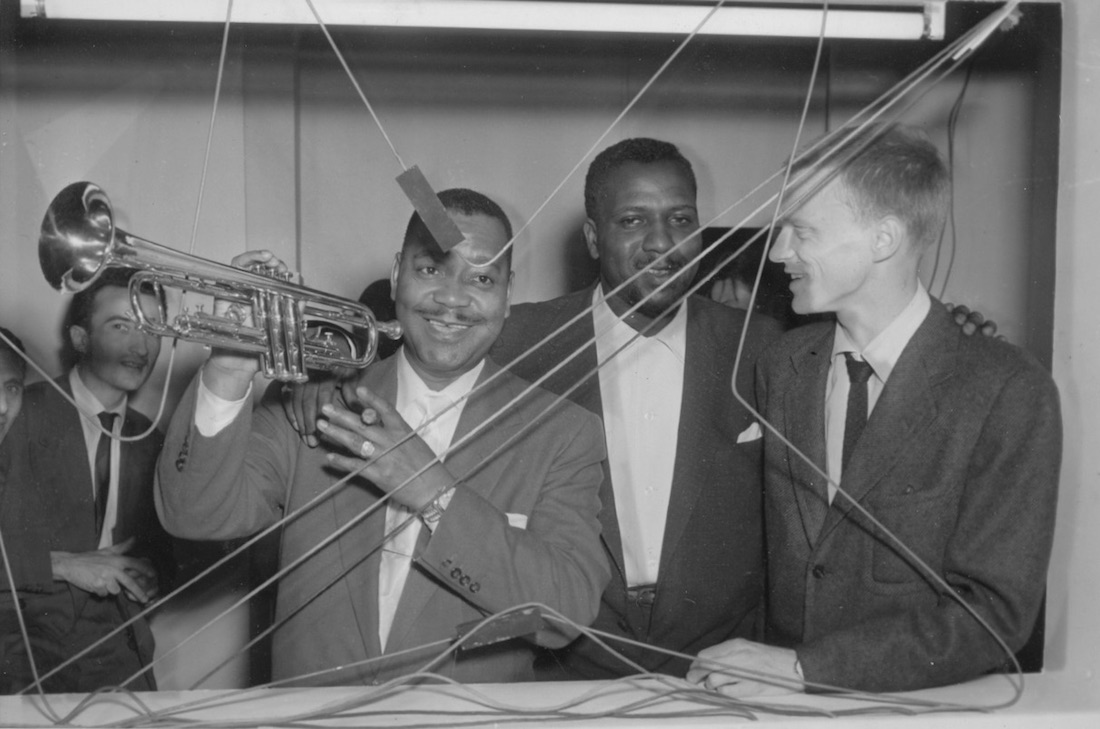
(Dominique Cravic Collection)
Rue du Sommerard, Paris V
Jean-Louis Viale and Jean-Marie Ingrand, and later Marcel Romano, meet Thelonious Monk at the hotel of the singer Al "Fats" Edwards[•] rue du Sommerard, that same day:
« Un beau soir, à huit heures, nous arrivons comme d’habitude à la porte de son immeuble. Un grand Noir béret vissé sur l’oreille, était en pleine discussion avec le concierge qui ne parlait pas un traître mot d’anglais. Nous ayant aperçus, il nous demande si nous connaissons « Fats », et si nous pouvons le conduire chez lui. Il nous explique qu’il avait eu son adresse de New York, et qu’il était très impatient de le rencontrer. Ayant reconnu Monk tout à fait par hasard, nous gravissons l’escalier qui devait nous amener chez Fats, tandis que Monk nous apprend qu’il était arrivé le matin même à Paris pour jouer au festival, et qu’on allait lui adjoindre une rythmique française. J’étais alors à cent lieues de penser que cette rythmique…ce serait moi! Je ne devais apprendre qu’au Blue Note [Ringside[•]], le soir même, que Viale et moi avions été sélectionnés pour accompagner Monk pendant ses concerts. »
Jean-Marie Ingrand, correspondence with François Positif, 1991, in Jacques Ponzio et François Positif. Blue Monk: Un Portrait de Thelonious. Arles: Actes Sud, 1995, p. 135.
"One fine evening at eight o'clock we arrived at his building's door as usual. A tall black man with a beret screwed down over his ears was in the middle of a conversation with the concierge, who didn't speak a single word of English. On seeing us, he asked if we knew “Fats," and if we could take him to his place. He explained that he'd had his New York address and was very impatient to meet him. Having recognized Monk completely by chance, we climbed the stairs that would take us to Fats, while learning from Monk that he'd arrived in Paris that very morning to play at the Festival, and also that they had lined up a French rhythm section for him. I was a very long way from thinking that this rhythm section would be me! ... It was only that evening, at the Blue Note [Ringside[•]], that I found out that Viale and I had been chosen to accompany Monk at his concerts."
« …et voilà j’étais son manager [le manager de Al « Fats » Edwards], en fait c’était entre parenthèses, il faisait ça un petit peu pour me rendre service… il m’invitait à déjeuner et à dîner souvent, moi et mon copain, et un jour j’arrive donc, c’était au début du moi de juin, j’arrive je vois un gros bonhomme noir qui était en train de fumer dans un narguilé…
—Tiens je te présente un ami », et l’ami en question c’était Thelonious Monk, alors bien entendu on a tout de suite sympathisé…on commence à parler, il venait de descendre de l’avion…
—Où est-ce que tu habites?
—Je ne sais pas, voilà… telle adresse », je parlais peu l’anglais, mais mon copain parlait mieux, donc on commence à faire le tour de Paris on était au quartier latin et en marchant on lui fait connaître Paris, on descend le boulevard Saint-Germain on va jusqu’au pont, Chambre des députés, on le fait revenir à pied jusqu'à la rue La Boétie à l'hôtel où il habitait… il dit :
—Nice, nice, je voudrais connaître ceci, je voudrais connaître cela… » Je lui dis :
—Bon je viendrais te chercher… »
Marcel Romano, conversation with Dominique Cravic, Monday, August 4, 1997, Le Wepler, 14, place de Clichy, Paris 18. Audio recording.
“…and there I was, his manager [the manager of Al "Fats" Edwards], in fact it was just in passing, he was doing this a little bit as a favour to me…. He often used to invite me to lunch or dinner, with a friend of mine, and so one day I arrived, it was early June, I turned up and saw a big black guy smoking a narghileh [hookah]…. “
—Hey, let me introduce a friend,” and the friend in question was Thelonious Monk, and of course we hit it off straight away…. we started chatting, he'd just got off the plane….
—So, where are you staying?
—I don't know, here... this address,” I didn't speak much English, but my pal spoke it better, so we started going round Paris, we went into the Latin Quarter, walking along, and we showed him Paris, going down the boulevard Saint-Germain as far as the bridge, then the Chambre des Députés, and we brought him back on foot as far as the rue La Boétie, to the hotel were he was staying... He said:
—Nice, nice, I'd like to see this, I'd like to see that…." I told him:
—Good, I'll come and fetch you…."
Tuesday, June 1, 1954
Final program published in Jazz-Hot of the month of June, and booklet sold during the concerts:
In the same issue, Jazz-Hot June 1954, on the Vogue P.I.P. (ex-Jazz-Disques) advertising, a page devoted to the "Vedettes" of the Salon, the Americans are highlighted, but in the listing "Here are some of their most recent discs" only Thelonious Monk has no recent record[•]:
The newspaper Le Figaro, which was one of the Salon's partners, didn't have much coverage, apart from the “Special issue” and a photo taken the day before inside Salle Pleyel, accompanied by this short piece:
Jonah Jones, Gerry Mulligan et Thelonious Monk, venus spécialement des États-Unis pour participer au Salon du Jazz qui aura lieu aujourd’hui et jusqu’au 7 juin à la Salle Pleyel, constituent « l’équipe de choc » des différents musiciens attendus pour ce festival. Notre photographe les a surpris dans un des stands du Salon représentant une boutique d’un vieux quartier Nouvelle-Orléans : c’est en effet dans un décor coloré et pittoresque basé sur ce thème qu’est réalisée toute l’exposition. Rappelons qu’à cette occasion Le Figaro publie un numéro spécial, indiquant le programme des concerts, qui sera distribué gratuitement au Salon et au Figaro et envoyé sur demande à nos lecteurs de province.
« Trois « Musiciens de choc » venus des États-Unis pour le IIIe Salon International du Jazz », Le Figaro, N° 3025, 128e Année, 1 juin 1954, p. 9.
Jonah Jones, Gerry Mulligan and Thelonious Monk, who have come specially from the United States to be part of the Jazz Fair that takes place from today until June 7 at the Salle Pleyel, constitute the "lead team" among the different musicians expected for this festival. Our photographer surprised them at one of the Fair's stands representing a boutique in the old French quarter of New Orleans: in fact this colourful, picturesque decor is the theme forming the basis of the whole exhibition. We remind you that for the occasion Le Figaro is publishing a special issue with the programme of the concerts and distributed for free at the Fair and at the Figaro, and available to provincial readers on demand.
In Combat, Jacques Sautès, a young surrealist and Monk advocate[•], presents Thelonious Monk:
Les organisateurs du salon du jazz ont réservé une surprise agréable à quelques fervents du jazz moderne. En effet, Thelonious Monk vient se présenter au public français. Quelles vont être les réactions de ce public à l’audition de la musique de cet artiste, si insolite.
Monk tente une gageure.
Il y a en effet peu d’admirateurs véritables de Monk. D’un côté le public initié, qui le connaît, mais qui tout en reconnaissant que Monk est un « type remarquable » trouve également qu’il est un musicien surfait, aux idées très réduites, cachant sa pauvreté d’inspiration, son incapacité musicale derrière un paravent d’originalités sans grandeur. Ensuite la masse des amateurs de jazz, qui elle ne connaît pas Monk et qui a priori adopte l’impression émise par l’autre faction.
Par cela vous comprendrez aisément que les admirateurs de Monk ne sont pas légion. Et comme ces admirateurs ne cherchent pas à démontrer son talent, Monk reste l’artiste peu connu qu’il est actuellement en France.
Sans vouloir le poser en génie incompris je suis persuadé que le talent de Monk n’a pas reçu la consécration qu’il mérite. Si ces qualités dans le domaine musical pur sont discutables pour certains, elles sont complètes dans le domaine plus réservé d’une expression entièrement vouée à la poésie. Monk n’est pas un virtuose mais un créateur. Il entre dans un cadre qui dépasse le jazz, et il me parait que pareillement à Ellington, il bâtit un monde immatériel. Autant pour Monk, que cela est vrai pour Ellington, le jazz pour eux n’est pas le but, mais le moyen d’arriver à une chose fragile et impalpable à une expression essentiellement surréaliste. Quel regret que Monk ne soit pas comme tout le monde! Il lui manque le sens de l’opportunité mis au service d’une imagination astucieuse, qu’un Dizzy Gillespie en jouant sur les bizarreries extérieures de l’école bop a su exploiter.
Et pourtant, il semble que l’on se trouve en présence du créateur véritable du be-bop, Monk n’est pas arrivé à faire admettre par lui cette musique, mais il a transmis le flambeau à d’autres musiciens.
La source de cet échec n’est-elle pas dans le non-conformiste que Monk affiche avec tant d’indifférence? Je ne saurais mieux vous démontrer cet état d’esprit que par l’anecdote que rapporte Paul Bacon (Jazz-Hot) et que voici, à peu près :
Lors s’un concert donné au Golden Gate à Harlem, en 1947, Th. Monk à la tête d’un sextette bop arriva joyeusement sur la scène après l’audition d’une formation typique. Il commença à tripoter un peu le piano et constata finalement que le support des pédales n’était pas convenablement fixé, avait du jeu. Il s’installa néanmoins, mais après quelques secondes, il entreprit une série d’exercices qui parurent pour le moins bizarres : rattachait-il son lacet de soulier ou faisait-il signe à quelqu’un par-dessus le piano? Non, il tirait de toutes ses forces sur le support des pédales, d’abord en frappant de la main droite, de temps à autre un accord, puis, en s’y attaquant des deux mains; il y eut un léger craquement, puis un bruit d’arrachement et le tout lui resta dans les mains. Il jeta négligemment l’ensemble, et se mit à jouer tout naturellement.
Ne pensez-vous pas que nous croirons avoir affaire à un Chico Marx s’il lui prend fantaisie de nous jouer en plus de sa musique un tour de cette façon!
En vérité, je crois que le concert sera parfait et vous séduira, surtout si vous voulez bien suivre mon conseil : écoutez Monk en oubliant tout ce que vous connaissez du jazz; écoutez Monk et vous entendrez un homme qui s’écoute lui-même.
Jacques Sautès
Disques-Sélection
Quelques disques choisis dans l’œuvre discographique de Thelonious Monk que nous avons sélectionnés par leur richesse d’écriture et leur interprétation, parus aux éditions Jazz Selection Vogue : ‘Round about Midnight (J.S. 523), Misterioso (J. S. 542), Off Minor (J. S. 557), Criss Cross / Eronel dans le 33t. Milt Jackson (Vogue L.D. 138).
Combat, N°3082, mardi 1 juin 1954, p. 2.
The Jazz Fair organizers have reserved a pleasant surprise for a few fervent admirers of modern jazz: Thelonious Monk is coming to introduce himself to French audiences. How is this audience going to react on hearing the music of this artist, such an unusual one?
Monk is taking on a seemingly impossible challenge.
There are in fact few true admirers of Monk. On one side the initiates, who know him but, while still recognizing that Monk is a "remarkable chap,” also find he's overrated, hiding the poverty of his inspiration and lack of musical capability behind a screen of originality without any grandness. Then there's the mass of jazz fans, those who don't know Monk and who in theory adopt the impressions of the other faction.
By that you'll easily understand that Monk's admirers aren't huge in number. And since these admirers aren't seeking to demonstrate his talent, Monk remains the little-known artist he is in France today.
Without setting him up as a genius who has been misunderstood, I'm convinced that Monk's talent hasn't received the consecration it deserves. Whilst those qualities in the purely musical domain are questionable for some people, they are complete in the more reserved domain of a form of expression entirely given over to poetry. Monk is not a virtuoso but a creator. He is part of a framework that goes beyond jazz, and to me it appears that, like Ellington, he is constructing an immaterial world. This is as true for Monk as it is for Ellington, and for them jazz is not the goal but the means to arrive at something fragile that is impalpable for an expression that is essentially surrealistic. How sorry we are that Monk isn't like everybody! He lacks the sense of opportunity at the service of an astute imagination, one that a Dizzy Gillespie managed to exploit by playing on the outward bizarreness of the bop school.
And yet it does seem that we find ourselves in the presence of the veritable creator of be-bop. Monk hasn't succeeded in having this music accepted thanks to his own hand, but he has handed the torch over to other musicians.
Doesn't the source of that failure lie with the non-conformist attitude that Monk displays with so much indifference? I can't find a better way to demonstrate that state of mind than by means of this anecdote reported by Paul Bacon (Jazz-Hot), saying more or less:
"At a concert given at Harlem's Golden Gate in 1947, Thelonious Monk, leading a bop sextet, came gaily onstage after listening to another band. He started by fiddling with the piano a little, and finally noticed that the pedal post was loose. He sat down anyway, but after a few seconds he began a series of exercises that appeared strange to say the least: was he tying his shoelaces, or was he signaling to someone standing over the piano? No. He was pulling at the pedal post with all his strength, first hitting it with his right hand, from time to time playing a chord, and then applying both hands: there was a slight crack, a ripping sound, and off came the whole works, which Monk tossed carelessly aside before he calmly resumed playing."
Don't you think there's a chance of believing we're dealing with a Chico Marx if it takes his fancy to play tricks on us like that in addition to his music?
To tell the truth, I think the concert will be perfect and you'll be seduced, especially if you want to follow my advice: listen to Monk and forget everything you know about jazz; listen to Monk and you'll hear a man who listens to himself.
Disques-Sélection
A few records we've chosen from Thelonious Monk's discography for their rich composition and (Monk's) performances, released by the firm Jazz Selection Vogue : ‘Round about Midnight (J.S. 523), Misterioso (J. S. 542), Off Minor (J. S. 557), Criss Cross / Eronel in the 33rpm. Milt Jackson (Vogue L.D. 138).
Salle Pleyel, 252, Fg St-Honoré, Paris VIII
Rehearsal at Salle Pleyel, probably in the afternoon[•].
First concert of Thelonious Monk at the Fair, the “Modern Jazz” concert at 9 p.m., the only one of the day[•]. Thelonious Monk with Jean-Marie Ingrand and Jean-Louis Viale play in the second part, after Pierre Michelot and his Orchestra[•]. Listen and judge for yourself:
CD? —C’est au tour maintenant au grand prêtre… Thelonious Monk! [Now it's the turn of the high priest... Thelonious Monk!]
TM —Bonsoir tout le monde… je vais jouer ‘Well, You Needn’t’ [Good evening, everyone... I'm going to play ‘Well, You Needn’t’ ]
>Well, You Needn’t
TM [announces —Off Minor, erased, tape rewinded]
TM [announces] —‘Round Midnight
>‘Round Midnight
TM [announces] —Off Minor
>Off Minor
>Hackensack/Epistrophy
First and most accurate report of the evening published four days after the event:
“‘Meeting Monk,’”
“Mulligan’s Dixie tag and the swishing of curtains had her on her feet again, but the Quartet was back in the second half with ‘Love Me or Leave Me,’ ‘Soft Shoe,’ ‘Bark for Barksdale,’ My Funny Valentine’ and “Turnstile.’
Between sets, we met the phenomenon know as Monk.
Thelonious Monk is a tall, beards Negro, with a leisurely gait. He ambled on-stage in dark blue suit and a light blue shirt and prefaced his performance with a grinning ‘Bonsoir tout le monde.’
At the piano, he paused, looked at bassist Jean-Marie Ingrand, glanced at drummer Jean-Louis Viale—and played. The resulting sounds are hard to assess.
It would be easy to dismiss Monk as a musical charlatan—but you’d probably be wrong. His playing is hammy, fascinating, trite—and interesting. It is sometimes startling, sometimes banal, sometimes both together.
‘Impish,’
His right hand stabs at the keyboard in a Chico Marx manner, apparently without flexibility. He hits with a finger and the rest of the hand arches stiffly like a fan. He hammers unrelated chords, while his feet writhe and twist on the floor. His right foot hits the pedal, misses, slips off; it poises, and bangs down sometimes on the pedal, often on the floor.
His left foot drags back and forth as though tortured. An elbowed chord sounds natural in its surroundings.
Between numbers, he is the shambling, forgetful, impish commentator. ‘Off Minor,’ he announces—and wends wearily to piano. His hands poise; he stops, retraces his steps and corrects himself: ‘Around Midnight.’
Then, in the middle of a number, he stands up and halts the rhythm. He looks at the angel faced bassist in mock astonishment and signals to the drummer to continue.
You can’t assess Monk, because there are no set standards by which to judge him.
By the normal criterion of jazz he is inferior to Martial Solal, but there may be minds attuned to his weird, Morse-like message.”
“Mulligan, Monk—and then a French Surprise: The opening concert reviewed by Mike Nevard,” Melody Maker, Vol. 30, N° 1081, June 5, 1954, p. 9.
Second report of the evening published one month after the event:
« Si Martial Solal obtint un grand succès lors du concert inaugural, il n’en fut pas de même de Thelonious Monk dont la prestation pour le moins fantaisiste ne fut pas goûté de tous. Il est vrais qu’il n’avait pas eu le temps de répéter avec la section rythmique, et que son jeu déconcerte toujours les plus initiés. »
« Le IIIe Salon International du jazz », Jazz-Hot, N° 90, 20e Année (2e Série), juillet-août,1954, p. 8.
"If Martial Solal was a great success at the inaugural concert, the same can't be said for Thelonious Monk, whose somewhat eccentric performance wasn't to everyone's taste. It is true that he hadn't had time to rehearse with the rhythm section, and that his playing is always disconcerting for the most initiated."
Third (and confused) report of the evening published two years after the event:
“‘Et maintenant, Thelonious Monk,’”
A round of premature applause died away. Promoter Charles Delaunay retired from the stage. The heavy, green plush curtains of the Salle Pleyel slowly eddied back to their bases, revealing first a stationary drummer, then a stationary bass player—then an empty piano-stool.
Some seconds of delay elapsed before the object of the audience's sceptical handclap ambled into view. He came, smiling inanely, half bowing, a tall Negro dressed in a loose-fitting, medium-blue suit, sky-blue socks and shirt, taking long, seemingly tiring steps towards the microphone. Again the full smile as he surveyed the audience, a smile which conveyed no meaning.
‘Bonsoir tout le monde.’ He spoke correct but uneasy French.
Another laugh. His heavy figure lounged casually behind the microphone.
‘Je joue Well You Needn’t’ he said in a naïve way.
Again those long, ponderous steps as he trekked back to the piano. He sat, fingers on the keys, meditating, the French bassist and drummer awaiting their cue. Then he arose and retraced the long journey to the microphone. The audience, normally know for their turbulent behavior, murmured uneasy. The performer still grinned.
‘Off Minor.’ No explanation for the change of plan.
He resettled at the piano and commenced to interpret the composition he had originally written in the early 1940’s. Thelonious was in action. Fingers poised stiffly, stabbing rather than touching the keys, legs trashing wildly beneath the piano, searching for the pedal, missing it, banging the floor, body swaying, grunting audibly, arms stretching and bending as he felt for unusual chords, all but disguising the theme.
At the end of the second chorus he suddenly got up from the piano and pointed one large, banana-like finger at Jean-Louis Viale, the young French drummer. The tense, white faces of the two supporting musicians showed that they had long since abandoned all hope of a logical performance. Viale, recovering from this new shock, commenced a percussion solo, appearing somewhat relived to be musically free from the comedy which had been taking place at the piano. The large finger remained pointed at him, the sly-blue socks and suede shoed jogged rhythmically as the invention of the solo unfolded, the dark face had swiveled back to the audience and still grinned superfluously. Then, as Viale drew to a conclusion, he retreated once more to the keyboard, the playing becoming even more weird, the legs thrashing more wildly, the grunting increasing; he struck chords with his elbow, and at one point thrust his hand into the piano and flicked the hammers onto the strings. Flash bulbs exploded. Even the lay press was excited by this spectacle….”
“Thelonious Monk: Two Sides of an Enigmatic Musician by Raymond Horricks,” Jazz Monthly, Vol. 2 N° 2, April 1956, p. 8.
Fourth and totally confused report of the evening[•] written thirty-seven years after the event:
« Le mardi 1er juin 1954 donc, concert inaugural. Enorme stupidité de la part des organisateurs, la première partie en était assurée par l’orchestre extrêmement populaire de Claude Luter : ses « fans » remplissaient la salle et n’étaient venus que pour lui. Naturellement, dire qu’il fit un véritable triomphe, c’est rester bien en dessous de la vérité. Ce fut du délire! Difficile de passer après Claude. D’autant plus que la musique de Monk, déjà si déroutante même pour ses admirateurs (il y en avait quand même quelques-uns), ne correspondait absolument pas à ce public pour lequel son nom même était inconnu, et qui ne s’était déplacé que pour entendre Luter. Dans les coulisses de Pleyel, Monk s’était déjà ‘défoncé’ et faisait preuve d’un comportement très énigmatique, ce qui n’était pas pour arranger les choses. D’autant plus qu’ayant été sevré aux États-Unis, l’effet de la drogue qu’il avait prise s’en trouvait probablement décuplé; Nous entrons enfin en scène, Monk s’installe au piano et commence à jouer, le regard étonnamment fixe.*
Puis, au bout d’une bonne demi-heure, sans prévenir, il quitte son tabouret d’un seul bond, l’œil vague, et pointe un doigt vengeur et immobile vers Jean-Louis Viale qui n’en demandait pas tant. Celui-ci, pris au dépourvu et ne sachant que faire, se lance immédiatement dans un brillant solo. Sur ce, Monk, l’air furieux, sort de scène et se jette dans le gosier, d’un seul trait, une énorme rasade de scotch puis retourne sereinement s’assoir à son piano pour terminer le morceau en cours, comme si cette façon de faire était d’une pratique absolument normale. Peu après, dans sa loge, il nous explique que lorsqu’il se lève, ça veut dire que le concert est terminé, qu’il faut saluer, et partir. Jean-Louis n’en revenait pas, on ne lui avait encore jamais fait ce coup-là! Sans demander son reste, il claqua définitivement la porte. Nous voilà donc sans batteur pour la seconde partie du concert. Gérard Pochonet, qui traînait toujours dans les coulisses des concerts dans l’attente d’une éventuelle défection, fut invité à se joindre à nous pour terminer tant bien que mal cette difficile soirée. Ce fut certainement un concert raté, mais ça n’avait pas beaucoup d’importance : après le passage ce soir-là de Claude Luter, rien ne pouvait plus être dit. »
Jean-Marie Ingrand, correspondance avec François Positif, 1991 in Jacques Ponzio et François Positif. Blue Monk: Un Portrait de Thelonious. Arles: Actes Sud, 1995, pp. 135-137.
*À cet endroit, le texte de Jean-Marie Ingrand est accompagné du commentaire des auteurs Jacques Ponzio et François Positif, et d’une citation de l’article de Raymond Horricks, traduite en français, paru dans Jazz Monthly :
« Ouvrons ici une parenthèse pour faire état des impressions de Raymond Horricks qui assistait à la scène. Il va sans dire que nous lui en laissons la responsabilité, mais il nous semble important de les citer car elles témoignent bien du fossé qui pouvait exister entre Monk et le public à cette époque. Elles donneront également naissance à des commentaires et à des réponses se succédant au sein de la même revue (R. Horricks, Jazz Monthly, Vol. 2 N° 2, April 1956, pp. 8, 9), ce qui ne sera pas sans intérêt.
— Arriva souriant stupidement, à demi courbé, un grand Nègre en complet bleu marine avachi. S’approchant au ralenti du micro dressé sur la scène, il dit, en un français correct mais malaisé : « Bonsoir tout le monde… je joue Well You Needn’t ». S’étant enfin assis au piano, il médita un long instant avant de reprendre pesamment le chemin du micro. Le public, d’habitude plutôt vif, sombrait dans une torpeur d’où émergeaient quelques murmures. C’est alors que Thelonious annonça : « Off Minor » et attaqua aussitôt le morceau écrit dix ans plus tôt. »
Jacques Ponzio et François Positif. Blue Monk: Un Portrait de Thelonious. Arles: Actes Sud, 1995, pp. 136, 137.
"So, Tuesday June 1st, 1954, the inaugural concert. Enormously stupid of the organizers, the first part of it was in the hands of Claude Luter's extremely popular orchestra: his ‘fans’ filled the room and had come just for him. So naturally, saying the band was a real triumph is way below the truth. Everyone was delirious! Difficult to take the stage after Claude. All the more since Monk's music, already so disconcerting for even his admirers (and some of them were there, too) had absolutely nothing going for it with that audience (even his name was unknown to them) and they'd only gone inside to hear Luter. Back in the wings at Pleyel, Monk was already 'smashed' and behaving very mysteriously, which did nothing to straighten things out. On top of this, he'd been weaned off (drugs) in the United States and the effect of what he'd taken was probably ten times stronger. We finally went onstage. Monk settled down at the piano and started playing; he had an amazing stare.*
Then after a good half-hour, without warning, he leapt up from his stool and, with a vacant look in his eye, pointed a vengeful, unwavering finger at Jean-Louis Viale, who wondered what he'd done to deserve it. Caught off-guard and at a loss for what to do, he immediately launched into a brilliant solo. At this, Monk, who looked furious, left the stage and downed a scotch in one gulp, before serenely returning to the piano to finish the piece they were playing, as if this way of doing things was their normal practise. Shortly after, in his dressing-room, he explained that when he gets up it means that the concert's over: you have to take a bow and leave. Jean-Louis couldn't get over it; he hadn't seen anything like it before! Without a murmur he walked out for good. So there we were, without a drummer, for the second part of the concert. Gérard Pochonet, who was always around backstage at concerts in case someone defected, was invited to join us so we could finish this difficult evening as best we could. It was certainly a flop as a concert, but it didn't matter much: after Claude Luter had played that night, there was nothing left to say."
*Jean-Marie Ingrand's text is accompanied by comments from authors Jacques Ponzio and François Positif, and Raymond Horrick’s quote is a translation of his article in Jazz Monthly:
"Let's digress for a moment and discuss the impressions of Raymond Horricks, who witnessed the scene. It goes without saying that responsibility for what he says is entirely his own, but we feel it's important to quote him because his words are a good indication of the gulf between Monk and his audience that could exist at that time. These words also gave rise to other comments and their replies that appeared afterwards in the same magazine (R. Horricks, Jazz Monthly, Vol. 2 N° 2, April 1956, pp. 8, 9), and which aren't without interest.
— With a silly grin, and half stooping, a tall Negro arrived [onstage] in a crumpled, dark blue suit. Slowly going up to the microphone, he said in French, correctly if uneasily, "Bonsoir tout le monde... je joue Well You Needn’t." Having finally sat down at the piano, he meditated for a long moment before heading back to the mike with a heavy tread. The audience, usually rather lively, was sinking into a torpor from which only a few murmurs emerged. It was then that Thelonious announced, "Off Minor,” and immediately launched into the piece he'd written ten years earlier."
Jam Session after the concert at The Cabaret reported by Raymond Horricks:
“When the concert was over[[•]] and most of the journalists and musicians and listeners had retired to the Salle Pleyel cabaret, there to hear jazz of a more informal nature, and to have the privilege of occupying several square inches of floor space highly in demand, and to drink beer at fourteen shilling a pint, I again witness Thelonious in action. This time sitting in and disrupting a session by the Gerry Mulligan Quartet, normally a piano-less group. Monk whipped out some of his contrived harmonies and upset the poise of the musicians completely. It must have been one of the most chaotic its ever played.
By the time the sky-blue-socks and shirt walked off the stand I was at the bar talking with trumpeter Jonah Jones, the least temperamental and most convincing jazz soloist playing at the Fair that year. Jonah chewed his cigar stub and clutched a long lemonade, and complained that his doctor had taken him off whiskey—and between times talked about jazz. Suddenly Monk appeared at our side with Charles Delaunay. ‘Hi man, you look smart!’ quipped Jonah at the new arrival. This was answered by the broadest of smiles but no speech. It was the nearest point I ever came in Paris to getting a coherent conversation out of Thelonious Monk. Later I saw him once talking quite earnestly to Delaunay, but as far as I know most writers ran up against a blank wall when they tried to interview Monk at the Fair. I remember the attempt by Steve Race to interview Charlie Parker at the 1949 Paris Festival when, instated of leading a musical discussion, Parker had insisted upon reading passages aloud from Omar Khayyam. At least Steve had heard his quarry speak! Monk represented a study in human isolation, someone oblivious to all praise or criticism, or public relations.”
“Thelonious Monk: Two Sides of an Enigmatic Musician by Raymond Horricks,” Jazz Monthly, Vol. 2 N° 2, April 1956, p. 8.
“…When I first met and spoke with him [Mulligan] —in Paris in 1954— …Again, later that evening, I stood in between Jack Parnell and trumpeter Jonah Jones listening to an extraordinary jam session when Thelonious Monk crashed chords with Mulligan’s Quartet….
It began with the unlikely ‘Mulligan Meets Monk’ LP for Riverside. Perhaps not so unlikely though, because by this time Gerry and Thelonious had become firm friends. It went back to that same 1954 Paris jam session I referred to earlier as beginning—to borrow the title of Gerry’s own signature-tune—in Utter Chaos.
Monk whipped out some of his most advanced and previously unheard harmonies, and immediately there were anxious frowns from other musicians. But Gerry then rallied and the set only ended (abruptly) when Mrs Mulligan reappeared. Yet, it was an important set in that it left the two composers filled with curiosity about each others' music.”
Raymond Horricks. Gerry Mulligan’s Ark. London: Apollo Press Ltd., 1986, pp. 12, 43.
“…and it ended as abruptly as it began when Mulligan was told by his wife that he’d been there long enough and had better pack his saxophone away and leave. 7[•]
Raymond Horricks. These Jazzmen of Our Time. London: Victor Gollancz, 1959, p. 18.
(The text reproduces the part of the Jazz Monthly article devoted to concerts in Paris, slightly rewritten, the text contains some additional information.)
Joachim Berendt was there too:
“…Anyone who wrote on his stay in Europe must have been baffled when called upon to deal with his Paris performances, especially if it was the case that one did not ‘run up against a blank wall’ when trying to interview Monk. I know all too well the situation to which Mr. Horricks refers, for I too was at the bar of the ‘Cabaret du jazz’ when Raymond Horricks was standing there with Jonah Jones. (I even recall Mr. Horricks, whom I remember as being pretty tall and who was wearing a green jacket at the time!) I approached Monk a little later, fortunately as a result of an introduction from Charles Delaunay, an the ‘blank wall’ broke down (which, of course, was little more than good luck). Monk gave me the name of his hotel and told me to come there the next day at 6-o-clock….”
“A Note on Thelonious Monk by Joachim Berendt,” Jazz Monthly, Vol. 2 N° 4, June 1956, p. 7.
And it was probably at the end of this jam session that Thelonious Monk asked Gérard “Dave” Pochonet to replace Jean-Louis Viale. Dave Pochonet was the drummer of Alix Combelle’s Orchestra[•], which appeared at The Cabaret[•]:
« …et Thelonious Monk, à la suite d'une jam-session exprime le désir d'être accompagné par « Dave » au Salon du Jazz. Au cours de ce même Salon, Gerry Mulligan qui venait de l’entendre—au cabaret du Salon, avec le grand orchestre d’A. Combelle—déclara à Charles Delaunay qu'il le trouvait excellent… »
« Gérard « Dave » Pochonet par Alain Courtois », Jazz-Hot, N° 102, 21e Année (2e Série), septembre 1955, p. 31.
" ...and Thelonious Monk, following a jam-session, expressed the desire to be accompanied by "Dave" at the Jazz Fair. During that same Salon, Gerry Mulligan, who had just heard him—at the club in the Salon, with A. Combelle's big band—declared to Charles Delaunay that he'd found him excellent…."
The following references to a jam session with Thelonious Monk at the Jazz Fair's club (called "Le Cabaret") aren't dated. We do not know if there were several:
« Bien que inégal, le spectacle du Cabaret connut, en fin de semaine, quelques moments exceptionnels, en particulier lorsque le musiciens se décidèrent à organiser des jam sessions. On a pu voir ainsi Gerry Mulligan jouer tour à tour avec l’orchestre d’Alix Combelle—qui assurait la continuité du spectacle et les intermèdes dansants—puis avec Alix et Jonah Jones, ainsi qu’avec Thelonious Monk. Bobby Forest manifesta là-aussi de dynamisme qu’on lui connaît. »
« Le IIIe Salon International du jazz », Jazz-Hot, N° 90, 20e Année (2e Série), juillet-août, 1954, p. 9.
"Although uneven the show at the Salon's club had some exceptional moments at the end of the week, in particular when the musicians decided to organize jam sessions. This was how people were able to see Gerry Mulligan playing in turn with Alix Combelle and his orchestra—which ensured the continuity of the show as well as providing interludes for dancing—and then with Alix and Jonah Jones, as well as with Thelonious Monk. Bobby Forest, too, showed all the dynamism with which we were familiar."
Un soir, au « Cabaret » du même « Salon », Jonah Jones venait d’attaquer un blues. Thelonious Monk se précipita au piano et se mit à l’accompagner…sur un rythme de valse! Qu’on s’en prenne à Monk si l’on veut. Pour nous, les vrais responsables de ces fâcheux incidents sont les zazotteux qui osent faire côtoyer des vrais musiciens de jazz par des boppers et des « progressistes » .
« Echos et Nouvelle », Le Bulletin du Hot Club de France, N° 40, Août-Septembre 1954, p. 31.
"One night at the ‘Cabaret’ in the same ‘Salon,’ Jonah Jones had just launched into a blues. Thelonious Monk hurried over to the piano and started accompanying him... with a waltz rhythm! You can blame Monk if you want. But as far as we are concerned, those really responsible for those unfortunate incidents are the 'zazotteux' [Hughes Panassié's pejorative word for 'Jazz Hot' adepts] who dared to put true jazz musicians alongside boppers and other so-called 'progressives'."
Wednesday, June 2, 1954
The following account is not dated. The night described by René Urtreger is possibly the night of June 1 to June 2, but it remains uncertain. June 1 was the only day the two musicians were present on the same bill[•]:
Avenue de Versailles, Paris XVI
« …Je l’ai rencontré, j’avais 21-22 ans[[•]]. Evidement quand j’ai su que Monk venait au festival de jazz de la ville de Paris [sic] en 1954, j’ai voulu le connaître,[[•]] l’entendre jouer. Après son concert, on était une quinzaine de personnes [dont Nica de Koenigswarter[•]] dans l’appartement [Avenue de Versailles, Paris 16] de l’ex-femme de Mezz Mezzrow [Johnnie Mae Berg[•]]. Il a joué toute la nuit, tout le monde s’est endormi. Quand on s’est réveillés le lendemain, il était toujours en train de jouer. »
« René Urtreger », Jazz Magazine, N° 361, mai 1987, p. 19.
"...I've met him. I was 21, 22 years old [[•]]. Obviously when I learned that Monk was coming to the Jazz Festival of the City of Paris [sic] in 1954, I wanted to see him, [[•]], hear him play. After his concert, there were around fifteen of us [Including Nica de Koenigswarter[•]] in the apartment [Avenue de Versailles, Paris 16] of the ex-wife of Mezz Mezzrow [Johnnie Mae Berg[•]]. He played all night, everyone fell asleep. When we woke up the next morning, he was still playing."
Nature and location of the “morning reception,” as reported by Danny Halperin to Raymond Horricks, are unknown:
“… Apparently the next day Thelonious was thoroughly depressed about the reaction to his music in Europe. ‘I don't think they’ll listen to what I really want to play,’ he said at a morning reception. Gerry Mulligan overheard this and turned to the pianist. ‘Don’t bother about them,’ he snapped. ‘I’ll be listening to you. I’ll be just off stage listening to you. If you turn a little that way you’ll see me there.’ And Thelonious played his next concert like that, with his imposing figure slightly averted from the audience and turned toward the side of the stage.”
Raymond Horricks. These Jazzmen of Our Time. London: Victor Gollancz, 1959, footnote 7, p. 18.
(The text reproduces the part of the Jazz Monthly article devoted to concerts in Paris, slightly rewritten the text contains some additional information.)
“Danny Halperin tells how the next day Thelonious was thoroughly depressed about the way European audiences were reacting to his music. ‘There’s not really listening to what I’m playing,’ he complained. Mulligan overheard this and turns to the pianist. ‘Don’t bother about it’ he said quickly. ‘I’ll be listening to you from now on. I’ll be just off-stage listening. If you turn a little that way you’ll see me there.’ And Thelonious played his next concert like that, with his imposing figure slightly averted from the piano and turned towards the wings. It marked the beginning of creative understanding between the two men.”
Raymond Horricks. Gerry Mulligan’s Ark. London: Apollo Press Ltd., 1986, p. 43.
Rue La Boétie, Paris VIII
Joachim Berendt meets Thelonious Monk at his hotel at “6-o-clock”:
“…When I arrived there Monk was engaged in a flowing conversation with two other people who were just leaving. He was on his bed and wore a fancy silk dressing gown.”
In the beginning we talked about Paris, Monk was really interested. He asked me number of precise questions which I was unable to answer…. I tried to bring the conversation around to his family. Monk followed quite willingly, but from this moment on everything was ‘just okay’ with him. The family was ‘okay.” So I changed to race problems. I thought that it might be for Monk as it was for Bird. But, here again, everything was ‘just okay.” Monk even gave the impression that no race problem existed today. I then switched to problems of commercialism in jazz. Everyone knows that this matter is at the root of many a jazzman’s complex. But—as you may guess by now—this time again, everything was ‘just okay.’ So, I thought, I had better talk about his fancy gown. Monk, of course, stopped his ‘just okay’ attitude and even told me where he had got it I do not now remember where, for I had no intention at the time of conducting an interview and I was concerned to get to know the man Monk. It is possible that this was the reason he accepted me….”
“A Note on Thelonious Monk by Joachim Berendt,” Jazz Monthly, Vol. 2 N° 4, June 1956, p. 7.
No concert at 2:30 p.m. and 5:30 p.m. At 9 p.m., concert in memory of Django Reinhardt[•].
Thursday, June 3, 1954
Salle Pleyel, 252, Fg St-Honoré, Paris VIII
Second concert of Thelonious Monk, “Modern Jazz” concert at 9 p.m., the second of the day after the “New Orleans” one at 5:30 p.m.[•] Thelonious Monk, with Jean-Marie Ingrand and probably Gérard “Dave” Pochonet[•], played in the second part, before the Gerry Mulligan Quartet[•]:
Unknown titles
>‘Round Midnight (inc.)
« Notons que Monk joua infiniment mieux ce soir là que deux jours auparavant. »
« Le IIIe Salon International du jazz », Jazz-Hot, N° 90, 20e Année (2e Série), juillet-août, 1954, p. 8.
"Note that Monk played infinitely better that night than two days previously."
Confirmed by Raymond Horricks, published two years after the event (wrong sequencing):
“Two evening later I attended the Jazz Fair’s second concert of modern jazz, this time represented by the Géo Daly Quintet, Thelonious Monk, the Kurt Edelhagen Orchestra and the Gerry Mulligan Quartet. After a set of bright and unpretentious music by the Daly group, Thelonious walked onto the stage to receive a scattering of disrespectful gestures. They were unnecessary. An obviously changed man, calm and subdued, Monk played some of the most advanced and imaginative modern jazz piano I had heard. His touch was definitive, his spontaneous search for new harmonic progressions successful, his timing and rhythmic emphasis clear and direct [and considerate to his supporting musicians*]; in short, a musician sure of his direction in jazz and made a confident performer. Thus, the complete enigma that is Thelonious Monk, the curtain parting to reveal the other facet of his nature, the Jekyll and Hyde existence. An act confusing every attempt at evaluation.”
“Thelonious Monk: Two Sides of an Enigmatic Musician by Raymond Horricks,” Jazz Monthly, Vol. 2 N° 2, April 1956, p. 9.
*Raymond Horricks. These Jazzmen of Our Time. Victor Gollancz: London, 1959, p. 20.
(The text reproduces the part of the Jazz Monthly article devoted to concerts in Paris, slightly rewritten the text contains some additional information.)
While Joachim Berendt does not agree at all:
“I do not think that Monk was good at all in Paris. I do not agree with Mr. Horricks—and this is one of the minor points. I mentioned in the beginning of these comments—when he gives the impression that there was a world of difference between Monk’s playing in the first ‘Salon du Jazz concert’ and his second performance. I recorded both concerts for Radiodiffusion Française and for the German Sudwesfunk network and I have listened to them many times[[•][•]].The conception of playing is exactly the same in both concerts. He just played fewer wrong notes on the second occasion or, it can be put this way: he drank less before the second concert than he did before the first one. The world of difference to this writer is not between Monk’s playing at the first and the second concert, but between his playing in Paris and his records of the calibre of Off Minor, ‘Round about Midnight and Evidence.”
“A Note on Thelonious Monk by Joachim Berendt,” Jazz Monthly, Vol. 2 N° 2, June 1956, p. 7.
Friday, June 4, 1954
Studio du Club d'Essai de la R.T.F., 37 Rue de l’Université, Paris VII
It was decided to record Thelonious Monk solo for broadcast purposes, possibly the day before. The following is Marcel Romano speaking:
« … André Francis me dit :
—Ah dis donc, ça serait vachement sympa si on pouvait faire une émission avec lui en solo, tu crois qu’il accepterait? » Je lui dis :
—Écoute si tu penses que ça peut faire une bonne chose, et ça peut faire une bonne chose… » Je lui dis :
—Oui pourquoi pas, je vais essayer de lui en parler. » Alors je lui dis :
—Thelonious, ici j’ai un copain, il est producteur de radio, il fait des émissions cette semaine, il n’a pas beaucoup de fric puisqu’il avait la somme de 20 000F… » Je me dis un type comme lui pour 20 000F il ne le fera pas. Ce que j’ignorais, je l’ai su beaucoup plus tard c’est qu’il avait touché 300$ pour une semaine de concert, c’était réellement… c’était Nica de Koenigswarter qui m’avait raconté ça et c’était réellement… c’était rien 300$, c’était réellement ce qu’on donne réellement à un débutant… »
Marcel Romano, conversation with Dominique Cravic, Monday, August 4, 1997, Le Wepler, 14, place de Clichy, Paris 18. Audio recording.
“... André Francis said to me:
‘Hey, listen, it would be really good if we could do a programme with him playing solo, d'you think he'd say yes?’ I said to him:
‘Listen, if you think it could be something good, and it could be a good thing…’ And then I said:
‘Yes, why not, I'll try and talk to him about it.’ So I said to him (TM):
‘Thelonious, I have a pal here who's a radio producer. He's doing programmes this week. He hasn't got much money because he's got 20,000 Francs….’ I was thinking that a guy like this, for 20,000 Francs he's not going to do it. What I didn't know, I only found out much later, was that they paid him 300$ for a week of concerts, it was really... It was Nica de Koenigswarter who told me that and it was really... It was nothing, 300$, it was really what they gave to a beginner…."
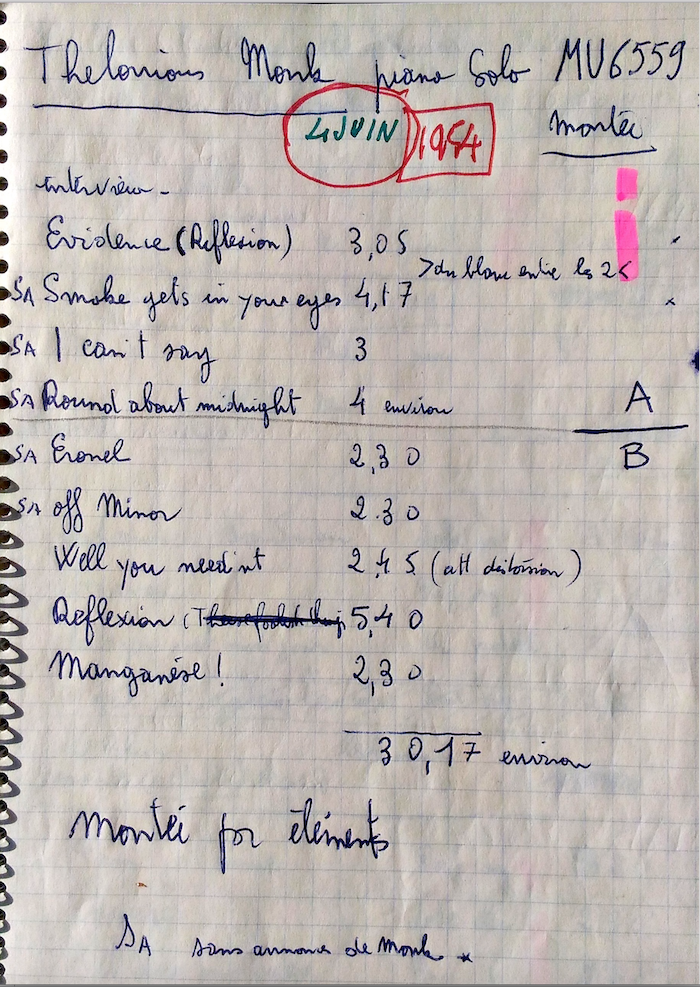
André Francis:
« …l’enregistrement que j’ai fait de Thelonious Monk s’est fait un matin au Club d’Essai, rue de l’Université, un jour ou il y avait la grève du personnel technique, et on m’a annoncé : —Écoutez, il n’y a pas moyen… il n’y aura pas de technicien aujourd’hui, mais voilà la clef du studio, voilà la clef pour prendre les micros, tu te démerdes ». Je n’avais jamais fait de prise de son… c’était un piano unique, donc je savais où il fallait placer les micros… l’argent qu’il avait demandé et qui était très limité a pu lui être donné à la fin de l’enregistrement et il a aussitôt couru avec son accompagnateur pour s’acheter des bérets, des bérets français… ça avait été fait uniquement pour la radio, mais, je lui avais laissé entendre que ça pourrait être commercialisé, et ils ont donné tout naturellement à Vogue une copie de l’enregistrement, à charge à Vogue de payer beaucoup plus que nous nous l’avions payé[•]. [l’accompagnateur] c’était un de mes meilleurs amis, avec lui on avait fondé une association[•]… Marcel Romano… »
André Francis, conversation with François Lê Xuân, Daniel Richard, Alain Tercinet and Fred Thomas, Friday, March 18, 2016, Paris 15. Audio recording.
" ... The recording I made of Thelonious Monk was done one morning at the Club d’Essai, rue de l’Université; it was a day when the technical crews were on strike, and they said to me: ‘Listen, there's no way you can do it... There won't be any technicians today, but here's the key to the studio, and this is the key to get the mikes, you'll have to handle the mess yourself.’ I'd never done a sound take... there was just the one piano, so I knew where the mikes should be... It was possible to give him the money he'd asked for, and it was a very small amount, at the end of the recording, and he immediately ran off with the person accompanying him so that he could buy some berets, French berets... It had been done only for the radio station but, I'd let him know that there might be a chance to sell it, and quite naturally they gave a copy of the recording to Vogue, on condition that Vogue pay him a lot more than we had paid. [The person accompanying him] was one of my best friends, we'd founded an association with him[•]... Marcel Romano…. "
Content of the edited tape (A + B) MU 6559:
AF —Nous avons aujourd’hui le grand plaisir d’avoir dans nos studios, Thelonious Monk qui est appelé le Grand Prêtre du be-bop car il est le créateur, le principal créateur avec Charlie Parker et Dizzy Gillespie, de ce mouvement musical qui a révolutionné l’histoire du jazz. Il est venu dans notre studio et nous allons lui faire subir la petite interview d’usage, et d’abord nous allons lui demander si il est très content d’être à Paris.
TM —Oui.
AF —Eh bien cela nous fait aussi plaisir car il a donné au cours des concerts présentés à la Salle Pleyel de grandes satisfactions musicales aux auditeurs qui se trouvaient dans la salle, une autre question maintenant : est ce que vous êtes très content du public Français devant lequel vous avez joué?
TM —Très bien, très bien, beaucoup!
AF —Quel est le thème que vous allez interpréter?
TM —Je vais jouer pour vous, Reflections [sic].
AF —“Today it's our great pleasure to have in our studios, Thelonious Monk, who they call the High Priest of be-bop as he's the creator, the principal creator with Charlie Parker and Dizzy Gillespie, of this movement in music that has revolutionized the history of jazz. He came down to our studio and we're going to subject him to the usual little interview, and first of all we're going to ask him if he's very happy to be in Paris.
TM —“Oui [Yes].”
AF —“Well, it's a pleasure for us, too, because during these concerts presented at the Salle Pleyel he has given great musical satisfaction to the listeners who were in the room; another question, now: are you very pleased with the French public who you've played for?
TM —“Très bien, très bien, beaucoup! [Note: Monks says, in French, "Very much so, very much, a lot!]”
AF —“What is the name of the tune you are going to play?”
TM —“Je vais jouer pour vous, Reflections [Note: still in French, Monk says, "I’m going to play for you, Reflections [sic]].”
| >Evidence | 3:04 |
| >Smoke Gets in Your Eyes | 3:24 |
| >Hackensack | 3:00 |
| >‘Round Midnight | 5:14 |
| >Eronel | 2:30 |
| >Off Minor | 2:30 |
| TM announces —Well You Needn’t | |
| >Well You Needn’t | 3:24 |
| >Reflections | 5:00 |
| >We See | 2:30 |
No concert at 2:30 p.m. and 5:30 p.m. At 9 p.m., concert “New Orleans.[•]”
Saturday, June 5, 1954
Salle Pleyel, 252, Fg St-Honoré, Paris VIII
Even Paris Match gave space to the event (belatedly):
« L’orchestre de Gerry Mulligan, révélation du jazz américain, est la vedette du Salon du Jazz, organisé du 1er au 7 juin, à la Salle Pleyel…
Autre vedettes : le pianiste Thelonious Monk, surnommé « le grand-prêtre du bop » et Jonah Jones, un des meilleurs trompettes « Nouvelle-Orléans ». Son surnom est « Louis the Second » —Louis Armstrong étant Louis 1er.
Le salon organisé par Charles Delaunay et Jacques Souplet a un décor unique : une rue de la Nouvelle-Orléans (coût : 8 millions)…
Des orchestres sont annoncés de la Haute-Garonne, de Rouen, de Lille, d’Arles, etc. On escompte 50.000 spectateurs en une semaine. Des avions spéciaux ont été affrétés d’Angleterre. Quatre fauteuils pour chacun des dix concerts ont été loués par quatre Hindous fanatiques de jazz. Ils sont venus spécialement de Bombay. »
« Elles et Eux musique : Sans piano ni guitare Gerry Mulligan au Salon du jazz », Paris Match, N° 271, du 5 au 12 juin 1954, p. 79.
"The orchestra of Gerry Mulligan, the revelation in American jazz, is the star of the Jazz Fair organized from June 1st to 7th at Salle Pleyel….
Other stars: the pianist Thelonious Monk, nicknamed ‘the high priest of bop,’ and Jonah Jones, one of the best ‘New Orleans’ trumpeters. His nickname is ‘Louis the Second’—Louis Armstrong being Louis 1st.
The Fair, organized by Charles Delaunay and Jacques Souplet, has a unique setting: a street in New Orleans (cost: 8 Million)….
Bands are announced from the Haute-Garonne, Rouen, Lille, Arles, etc. Some 50,000 spectators are expected in one week. Special flights have been put on from England. Four seats for each of the ten concerts have been reserved by four Hindu jazz fans. They have come specially from Bombay.”
While the weekly radio programme Radio Liberté focused on "this curious pianist”:
« Thelonious Monk a incontestablement de la personnalité. Son introduction de Mysterioso nous plonge dans un climat harmonique qui n’est pas sans faire songer au Bartok des Musiques nocturnes (Jazz Sélection 542). La main gauche établit les fondations, avec lourdeur. Puis la droite se lance dans une trottinantes promenade de souris avec de brusques arrêts malicieux ou anxieux : le chat n’est pas loin.
Thelonious a une manière à lui de jouer avec les harmoniques éloignées de la fondamentale, de décortiquer un air, de l’habiller avec de nouveaux accords qui lui donnent vraiment un drôle d’air. Ainsi écoutez In Walked Bud en pensant à Blue Skies (id. 548).
— Il faut être soi-même, dit Thelonious Monk. Si on essaye d’être différent, on peut tout louper! »
H.-J. D. [Henri-Jacques Dupuy]
« Vous pouvez entendre ces jours-ci au Salon du jazz ce curieux pianiste Thelonious Monk », Radio Liberté, N° 232, du 6 au 12 juin 1954, p. 2.
"There's no denying that Thelonious Monk has personality. His introduction to 'Misterioso' plunges us into a harmonic atmosphere that recalls the Bartok of 'Night Music' (Jazz Sélection 542). The left hand lays the foundations, heavily. Then the right hand launches into steps taken by scurrying mice, with abrupt pauses that are either mischievous or like panic attacks: there's a cat nearby.
Thelonious has his own special way of playing harmonies far from the root note, of dissecting a tune, of clothing an air in new chords that really give it a strange sound. Listen to 'In Walked Bud' while thinking about 'Blue Skies' (id. 548).
—"You have to be yourself," says Thelonious Monk. "If you try to be different you can mess it all up!"
Third concert of Thelonious Monk, “Modern Jazz” concert at 9 p.m., the third of the day after the “Semifinal and Final elimination of the International Tournament of Amateur Jazz Bands 1954” at 2:30 p.m., and the “New Orleans” concert at 5:30 p.m.[•] Thelonious Monk played twice that Saturday evening, probably in trio for the first part, and solo in the second part, during a “spectacular” pianists' competition:
« Le concert du samedi soir nous présenta les émules danois du Mulligan Quartet…
Mais le clou de la soirée fut fourni par la confrontations d’un groupe de huit pianistes comprenant Bernard Peiffer, Martial Solal et Henri Renaud, le pianiste sud-américain Lalo Schifrin, Monk et Mary Lou Williams, auquel se joignirent (au piano) Bob Brookmeyer et Gerry Mulligan, qui se souvenaient de leurs débuts sur cet instrument. Ces mêmes pianistes s’étaient fait entendre séparément au cours de la première partie du concert. »
« Le IIIe Salon International du jazz », Jazz-Hot, N° 90, 20e Année (2e Série), juillet-août, 1954, p. 9.
"The Saturday night concert introduced us to the Danish imitators of the Mulligan Quartet…..
But the star turn of the evening was a group of eight pianists that included Bernard Peiffer, Martial Solal and Henri Renaud, the South American pianist Lalo Schifrin, Monk, and Mary Lou Williams, joined (on piano) by Bob Brookmeyer and Gerry Mulligan, who were remembering their beginnings on this instrument. People had been able to listen to these same pianists separately in the course of the first part of the concert."
Lalo Schifrin remembers:
“In 1954, I was invited to participate in the Paris International Jazz Festival at the Salle Pleyel, representing Argentina. There was an article about it in the Paris Match.[[•],[•]] I remember arriving backstage with my bass player and compatriot, Ricardo Galeazzi.[[•]] I went to my dressing room, which had my name written on the door. To my surprise, once inside I saw and heard none other than Thelonious Monk warming up at the piano, totally oblivious of his surroundings.[[•]]”
Lalo Schifrin with Richard Palmer. Mission Impossible: My Life in Music. Plymouth: Scarecrow Press, 2008, pp. 24, 25.
About the piano “Contest”:
« …en solo, mais tout de suite [les uns après les autres, sans interruption] c’était comme… une…sportive, il fallait suivre la tonalité… fallait jouer quelque chose dans la même tonalité… [Monk] c’est lui qui a commencé… »
Lalo Schiffrin, interview in French with Daniel Richard, Thursday, November 10, 2016, Ministry of Culture and Communication, 3 Rue de Valois, Paris I. Audio recording.
" ...playing solo, but straight away [one after the other without interruption] it was like a ... sporting (event)... you had to stay in tune... we had to play something in the same key... [Monk] he was the one who started..."
Sunday, June 6, 1954
This would have been the fourth concert of Thelonious Monk, the “Modern Jazz” concert at 5:30 p.m. after the “Final of the International Tournament of Amateur Jazz Bands 1954” and before the “New Orleans” one at 9 p.m., [•] but Monk had forgotten and he didn't show up. According to Marcel Romano:
« …pendant toute la semaine où il a été à Paris je venais le chercher presque tous les jours et on allait se promener je ne parlais pratiquement pas, comment dire, pas anglais, mais il y avait un contact qui s’était établi entre nous et comme ça, sympathique, il était venu à la maison, je n’étais pas lavé, on m’avait offert une bouteille de champagne d’une fête foraine je ne sais plus un truc dans ce genre là, alors je lui dis :
—Viens à la maison » il vient à la maison, on débouche la bouteille, on commence à discuter, c’était un dimanche après-midi, et tout-à-coup il me demande l’heure qu’il est, je lui dis :
—Il est cinq heures…
—Ah bon, cinq heures, c’est tard il fallait que je sois à quatre heures, j’ai un concert aujourd’hui » il était comme ça il ne se souciait jamais de l’heure, il avait des engagements et puis au dernier moment il oubliait, il ne s’en rappelait toujours qu’au dernier moment… »
Marcel Romano, conversation with Dominique Cravic, Monday, August 4, 1997, Le Wepler, 14, place de Clichy, Paris 18. Audio recording.
" ...The whole week he was in Paris, I used to go and fetch him almost every day, and we went out walking. I practically didn't... how can I put it, I didn't speak English, but there was something that passed between us, a contact... just like that, he was very friendly, and he came round to my house... I needed a wash... Somebody had given me a bottle of champagne, someone at a fairground or something like that, I don't remember... I'd said to him:
'Come over to my house.’ So he came to my home, we opened the bottle, we started chatting, it was a Sunday afternoon, and all of a sudden he asked me what time it was. I told him:
‘It's five…’
‘Oh yes, that's late, I had to be somewhere at four, I have a concert today.’ That's what he was like, he never paid attention to the time. He'd have bookings and then at the last minute he forgot; he'd only remember things at the last minute…."
Monday, June 7, 1954
Salle Pleyel, 252, Fg St-Honoré, Paris VIII
Fifth and last concert of Thelonious Monk, the “Modern Jazz” concert at 9 p.m. closing the Jazz Fair, and the second concert of the day after the “New Orleans” concert at 5:30 p.m.[•] No accounts have become available.
Unspecified dates
Salle Pleyel, 252, Fg St-Honoré, Paris VIII
So far, we have no way of knowing after which concert Mary Lou Williams introduced Thelonious Monk to Nica de Koeningswarter, nor to which evenings she refers in the following statements:
“I didn’t meet Thelonious ‘til 1954, I flew to Paris and got there just in time for his very first overseas concert. I went backstage afterwards and Mary Lou Williams introduced me to him; that’s how I met him. We hung out for the rest of the time he was there, we had a ball for a week.”
Nica de Koeningswarter in Charlotte Zwerin. Thelonious Monk: Straight, No Chaser. Malpaso Productions, 1988, a documentary.
“Nica remembered the evening quite differently [After summarizing the negative comments already quoted concerning the first concert]. She was enthralled. Monk surpassed all her expectations. In her opinion, the audience was bowled over. ‘He played two tunes—that’s all—and walked off and the audience were really grasped by it,’ she said on tape. ‘In fact they were yelling, “Monk, Monk,” and he didn’t come back but Gerry Mulligan was waiting to play so that was that.’”
Hannah Rothschild. The Baroness: The Search for Nica, the Rebellious Rothschild. London: Hachette Digital, 2012, Kindle location 2291.
Dr. Leo Waldick refers to several concerts (how many, which concerts, all the concerts?), and does not agree with Joachim Berendt (once again)[•]:
„Monk ist ein Phänomen—gleichgültig mit welchen Vorzeichen. Er trägt soviel fremde und ungewohnte Züge daß es sehr schwierig ist, ihn mit gewohnten Maßstäben zu messen, Man glaubt, er sei in einer anderen Welt. Daß er in jedem Konzert zum größten Teil die gleichen Stücke spielte, war allerdings sehr diesseitig. Sein Spiel ruft den Eindruck hervor, als habe er nie anders gespielt und werde auch nie mehr anders spielen. Den Musikern, die ihn begleiten. machte er es schwer. Sie wußten nie. woran sie mit ihm waren. Plötzlich stand er vom Piano auf. ging auf der Bühne spazieren und grinste ins Publikum.— The mad Monk?—Was ihn mir so sympathisch macht, ist der von seinem Spiel ausgehende Zwang zur Entscheidung. Entweder ist er ein Scharlatan, der durch Wahl ungewöhnlicher harmonischer Mitteilung vorbildlose Spielweise seine technischen Mangel zu verdecken sucht, oder aber ein Musiker von außergewöhnlichem Format, der keinen Wert auf technische Brillanz legt; denn eines ist ganz sicher: seine Technik ist mäßig. Mir Persönlich hat er gut gefallen. Die Begründung dafür ist allerdings subjektiv: Ich könnte ihm stundenlang zuhörten.‟
„Aphorismen zum ‚3. Salon international du Jazz‛ by Dr. Leo Waldick,‟ Jazz Podium, 3/7 July 1954, p. 8.
“Monk is a phenomenon—regardless of the signs. He has so many strange and unusual features that it is very difficult to assess him based on usual standards; you would think he was from another world. The fact that, for the most part, he played the same pieces at each concert was, however, very much of this world. His playing creates the impression that he has never played differently, and will never play any different either. He makes it difficult for the musicians who accompany him. They never knew where they were at with him. Suddenly, he stood up from the piano, walked across the stage, and grinned at the audience—The mad Monk?—To me, what makes him so likeable is the compulsion behind the choices he makes, coming from his playing. Either he is a charlatan who chooses unusual harmonic information to conceal a lack of technique, or else he's a musician of exceptional stature who puts no value on technical brilliance; because one thing is quite certain: his technique is moderate. I personally liked him a lot. The reason for this, however, is subjective: I could listen to him for hours.”
Erik Wiedemann shared his impressions and observations on Monk and on French audiences the day after the Salon in the Orkester Journalen, , July 1954.
“Thelonious Monk är ett fenomen, som nog kan sätta ens bedömningsförmåga på ganska vanskliga prov. Hans musik är till den grad egenartad, att den inte kan kristiseras i relation till annan jazzmusik. Hur villrådig blir man inte, när han slår sig ned vid pianot och framtrollar den ena bisarra inén efter den anfra, får sina åhörarre att vrida sig vid skärande, missljudande ackord och slakar om dem med dessa våldsamma och abrupta rytmiska betoningar. Till att börja med kan han verka som en barnunge, som daskar bärgge händerna i klaviaturen på måfå i naiv beundran att kunna frambringa ljud. Kan man verkligen ta denna besynnerliga och uppenbarligen tillfälliga musik på allvar? Men allteftersom man lyssnar på honom wäxer det fram ett system, en bärande idé ur detta synbara kaos och de säregna klangerna och brutalt rytmiska verkningarna börjar få mening och innehåll. Ligger det inte något spotskt och hånfullt grimserande i detta sätt att omstörta alla konventioner? Alla ackord nedbrytas och visar en ilsken, osymmetrisk avigsida. Fullt medvetet undvikes alla vanliga bekväma uttryck och ersättes med vrångbilder av sig själva. Det kan mycket väl vara negerns rasmedvetenhet, som gör front mot den vita rasens intrång på hans musikaliska domäner. I denna avkrok, varifrån han kastar sten mot sina åhörare, härskar han oinskränkt, här kan ingen göra honom rangen stridig. I all sin fåmälda nakenhet rymmer hans musik ett oerhört råstoff, som han själv blott till en del är i stånd att förlösa. Han är mera filosof och skapare än utövare, och hans musik når en via banor, som står utanför det rent pianistiska….
Ovationer för Mulligan
För övrigt utgjorde Gerry Mulligans fortfarande pianolösa kvartett det stora samtalsämnet. Det mottagande, som kvartetten fick av den temperamentsfulla franska publiken, var efter franska förhållanden ganska ovanligt. När man känner till, hur svårt det alltid varit för vita jazzmusiker att göra sig gällande i Frankrike, undrade man över, att medan negerpianisten Monk endast erhöll spridda och blandade bifallsyttringar, så åstadkom Mulligans helt vita kvartett kreftiga och spontana handklappningar. Och ändå så skiljer sig den franska publiken inte mer från andra länders än att Mulligans lättsmälta, eleganta och inte allför djuptgående musik genast vann framgång, under det att Monks särpräglade och minst av allt insmickrande tonspråk ej begreps utan därför endast irriterade publiken….”
“Jazzintryck från Paris av Erik Wiedemann,” Orkesterjournalen, N° 7, juli 1954, pp. 11, 29.
“The music of Thelonious Monk is a phenomenon that makes for a rather difficult test of judgment. It is music that is unique to a degree that has no definite shape in any other jazz music. When he is seated at the piano, how confusing it is to be confronted by that strange profanity that startles his audience, with incisive, dissonant chords releasing their tension in violent, abrupt rhythmic accents. Starting to play, he seemed like a child, randomly slapping the keyboard with his hands as if in naive admiration at being able to produce such sounds. Can this perplexing, evidently unpredictable music really be taken seriously? But when one listens to him, a system emerges, a buoyant idea of this apparent chaos, and the peculiar sounds and brutal rhythmic effects begin to make sense, and take on substance. Isn't it unsettling, this mocking manner of throwing all convention to the winds? The chords are disjointed, showing an angry, asymmetrical reverse side that deliberately avoids any common or comfortable expression, replacing them with ugly images of themselves. Maybe this is the racial awareness of the Negro in the front line of the white race's intrusion into his musical domains. In this backwater, from where he throws stones at his audience, his rule is unlimited; in all its scornful nakedness, his music contains an immense raw material that only he is capable of claiming. He is more philosopher and creator than practitioner, and his music reaches out along paths that are beyond those of the piano alone….
Ovations for Mulligan
Incidentally, Gerry Mulligan's piano-less quartet still formed the main topic of conversation. The reception given to the quartet by the temperamental French audience was, for France, quite unusual. In the knowledge that it has always been difficult for white jazz musicians to assert themselves in the country, one wonders at the fact that, while the Negro pianist Monk received only scattered expressions of mixed acclaim, the completely white quartet of Mulligan aroused spontaneous, powerful applause. And yet the French audience is different from other countries: while Mulligan's easy-to-digest, elegant, and not-too-profound music was an immediate success, Monk's striking language, and expressions that least of all sought approval, were not based on mental concepts and so merely annoyed the audience…..”
Thursday, June 10, 1954
Aéroport d’Orly, Seine
Thelonious Monk returns to the United States[•] after a busy week:
“I enjoyed the visit very much, the only drag was I didn’t have my own band with me. I couldn’t find anybody to play with me that could make it. All the good jazz seems to be in the United States. But I’d like to go back over with my own group.”
“Just Call Him Thelonious.” Thelonious Monk to Nat Hentoff, Down Beat, Vol. 23 N° 15, July 25, 1956, pp. 15, 16.
“HR—Do you remember your first concert in Paris...
TM—Yes, hmm, hmm.
HR—...in 54?
TM—Hmm, hmm, yes I remember that.
HR—I think, at this time your music was a little bit too difficult, too avant garde for the French audience, what do you think of that?
TM—Well I mean they had my... on magazine, they had my picture on front page [laugh], they had Gerry Mulligan, they had [clicking fingers]... Jones... shame I, trumpet player... they had a lot of people, but they had my picture on the front page, if it was too avant garde what it was... I mean whatever it was it seems like I was the star, but the people would come and see... but I wasn't getting the money though.
....
TM—I had no idea, I mean my popularity in France until I got over here, when I got here, I mean they had Gerry Mulligan and treatin' as a star, but they had my picture on front page of the magazine, for the concert, and couldn't get no musicians, I came over my myself, and there was no musician to work with me or anything well then by that no musician work with me I practically had to play by myself. Finally I got some fellas to play with me and I was getting less money than anybody [laugh], that's what happened.
....
HR—Ok, Thelonious, just one, it's the last one, please it's only the last one.... About euh, about piano.
TM—[laugh]The first time I came to France...?
HR—No, no, no, no, no, no, no, we, it's, we don't do that.
TM—The first time I came to France, I was ossified all the time I was here.
HR—No, no, we don't say anything about that to you, ok?
TM—I don't mean everything, it's not secret, is it?
HR—No, but it's not nice.
TM—It's not nice?
HR—Yeah."
From a raw Thelonious Monk's interview by Henri Renaud for Bernard Lion, Henri Renaud Jazz Portrait: Thelonious Monk, ORTF, Studio du Moulin de la Galette, recorded December 1969, released February 12, 1970, a TV show. Thelonious Monk: Live in France 1969. Jazz Icons / Mosaic MDVD-2002, 2011, Bonus Section.
« Monk est resté une bonne huitaine de jours à Paris, et comme j’étais un des rares Français avec qui il pouvait échanger quelques mots en anglais, il me prit en affection et je lui ai servi de mentor pendant tout son séjour… Puis vint le jour de son départ. Je l’ai accompagné avec quelques amis à Orly… »
Jean-Marie Ingrand, correspondance avec François Positif, 1991 in Jacques Ponzio et François Positif. Blue Monk: Un Portrait de Thelonious. Arles: Actes Sud, 1995, pp. 137, 141.
"Monk stayed for a good week in Paris and as I was one of the rare Frenchmen with whom he could exchange a few words in English, he took a liking to me and I served as his guide for the whole stay... and then came the day for him to depart. Along with a few friends I accompanied him to Orly…."
« …je lui ai fait faire le [Jardin du] Luxembourg je l’ai traîné dans tous les endroits où il y avait des étudiants. La plupart des gens se demandaient qui c’était, il y en avait un ou deux qui le connaissaient… un type très curieux, ça aussi ça pourrait faire l’objet d’un article d’une étude, son comportement, l’attitude que nous avions l’un par rapport à l’autre, parce que quand je l’ai revu par la suite très souvent à New York on avait toujours les mêmes genres d’itinéraires de sortie, ce que je lui faisais faire ici, il me le faisait faire à New York, il aimait beaucoup marcher, moi aussi j’aimais beaucoup marcher, il me faisait faire des balades immenses… ici on a fait ça pendant presque toute la semaine, je l’emmenais chez des gens, chez des copains tout ça en discutant, on prenait un verre, moi j’étais pas tellement « couche tard » le maximum c’était minuit et demi, un heure, deux heures, j’allais me coucher parce qu’il fallait que je me lève le matin, mais lui quand je le laissais dans les boîtes, il se couchait vers sept ou huit heure du matin et il était en forme deux ou trois heures après… alors là [quand j’allais me coucher] c’est Urtreger qui le prenait en charge qui le droppait dans toutes les boîtes, il allait sur les Champs-Elysées, au Ringside qui n’était pas encore le Blue Note, ici au Tabou, au Club Saint-Germain, enfin bref…moi je les ai entendu [Mulligan Quartet] presque tous les soirs au Tabou, il n’y a que Monk qui n’aimait pas beaucoup jouer comme ça, d’abord le piano était pourri, il n’aimait que les Steinways il y en avait un au Club Saint-Germain, c’est Bernard Peiffer qui l’avait exigé lorsqu’il était venu jouer… »
Marcel Romano, conversation with Dominique Cravic, Monday, August 4, 1997, Le Wepler, 14, place de Clichy, Paris 18. Audio recording.
"... I took him to see the Luxembourg [Gardens], and dragged him round all the places where there were students. Most of the people wondered who he was, there were one or two who did know... a very odd fellow, and that could be the subject of an article, too, a kind of study of his behaviour, the attitude we had towards each other, because when I saw him again later, very often in New York, we always had the same kind of itinerary when we went out; things that I made him do here, he had me do them in New York. He liked walking a lot, and me too, I really like to walk. He had me take huge walks... Here we did that for almost the whole week, I took him to see people, friends' homes, that kind of thing, all the time deep in discussion. We'd take a drink together, too. I wasn't much of a night-bird, the latest was half-past midnight, one or two in the morning, I went home to bed because I had to get up early, but when I left him in the clubs, he used to go to sleep at seven or eight in the morning and he was fit again after two or three hours... so then [when I went to bed] it was Urtreger who took charge of him, "dropping" him off at all the clubs; he'd go up the Champs-Elysées, to the Ringside, which hadn't yet become the Blue Note, here at the Tabou, at the Club Saint-Germain, you know what I mean... me, I heard them [the Mulligan Quartet] almost every night at the Tabou, there was just Monk who didn't like playing much like that, for one thing, the piano would be lousy... He only liked the Steinways, there was one of them at the Club Saint-Germain, it was Bernard Peiffer who demanded it when he went to play there…."
« …J’avais un scooter à l’époque, oui je l’ai trimbalé en scooter… les gens sur les plateformes d’autobus nous regardaient avec des yeux comme ça! Il était habillé comme en hiver avec un truc en fourrure, et c’était au mois de juin… »
René Urtreger, conversation with Daniel Richard, Sunday, February 26, 2017, Café Le Zimmer, 1, place du Châtelet, Paris 1. Audio recording.
" ...I had a scooter in those days, yes, I carted him around on a scooter... the people standing on the bus platforms used to stare at us with their eyes wide like this... He was dressed for winter, with a kind of fur coat, and we were in June!..."
“In Paris, at the time of the Jazz Fair I described earlier, the English drummer Tony Kinsey collected Monk for a jam session being held at The Ringside. ‘Let’s walk There,’ suggested Kinsey, ‘it’s no more than two hundred yards from here.’ But Monk insisted that went by taxi. He stepped to the kerb, eased his imposing frame into the nearest car and promptly fell asleep. While Kinsey was still deliberating what to do, the owner of the car appeared—it was far from being a taxi—and flew into a typically Gallic rage at the sight of Thelonious there. He reached into the car, grabbed the sleeping figure by the coat lapels and hauled him out on to the pavement. After this Monk avoided all contact with motor vehicles in Paris; he’d walk miles rather than use one.” Tony Kinsey to Raymond Horricks. These Jazzmen of Our Time. London: Victor Gollancz, 1959, pp. 25, 26.
Melody Maker would devote a large amount of space to the Salon in two of its issues, illustrated with photographs by Hervé Derrien:
3rd Salon du Jazz Conclusion
A Financial Failure
Despite "The Enormous Success of the 3rd International Jazz Show” (the title of the editorial in Jazz-Hot, July- August 1954)[•], it failed financially:
« … ça été le dernier Salon car ça c’est terminé par un flop financier, bien qu’il y est eu du monde parait-il à Pleyel, où je n’ai pas mis les pieds… le quartette de Mulligan avait bien marché… Delaunay et Souplet se sont séparés, à la suite d’une dispute, parce que c’est lui qui avait perdu… qui avait engagé de l’argent, et ils en sont restés là dans leur relation et il n’y a plus eu de concerts de Jazz de Paris [Salon] qui les années précédentes (c’était le troisième), avaient eu lieu l’hiver[•], là ils avaient essayé de le faire au printemps, enfin en été, ça n’avait pas marché… »
Marcel Romano, conversation with Dominique Cravic, Monday, August 4, 1997, Le Wepler, 14, place de Clichy, Paris 18. Audio recording.
" ... It was the last Salon because it ended as a by being a financial flop, despite there being a lot of people at Pleyel apparently, I didn't set foot in the place... Mulligan's quartet did well... Delaunay and Souplet went their separate ways after a dispute, because he was the one who lost... the one who'd put money into it, and they left it at that as far as their relationship went; there were no more 'Jazz de Paris' [Salon] concerts which in previous years—this was the third—had taken place in winter[•]... there they'd tried to do it in spring, summer I mean, it didn't work…."
The coverage of the event in Jazz-Hot also was a failure[•].
“Oscar Winners”
Two albums to which Thelonious Monk contributed were released in 1953 and received awards:
“Bird & Diz”
Prix Jazz-Hot 1954[•]:
Blue Star Bird & Diz 10” LP GLP 6939: Bloomdido / My Melancholy Baby / Relaxin' with Lee / Passport / Leap Frog / An Oscar for Treadwell / Mohawk / Visa.
Released January 1953[•].
Blue Star, Charlie Parker and His Orchestra NG 541 : My Melancholy Baby / Bloomdido.
Blue Star, Charlie Parker and His Orchestra NG 544 : Leap Frog / Relaxin' with Lee.
Blue Star, Charlie Parker and His Orchestra NG 545 : An Oscar for Treadwell / Mohawk.
Voici la livraison, en 78 tours, de l’album « Bird and Diz ». Il faut comprendre ces enregistrements comme une manière de « Be-Bop Revival ». C’est Norman Granz qui a eu la bonne idée de réunir le Bird et Dizzy pour reconstituer l’atmosphère et retrouver l’esprit des années 1944-46 qui virent le monde du jazz s’interroger dans la surprise, puis s’engouer pour la nouvelle musique qu’imposaient Parker et Gillespie. Les deux hérauts du be-bop sont ici accompagnés par le père du jazz moderne, l’incroyable Monk. Curly Russell et Buddy Rich complètent le quintette. Bird et Diz ont huit ou dix ans de plus, mais il semble qu’à se trouver réunis ils aient remonté le cours de leur évolution. C’est bien la fameuse équipe des années 44-46 que nous entendons. C’est, dans le dessin des thèmes, dans la fantaisie mélodique et rythmique, dans l’exhumation de codas célèbres, dans l’utilisation fréquente du blues, dans l’invraisemblable aisance des compères, c’est, dis-je (comme écrit Gide), le be-bop, d’illustre mémoire. P.S.— À signaler, ici encore, l’excellente qualité de l’enregistrement.
J. B. H. [Jacques B. Hess]
« Disques », Jazz Hot, N° 87, 20e Année (2e Série), avril 1954, p. 23.
Now we come to the release of the album "Bird and Diz" on 78. You have to take these recordings as a sort of 'Be-Bop Revival.’ It's Norman Granz who's had the good idea of getting the Bird and Dizzy together to reconstitute the atmosphere and recover the spirit of the years 1944-46, which saw the jazz world in quizzical surprise before being infatuated with the new music that Parker and Gillespie imposed. Here Be-bop's two heralds are accompanied by the father of modern jazz, the incredible Monk. Curly Russell and Buddy Rich complete the quintet. Bird and Diz are eight or ten years older, but it seems that finding themselves together has sent them back to the beginning of their development. This is indeed the famous crew of the years '44-'46 that we can hear. This, in the design of the tunes, in their melodic and rhythmical fantasy, in the exhuming of some famous codas, in the frequent use of the blues, in the incredible facility shown by their comrades, this, I say (as Gide put it), is the be-bop of illustrious memory. P.S.— Worthy of note, here again, is the excellent quality of the recording.
Milton Jackson
During the Salon, on Friday, June 4 at 1:30 p.m.[•], the Academy of Jazz held its first ceremony (it was created that year in 1954, with André Hodeir as President.[•] Their “Oscar" for Best Jazz Record of the Year would go to Milton Jackson for "Wizard of the Vibes,” (Vogue LD 138), which also contained music from the session of April 7, 1952, "Milt Jackson Quintet.” Its content benefited from the inclusion of two titles from the "Thelonious Monk Quintet" session dated July 23, 1951—Criss Cross and Eronel—released on 78 rpm under his name (US number Blue Note BN 1590):
Vogue, Milton Jackson Wizard of the Vibes 10” LP LD. 138 : Tahiti / Lillie / Criss Cross / Willow Weep for Me / What’s New / Bags' Groove / On the Scene / Eronel.
Released June 1953[•].
M. Jackson est entouré dans cinq faces par John Lewis (p), Percy Heath (b), Kenny Clarke (dm) et Lou Donaldson (alto) et dans les trois autres par Thelonious Monk (p), Al McKibbon (b), Art Blakey (dm), et Sahib Shihab (alto). C’est une bonne idée d’avoir réunis dans un même album des faces provenant de séances différentes. On a bien fait aussi de détailler le personnel sur l’étiquette, contrairement à de nombreux LP où rien n’est indiqué avec précision.
Dans le cas présent, les accompagnateurs se différencient facilement grâce au style des pianistes et des drummers. Art Blakey accentue les 2e et 4e temps de la mesure avec plus de violence que quiconque. Son jeu de cymbale Charleston le fait immédiatement reconnaître. Et, quoique John Lewis joue de manière moins étrange que Monk, c’est le même esprit qui anime tout le disque tant il est vrai que Lewis—comme Bud, Wallington ou H. Silver—ont puisé à la source du « grand prêtre ».
Ces deux sections fournissent à M. Jackson le soutien rythmique et harmonique idéal pour ses brillantes variations. Ses soli sur tempo lent sont particulièrement réussis. Willow Weep for Me, What’s New et Lillie sont de la veine de son fameux You Go to My Head, qui se passe de commentaires. Notons que ces slows sont entièrement joués en solo par le vibraphoniste qui se lance avec une virtuosité et une souplesse inouïes dans ces longues phrases qu’il aime jouer avec un léger retard. Son inspiration ne faiblit pas un seul instant et il est tout aussi brillant dans les morceaux rapides. Dès qu’il joue, on sent plus le ‘tempo’ (le swing).
Sahib Shihab et Lou Donaldson prennent aussi quelques chorus, le premier connu par ses disques avec Monk et le second, disciple de C. Parker. On peut lui reprocher quelque chose dans sa sonorité mais on apprécie ses idées.
John Lewis et Thelonious jouent aussi en solo et sont toujours égaux à eux-mêmes et originaux. Notons l’accompagnement particulier de J. Lewis qui n’hésite pas à broder derrière le vibraphone soit un contre-chant (What’s New), soit un riff (Bags' Groove).
Milt Jackson « Wizzard of the Vibes » dit l’enveloppe : c’est en effet un magicien de l’instrument que l’on peut ranger aux côtés des plus grands improvisateurs du jazz d’aujourd’hui. Ce disque accentue encore l’envie que nous avons le l’entendre ‘en chair et en os’, chose très prochaine à en croire certains bruits.
J.H. [Ny Renaud aka Jacques Henry]
« Disques », Jazz-Hot, N° 78, 19e Année (2e Série), juin 1953, p. 28.
On five sides M. Jackson is accompanied by John Lewis (p), Percy Heath (b), Kenny Clarke (dm) and Lou Donaldson (alto), and on the three others by Thelonious Monk (p), Al McKibbon (b), Art Blakey (dm) and Sahib Shihab (alto). It's a good idea to have put titles from different sessions together on the one album. It was also well to give details of the personnel on the label, contrary to numerous LPs where nothing is precisely indicated.
In the present case, the accompanists are easily differentiated thanks to the styles of the pianists and drummers. Art Blakey puts the emphasis on the 2nd and 4th beats of the bar with more violence than anyone. His playing on the on the hi-hat makes him immediately recognizable. And even though John Lewis plays less strangely than Monk, it is the same spirit that gives life to the whole record, so true is it that Lewis—like Bud, Wallington or H. Silver—has drawn from the well of the 'high priest'.
These two sections provide M. Jackson with the ideal rhythmical and harmonic support for his brilliant variations. His solos over a slow tempo are particularly successful. Willow Weep for Me, What’s New and Lillie are in the same vein as his famous You Go to My Head, which speaks for itself. Note that these slow pieces are played entirely solo by the vibraphonist, who shows unheard-of virtuosity and flexibility when launching into those long phrases that he likes to play with a slight delay. His inspiration doesn't falter an instant, and he is just as brilliant in the quick numbers. As soon as he plays you can feel the tempo more (the swing).
Sahib Shihab and Lou Donaldson also take a few choruses; the former is knownthanks to his records with Monk, and the second is a disciple of C. Parker. He can be taken to task for something in his sound, but we appreciate his ideas.
John Lewis and Thelonious also play solo and they are always equal to themselves, and original. Note especially the accompaniment of J. Lewis, who doesn't hesitate behind the vibraphone in embroidering either in counterpoint (What’s New) or with a riff (Bags' Groove).
Milt Jackson, "Wizard of the Vibes" says the sleeve: he's indeed a magician with this instrument, one to be placed alongside the greatest improvisers in jazz today. This record accentuates our desire to hear him 'in flesh and blood' even more, and that might be very soon if certain rumours are to be believed."
These two titles were published in France under the name Milton Jackson on two different discs; the third title from the same session, Willow Weep for Me, was published in the US under the name Milt Jackson:
Swing, Milt Jackson and His New Group SW 408 : Willow Weep for Me / Criss Cross
Willow est un solo de vibraphone d’une haute inspiration sur un excellent thème. La musicalité, le son, le swing, les idées, tout y est, Thelonious Monk (p), Al McKibbon (b), Art Blakey apportent à Milt Jackson un soutien parfait.
Pour Criss Cross, un thème de Monk plein d’originalité et de fraîcheur, on trouve en plus l’alto Sahib Shihab, qui prend un excellent solo. La sonorité produite par l’alto, le vibraphone et le piano est très excitante, et là encore le swing dégagé par Art Blakey et McKibbon (sans parler des solistes) est remarquable.
Cette remarquable interprétation et son verso (déjà parus en LP : Wizzard of the Vibes, LD. 138, et précédemment chroniqués) sont un parfait exemple de jazz moderne de première qualité, sans complications inutiles, mais parfaitement efficace.
G.P. [Gérard Pochonet]
« Disques », Jazz-Hot, N° 87, 20e Année (2e Série), avril 1954, p. 27.
'Willow' is a vibraphone solo of lofty inspiration based on an excellent theme. Musicality, sound, swing, ideas, everything is there, with Thelonious Monk (p), Al McKibbon (b) and Art Blakey giving Milt Jackson perfect support.
For 'Criss Cross,’ a Monk tune full of originality and freshness, there's the addition of alto player Sahib Shihab, who plays an excellent solo. The sound produced by the alto, vibraphone and piano is very exciting, and here again the swing produced by Art Blakey and McKibbon (not to mention the soloists) is remarkable.
This noteworthy performance and its reverse side (already released on the LP 'Wizard of the Vibes,’ LD 138, and previously reviewed) are a perfect example of first-rate modern jazz: no useless complications, but perfectly efficient.
Swing, Milton Jackson and His New Group SW 427 : Bags' Groove / Eronel
Milton Jackson (vibes), Lou Donaldson (alto sax), John Lewis (piano), Percy Heath (basse), Kenny Clarke (dms) constituent le « new group » en question. Bags' Groove débute par un riff de quatre mesures répété trois fois comme il convient pour faire un bon morceau de douze mesures—vous connaissez? Soli excellents. Eronel, un thème de monsieur Monk qui peut être qualifié de renversé sinon de renversant, se prête on ne peut mieux au traitement que lui administrent ces messieurs. On entend avec plaisir l’admirable musicien qu’est John Lewis qui joue trop rarement. Le saxo de Donaldson, classiquement parkérien est agréable. Soutien rythmique impeccable, interventions de Kenny très remarquées. Deux très bonnes faces modernes, sans prétention et sympathiques.
M.D. [Michel Delaroche]
« Disques », Jazz-Hot, N° 88, 20e Année (2e Série), mai 1954, p. 26.
Milton Jackson (vibes), Lou Donaldson (alto sax), John Lewis (piano), Percy Heath (bass) and Kenny Clarke (drums) constitute the 'new group' in question. Bags' Groove begins with a riff of four bars repeated three times, quite a suitable way to produce a good twelve-bar piece—mean anything to you? Excellent solos. Eronel, a theme by Mr Monk that you might call reversed if not an upset, lends itself in the best way possible to the treatment that's administered by these gentlemen. It's a pleasure to listen to this admirable musician named John Lewis, who plays all too rarely. The sax of Donaldson, classically Parker-ish, is pleasant. Impeccable rhythmic support, and Kenny's contributions are very noticeable. Two very good, modern sides without pretension, and likeable.
First solo Recording
Thelonious Monk “Piano Solo” Swing M.33.342
And finally, one day …:
« …quelques temps plus tard, qu’est ce que je vois en sortant, je vois un disque Thelonious Monk à Paris, je dis :
—Quoi? c’est pas possible », alors je vais voir Francis, je dis très mécontent, enfin je ne l’engueule pas, mais je lui dis :
—C’est très mal poli, très malhonnête… on lui a promis de faire une séance de radio et tu sors un disque avec ça », il dit :
—Ah non ne t’en fais pas tout est arrangé c’est Cabat, le type de Vogue qui a fait tout ça en toute… en toute… comment dire, légalité, il a téléphoné à Blue Note, il a eu l’accord de Blue Note, enfin bref, le disque est sortie… »
Marcel Romano, conversation with Dominique Cravic, Monday, August 4, 1997, Le Wepler, 14, place de Clichy, Paris 18. Audio recording.
" ...some time later, what do I see when I go out? I see a 'Thelonious Monk in Paris' record, so I say to myself:
‘What? It's not possible.’ So I go and see Francis, and say I'm very displeased, well, I don't shout at him, but I do tell him:
‘It's very impolite, very dishonest... We promised him we'd do a radio session and now you put it out on record!' He says to me:
“Oh, no, don't worry, it's all been arranged. It's Cabat, the guy from Vogue who did all this, it's all... everything's... how can I say, it's all legal, he called Blue Note on the telephone; he's had Blue Note's agreement, I mean, the record has been released…."
Swing, Thelonious Monk LP 25 cm M 33.342 : 'Round about Midnight / Reflections / Smoke Gets in Your Eyes / Well, You Needn’t / Portrait of an Ermit / Manganese / Eronel / Off Minor.
Released April 1955[•].
Il arrive très rarement qu’on puisse louer un disque sans réserves. C’est pourtant le cas ici : ce pianiste, que la publicité a affublé du sobriquet de « grand-prêtre du be-bop », que le public considère avec un amusement mêlé de méfiance, ce « pauvre type » qui malgré l’admiration bien réelle que lui portent des jazzmen tels que Dizzy, Bud Powell, John Lewis et Mary Lou Williams ne parvient qu’à grand peine à vivre de sa musique, ce gars est tellement gonflé d’idées originales qu’on a l’impression avec ce microsillon, d’avoir devant soi le programme musical de dix années à suivre!
Ce disque a précisément la qualité qui fait défaut à la plupart : la substance musicale. Monk n’est pas un charlatan, un marchand de curiosités qui veut « épater le bourgeois ». C’est un musicien aux idées neuves mais au discours parfaitement logique et d’une grande beauté. Les vrais mélomanes ne s’y laissent pas tromper. J’ai eu l’agréable surprise de voir plusieurs personnes peu versées dans le jazz moderne, instinctivement attirées par l’étrange musique de Monk.
Le fait de ne pas être accompagné par une section rythmique—c’est le premier enregistrement en solo de Monk—loin de le gêner, le met encore davantage en valeur. L’attention n’étant pas sollicitée par d’autres musiciens, on goûte encore mieux le jeu de ce grand pianiste. Car si Monk est un véritable puits d’idées et un compositeur de classe, il est en même temps un exécutant au toucher ravissant, doué d’une excellente technique.
Ce disque, dont toutes les interprétations (7 sur 8 sont des compositions de Monk) sont de valeur sensiblement égales, est l’un des plus originaux documents du jazz enregistré—ceci d’autant plus qu’il n’est pas le résultat d’emprunts à des musiques étrangères mais bien le produit d’un des plus grands créateurs du jazz. Nous lui souhaitons bonne réception dans toutes les discothèques.
Al. C. [Alain Courtois]
« Disques », Jazz-Hot, N° 102, 21e Année (2e Série), septembre 1955, p. 43.
It happens very rarely that you can praise a record without any reservations. Yet this is the case here: this pianist, who has been decked out with the nickname 'High Priest of Be-bop' by advertisements, and whom the public considers with a mixture of amusement and wariness, this 'poor guy' who, despite the very real admiration that such jazz people as Dizzy, Bud Powell, John Lewis and Mary Lou Williams have for him, manages to live from his music only with very great difficulty, this guy is so pumped up with original ideas that this LP gives you the impression that you have in front of you the musical programme for the next ten years!
This record has precisely the quality that is lacking in most: musical substance. Monk is no charlatan, no curiosity-salesman wanting to 'shake middle-class attitudes'. He's a musician with new ideas, but one whose discourse has perfect logic, and great beauty. True music-lovers are not being fooled by any of all this. I've had the pleasant surprise of seeing several people with little knowledge of modern jazz be instinctively attracted by Monk's strange music.
The fact that he's not accompanied by a rhythm section—this is the first solo recording by Monk—far from being an embarrassment to him, it flatters him even more. With no other musicians to attract your attention, you can taste the playing of this great pianist even better. Because while Monk is an authentic well of ideas and a composer with class, at the same time he is a player with a delightful touch, and gifted with an excellent technique.
This record, where all the performances (7 of its 8 compositions are by Monk) are equal in worth, and noticeably so, is one of the most original documents of all jazz recordings—all the more so since it is not the result of borrowings from foreign pieces of music, but indeed the product of one of the great creators in jazz. We wish it a warm reception in all record-libraries.
Quietly, while the Gerry Mulligan record was being heavily advertised, the record by Monk, even if it wasn't the subject of an insert in Jazz-Hot, was awarded First Prize by the latter in January 1956[•] for "Thelonious Monk,” Swing 33rpm # 33.342 (the Second Prize was "The Modern Jazz Quartet,” Barclay 33rpm # 84.007). January also saw, at the very least: the first Vogue Blue Note microgroove[•]; the distribution of the Prestige catalogue; and the release in the US of Monk's first Riverside record, "Thelonious Monk Plays the Music of Duke Ellington.”[•]
There is also the fact that 1956 was a decisive turning point for André Hodeir. In the December issue of Jazz-Hot, the three musicians, together with Nat Peck and Michel Fano[•] exchanged views "on the occasion of the release in France of recordings from the Miles Davis session with Thelonious Monk, Milt Jackson, Percy Heath and Kenny Clarke on December 24, 1954[•].” The subject of their exchange was "these two works, one of which at least renews the language of jazz." They discussed "a problem of language renewal and a problem of opposing trends":
« … Nat Peck —Miles, à mon idée, a subi l’influence de Monk… Sa phrase autrefois d’une longueur exceptionnelle (parfois de huit à douze mesures) devient épisodique. En outre, cette phrase qui avait pour grand principe le mouvement conjoint introduit soudain l’intervalle (coda de The Man I Love). En plus Miles et Monk se partagent les honneurs pour une des découvertes les plus frappantes de ce disque : la relation tessiture-attaque-durée.
André Hodeir —Quand vous dites qu’ils utilisent des éléments où il peut y avoir des analogies, l’attaque, etc., vous avez raison, je crois. Mais sur la question de la mélodie disjointe, je ne suis pas tout à fait d’accord, parce que je trouve que Miles joue encore, tout de même, des phrases assez conjointes. D’autre part, quand bien même jouerait-il des phrases disjointes, ce seraient encore des phrases. Monk semble, dans ce disque, c’est ce qui est très important, rompre absolument avec cette notion de phrase. C’est là où il me paraît avoir enfin réussi son œuvre, chose que depuis des années nous attendions. Dans les anciens disques de Monk, il y a des tentatives, mais il n’y a pas cette entrée extraordinaire de ce blues où il semble vraiment imposer silence a son entourage et découvrir un nouveau jazz. Et ce nouveau jazz est possible parce que Monk cesse de jouer des phrases.
Michel Fano —Je dirais même plus : Monk cesse de jouer du piano. L’instrument est complètement détruit, donc la phrase est détruite au profit de l’organisation d’un monde sonore complètement nouveau.
André Hodeir —Une espèce de pensée de discontinuité, et encore le mot n’est pas exact, ce n’est pas vraiment une discontinuité car si l’on écoute bien, on s’aperçoit que chaque chorus est lié au précédent par une idée structurelle. Il se sert des éléments de l’un pour créer le départ du suivant. Donc ce n’est pas vraiment encore de la discontinuité, mais on ne peut pas parler non plus de continuité au sens où précisément Miles Davis, lui, joue des choses tout de même continues. Là, je crois, est la frontière très nette entre les deux ».
« … André Hodeir —… À mon avis, le solo de Monk dans le blues représente une très grande réussite par rapport à tout ce qu’il a fait jusqu’à présent, parce que c’est la première fois qu’il saute vraiment dans l’inconnu, et avec une autorité magistrale. Jusqu’à présent, pour moi, Monk c’était un échec : un homme qui avait des idées, qui cherchait, qui avait une originalité extraordinaire, et qui essayait des choses que personne ne faisait, mais cela avec beaucoup de peine, semblait-il, et sans aboutir à un résultat absolument cohérent sur le plan de l’œuvre. Or, j’ai vraiment le sentiment en écoutant la douzaine de choruses qu’il joue là que c’est une réussite totale ».
« … Nat Peck —Exception faite du solo de Thelonious Monk dans Bags’ Groove qui est réellement sublime, je trouve que certaines réminiscences dans le jeu de Monk, aussi fragmentaires qu’elles soient, contrastent assez fâcheusement avec ses découvertes qui pour être vraiment efficaces exigent une cohérence totale.
André Hodeir —Ça, c’est l’impression générale que j’ai de l’œuvre de Monk. Les rares fois où j’ai osé parler de Monk, j’en ai parlé comme d’un montre faisant une musique encore informe. Précisément ce disque, Bag’s Groove, est très important, car pour la première fois, cela cesse d’être informe pour devenir quelque chose.
Michel Fano —Ce que je crois, c’est que même le ratage partiel de Monk est en tous cas beaucoup plus intéressant que la réussite achevée de Miles Davis… ».
« Miles / Monk : sur deux grandes œuvres du jazz d’aujourd’hui », Jazz-Hot, N° 116, 22e Année (2e Série), décembre 1956, pp. 13-15.
“…Nat Peck —In my view Miles has undergone the influence of Monk… Phrases of his that used to be exceptionally long (sometimes eight to twelve bars) have now become episodic. And in addition, that [type of] phrase, whose great principle is conjunct motion, suddenly introduces an interval (the coda of 'The Man I Love'). Miles and Monk, moreover, share the honours for one of the most striking discoveries on this record: the relationship between tessitura, attack and length.
André Hodeir —When you say that they use elements where there can be analogies, the attack etc., you're right, I think. But on the disjunct music question I don't completely agree because I find that Miles still plays phrases that are conjunct. Again, even if he did play disjunct phrases, they would still be phrases. On this record, Monk—and this is what's really important—, Monk seems to break completely away from this notion of the ‘phrase.’ This is where it seems to me that he has finally succeeded in his work, something for which we've been waiting for years. On Monk's old records there have been attempts, but there isn't that extraordinary entry of the blues where he really seems to impose silence on his entourage, and reveal a new jazz. And that new jazz is possible because Monk stops playing phrases.
Michel Fano —More than that, I'd even say Monk stops playing piano. The instrument is totally destroyed, and so the phrase is destroyed, to the benefit of the organization of a completely new world of sound.
André Hodeir —A sort of discontinuity notion… and even then the word isn't exact: it isn't really a discontinuity, because if you listen carefully you notice each chorus is tied to the previous one by a structural idea. It uses the elements of the former to create the start of the next. So it isn't really discontinuity yet, but you can't say that it is continuity either, in the sense that even Miles Davis himself plays continuous things. That, I think, is the very clear boundary between the two."
“…André Hodeir —… In my opinion, the Monk solo in the blues is a very great success in relation to everything he has done up to the present, because this is the first time he really takes a leap into the unknown, and he does it with the authority of a master. Until now, for me, Monk was a failure: [he was] a man who had ideas, who was searching, who had extraordinary originality, and who tried things that nobody else was doing, but he did it all with a lot of trouble, it seemed, and without arriving at a result that was absolutely coherent when considered as a work. In fact, listening to the dozen or so choruses that he plays here, I really do feel that this is a total success.”
“…Nat Peck —Except for Thelonious Monk's solo on 'Bags’ Groove,’ which is genuinely sublime, I find that some reminiscences in Monk's playing, however fragmentary, contrast rather annoyingly with his discoveries, which, while truly efficient, demand total coherency.
André Hodeir —That’s the general impression that I get from Monk's work. On the rare occasions I have dared to speak about Monk, I've talked about him as if he were some monster making music that still lacked shape. And this 'Bag’s Groove' record, precisely, is very important, because for the first time it ceases to be indefinite, shapeless, and actually becomes a thing."
— Michel Fano: “What I do believe is, even the partial failure of Monk is in any event much more interesting than the accomplished success of Miles Davis…
